
The Man in Seat 61

A beginner's guide to
Train travel in germany.
- Buy train tickets
- Buy ferry tickets
- Book a hotel
- Privacy & cookies
- Home
Train travel UK & Ireland...
Train travel in europe..., train travel in asia..., train travel in africa..., train travel in america..., train travel in australasia, inter-city train tickets from €12.90.
Deutsche Bahn (German Railways) high-speed IC and ICE trains are easily the best way to travel between major town & cities all over Germany, in comfort at ground level. DB's ICE trains travel at up to 186 mph from city centre to city centre, and if you pre-book direct with the operator you can find some really cheap fares.
Train travel within Germany
International trains to & from Germany
Station guides, general train travel information, useful country information, how to check train times & buy tickets.
To check times & prices and to buy tickets in advance go to the German Railways website int.bahn.de ( on a mobile device, use this link ).
Anyone from any country can use bahn.de, all international credit cards accepted, you print your own ticket or can simply show it on your laptop or phone.
Tip: I recommend registering when prompted, so you can log in, check all your bookings and re-print your tickets at any time.
Do you need to book in advance?
When does booking open.
Booking now opens up to 6 months ahead for German domestic tickets.
It was increased to 6 months from the previous 92 days in 2016. However, the booking period is often less than this for dates immediately after the timetable changes at midnight on the 2nd Saturday in December. Bookings for dates after the mid-December timetable change, including the Christmas period, usually open in mid-October.
Flexpreis or Sparpreis?
If you use int.bahn.de to book a long-distance train it initially shows the cheapest fare available against each train.
If you click on that fare, you'll then see a range of fares, Super Sparpreis , Sparpreis & Flexpreis .
Flexpreis is the full-price flexible fare. A Flexpreis ticket can be bought online or at the station on the day of travel, the price in fact varies slightly on different dates, but not by a huge amount. They are refundable, good for any train that day, just hop on and find any empty unreserved seat, seat reservation on long distance IC, ICE & EC trains is optional for a small extra charge, €4.90 in 2nd class, €5.90 in 1st class.
Sparpreis & Super Sparpreis fares are limited-availability advance-purchase fares, from €12.90, €19.90, €29.90, €39.90 and so on, the price varies significantly depending how far ahead you book and how popular that date, day and train is. Spar is German for save . Sparpreis & Super Sparpreis fares only allow travel on the specific train you book, although if your journey involves a connecting regional train you can use any regional train on the regional part of the route. Prices vary like air fares, rising as departure approaches and the cheaper tickets are sold. They disappear a few days before departure, leaving only the Flexpreis fare.
Super Sparpreis = no refunds, no changes. Sparpreis fares are refundable (although for a DB credit voucher, not cash) up to the day before departure with a small fee deducted, no changes or refunds allowed from the day of departure onwards.
- Children go free! On DB trains, children under 6 go free, no ticket needed. Children over 6 but aged under 15 also go free if they travel accompanied by a fare-paying adult, a great offer. Book your tickets at int.bahn.de and it will work all this out for you.
Only one passenger name is needed
Only one name is necessary as I.D. to support a print-at-home ticket, even if that ticket covers several passengers.
If you buy hard copy tickets at a station, no name at all is needed.
Incidentally, until 2016 you had to show the credit/debit card used for the booking when using print-at-home tickets. I'm glad to say that this changed in October 2016, all you now need is a passport or other recognised ID to support a print-at-home online ticket. You may or may not be asked for it by the conductor.
Tips for using int.bahn.de
Stopovers . If you'd like a stopover en route, but still want a cheap saver fare from end to end, no problem. Go to int.bahn.de and enter your start and end point, simply click Stopover , enter the place where you want to stop off, enter the number of hours stopover and off you go. Maximum 2 days validity with a Sparpreis fare.
Alternatives to using bahn.de: Bahn.de is one of the best train operator sites, but if for any reason you want an alternative site which can also book DB trains at DB prices, try these two:
Raileurope.com has a direct connection to DB's ticketing system so it sells the same trains, same prices, same print-at-home tickets at Bahn.de, but with a small booking fee. It accepts all international credit cards so can be used by anyone from any country. Raileurope.com also connects to the French, Italian & Spanish ticketing systems so can easily book multi-operator journeys such as Munich to Naples (which involves DB and Trenitalia) or Frankfurt to Bordeaux (which involves DB and SNCF). Raileurope.com is also capable of splitting the booking to book some cross-Germany journeys (for example, Brussels to Poland) for which you'd have to manually split the booking at some logical point within Germany if you wanted to use bahn.de.
Thetrainline.com also has a connection to DB's system, so can sell print-at-home tickets (but not those which need to be posted) for DB train at the same prices as DB, but with a small booking fee.
Competing lo-cost operator: Flixtrain
Almost all long-distance trains in Germany are operated by Deutsche Bahn (DB), the State-owned German Federal Railways. But there is now one other long-distance operator worth mentioning.
Buy tickets by phone in the UK
If you live in the UK you can buy German train tickets direct from Deutsche Bahn on their English-speaking telesales line, 00 49 (0)30 311 68 29 04 . Lines open 08:30-20:00 Monday-Friday, 09:00-13:00 Saturday & Sunday UK time, 1.5% fee for phone bookings.
Custom-made tours of Germany by train
Railbookers are a train travel specialist who can put together a tour of Germany for you as a package, including rail travel, hotels & transfers. On their website you'll find a range of suggested tours & breaks which can be varied or customised to your own requirements. And as you're booking a package, they'll take care of you if anything happens to one part of the itinerary such as a strike or delay. They now have offices in the UK, USA & Australia.
Tailor Made Rail can arrange tours of Germany by train, they have suggested itineraries or they can organise a trip based on your own requirements, they welcome complex itineraries! As it's a package, they'll take care of you if anything happens on one part of the trip, for example, a national strike. They're TTA-protected - like ATOL, but not only for agencies that sell air travel.
Call their dedicated seat61 phone line 020 3778 1461 and quote seat 61 when booking. From outside the UK call +44 20 3778 1461. Lines open 09:00-17:30 Monday-Friday. Their website is www.tailormaderail.com/destinations/germany .
Back to top
DB's discount card: Bahncard
What are bahncards.
You get the discount on German domestic journeys, and on international journeys to, from or across Germany.
However, for international journeys the discount will not normally be the full 25% or 50% as the reduction is not necessarily applied to the part outside Germany (test it before buying a Bahncard to see what actual effect a Bahncard has - see my top tip below).
Man in Seat 61's top tip: Before buying a Bahncard, run an enquiry for the journeys you actually plan to make, using int.bahn.de (a) as normal and (b) with a Bahncard 25 or Bahncard 50 discount added. See what it does to prices. If you see no difference, the discount may not apply to your particular journey. If you see a difference, do the savings justify the cost of the card?
Types of Bahncard
Each type of Bahncard can be bought for either 2nd class or 1st class.
Check prices & buy a Bahncard
Special regional tickets.
These one-day unlimited travel passes are well worth knowing about, even though they're not valid on fast long-distance trains, only on slower regional trains. If you want a railpass valid on all trains, including high-speed and long-distance ones, see the German Rail Pass section below .
Deutschland ticket
Unlimited travel on regional transport nationwide for €49 a month
From 1 May 2023 Germany offers unlimited travel on regional transport nationwide for €49 per month. This is the successor to the popular (but temporary) €9 ticket created after the pandemic to address the cost-of-living crisis. Unlike the €9 ticket, the Deutschlandticket will be a permanent product.
The Deutschland ticket is good for all regional trains run by DB and by other operators across the whole of Germany ()marked R, RE, RB, IRE or S-Bahn in the timetable) and other types of local & regional transport including local buses, city buses, trams & U-Bahn.
It's even valid on the famous Harz Railway , including steam-hauled trains, but not on the branch line up the Brocken.
It's not valid on long-distance ICE & IC trains or similar long-distance trains classified EuroCity, Eurostar, TGV, Railjet, Westbahn, Flixtrain or Snälltåget. So yes, you could cross Germany with it if you wanted, but only using slower regional trains.
The Deutschland ticket covers journeys wholly within Germany, with a few exceptions: For example, it's valid on cross-border regional trains to/from Salzburg in Austria, to/from Venlo, Arnhem, Hengelo & Enschede in the Netherlands, to/from Basel Bad Bf & Basel SBB in Switzerland, and to/from Zgorzelec in Poland. But remember, only on the regional trains (marked R, RE, RB, BRB and so on), not EC, RJ, RJX, IC or ICE long-distance trains or privately-run Westbahn (WB) trains.
It's valid from the 1st of the month to the end of the month : Unlike normal passes or season ticket which can start on any date you choose, each month's Deutschland ticket is valid from the 1st of the month to the last day of the month. So if you bought one on 30 May, that would be a 'May' Deutschland ticket valid from 1 to 31 May and you'd only get 2 days use out of it, 30 & 31 May - but it would still cost €49!
Only sold as a rolling monthly subscription : It's aimed at commuters not tourists, so the Deutschland ticket is only sold as a rolling monthly subscription or one-off annual payment. However, you can cancel the monthly subscription it at any time, even after paying for only 1 month, just be aware that most vendors require you to cancel before the 10th of the month to avoid paying for the following month's €49 Deutschland ticket. Most vendors require payment by direct debit, a few allow payment by credit card.
Children : As it's aimed at commuters, there's no child version and no provision to add children to your account. However, a child can travel on an adult ticket (just not the other way around). If you want to buy Deutschland tickets for yourself and your children, use RMVgo app at sites.rmv.de/en/deutschlandticket , the Rhein-Main Lander, because this (unlike other Landers' apps) allows one person to open an account and buy Deutschland tickets for multiple people including children, with a credit card in one transaction. The catch? It may not accept non-German addresses, my correspondent had to use the address of his German hotel but successfully bought tickets for himself and his kids. Feedback would be appreciated .
If you only want a Deutschland ticket for one month to enjoy a one month's unlimited travel on regional trains across Germany, buy a Deutschland ticket before the 10th of that month by setting up a monthly credit card payment. Then make sure you cancel the subscription before the 10th of that same month to avoid paying for the following month.
How to buy a Deutschland ticket:
Don't bother trying to use the German Railways (DB) website www.bahn.com to buy a Deutschland ticket as it only accepts payment by direct debit and setting up a direct debit with a non-German bank account results in an error message. #fail!
The easiest way for foreign visitors to buy a Deutschland ticket is to buy from Bremen area transit authority VBN using their FahrPlaner app because (a) it accepts payment by credit card, (b) it's in English, and (c) it has no problem with overseas users, overseas addresses or UK postcodes. #result!
Step 1, download the FahrPlaner app for iPhone or MFahrPlaner app for Android (please let me know if those links stop working).
Step 2, the app should open in English. Click the menu icon top left and go to Tickets . Then select Deutschlandticket.
Step 3, click the red PROCEED TO LOGIN button at the bottom. Then click Sign up for free and register, it lists most countries including United Kingdom and United States and has no problem with UK postcodes.
Step 4, select Credit Card and buy your Deutschland ticket.
This is a rolling subscription which you can cancel at any time.
You show the Deutschland Ticket as a QR code in the app on your phone. Easy!
If you only want one Deutschland ticket for one month, buy it before the 10th of the month then cancel your subscription also before the 10th of the month. That prevents payment being taken for the following month.
To cancel the subscription, you must open the order confirmation email they sent you when you bought it and click on the cancellation link. You cannot cancel your subscription from the app.
If you have children, you'll need to use the RMVgo app instead, see the paragraph about children above.
Quer-durchs-Land-Ticket
Unlimited regional off-peak train travel, €46.
The Quer-durchs-Land-Ticket ( Day Ticket for Germany ) gives a day's unlimited travel from 09:00 weekdays or from 00:00 Saturdays & Sundays, until 03:00 the following morning on all regional & regional-express trains (RE, RB, IRE, S-Bahn) throughout the whole of Germany.
The first traveller pays €46, each additional passenger pays just €9 to be added to the same ticket, up to a maximum total of 5 passengers.
You can't use fast IC, ICE or EC trains, only slower regional trains, so a long-distance journey which could be made on a fast direct IC or ICE train could be very slow and involve several changes if made using purely regional trains. But it can be a very cheap way to go, especially if you haven't been able to book a cheap advance-purchase ticket for an ICE or IC train.
For more information, see int.bahn.de/en/offers/regional/day-ticket-germany .
To buy a ticket online and print it out yourself, see int.bahn.de/en/offers/regional/day-ticket-germany .
Alternatively, these tickets can be bought on the day of travel from the self-service ticket machines at German stations, although it costs €2 more if you buy from a staffed counter.
Lander tickets
Bayern ticket, schönes-wochenende-ticket : discontinued, railpasses for germany, interrail germany pass: click to check prices & buy online, german rail pass, maps of the german rail network, what are german trains like , intercity express (ice).
InterCity Express high-speed trains, usually known as ICE, are German Railways' front-rank trains, travelling at up to 200 km/h (186 mph, ICE3), 280 km/h (175 mph, ICE1 & ICE2) or 250 km/h (155 mph, ICE4). They have 1st & 2nd class, a restaurant car, power sockets at all seats & free WiFi. More about ICE trains .
InterCity trains (IC)
InterCity trains travel at up to 200 km/h (125 mph), usually using a locomotive and conventional carriages. Some InterCity trains cross borders into neighbouring countries and these may be classified EuroCity (EC) rather than InterCity. Power sockets at all seats, and usually some sort of refreshment service. More about IC trains .
A German Intercity train at Amsterdam Centraal .
2nd class seating on an Intercity train. Larger photo .
Regional trains
Regional trains are shown as R, RB, RE and so on, where RE is a faster regional express. Some are operated by Deutsche Bahn (DB, German Railways), others are outsourced to private operators such as Abellio, Metronom, Erixx, but still run as part of the national network with tickets sold by DB at int.bahn.de . They come in many different shapes and sizes, some single-deck, some double-deck. No catering, so bring your own food & drink. No seat reservation necessary or possible, you sit where you like.
Sleeper trains
There are several German domestic routes where a sleeper is an option. These are now run by ÖBB (Austrian Railways) and branded Nightjet:
Düsseldorf, Cologne, Koblenz < > Munich, see the Nightjet page .
Hamburg, Hannover < > Munich, see the Nightjet New Generation page .
Seat numbering plans : Click here
Travel tips.
Language problems?
First-time visitors often think this will be a problem, but it hardly ever is. At stations, signs are usually in English as well as German, or they use easy-to-understand pictograms. On-train announcements on long-distance trains are often made in English as well as German.
Food & drink on German trains
Most long-distance trains have at least a bistro car serving tea, coffee, wine, beer & snacks from a counter, with some tables nearby if you'd want to eat and drink in the bistro car rather than take it back to your seat. See sample ICE bistro menu . Many German long-distance trains have a proper sit-down waiter-service restaurant car. In first class on ICE you'll often be asked if you want to order food or drink, and it will be brought and served at your seat.
Alternatively, feel free to bring your own food and drink (even a bottle of wine, if you like) onto the train, there's no rules against that on the rails.
Luggage on trains
There are no baggage fees or weight limits, and you don't check your bags in, you simply take them with you onto the train, placing them on the racks at the end of each car or amongst the seats, or above your head. It's usually possible to keep all your bags in sight. More about luggage on trains .
Should you reserve a seat or not?
Reserving a seat is optional on most German trains. You can add a reserved seat to your booking for €4.90 in 2nd class, €5.90 in 1st class.
If you don't reserve, you simply sit in any empty unreserved seat. Small LED displays above each seat show which seats are reserved between which stations, and which seats are free. Travelling alone, middle of the day, mid-week in February, you'll have plenty of seats to choose from. But a family group, travelling on a Friday afternoon in July would be well advised to reserve seats. And for any long journey it's best to be on the safe side and reserve.
You can make a seat reservation separately (i.e. after buying your ticket) by going to int.bahn.de , clicking in the from or to field to open the parameters panel, set up an enquiry and run it by clicking Book seat only .
On the seat reservation display for each seat:
ggf. reserviert - this means the train's on-board reservation system hasn't been updated with the latest information from the main DB reservation system. Usually all of the seats show this message if this happens. Seat reservations are still valid, but cannot be shown on the LED displays, so you can sit in these seats but you could be asked to move if someone shows up with a reservation.
ggf. freigeben - this is a last-minute reservation seat. You can sit in it if you like, but will have to move if someone shows up with a reservation.
bahn.comfort - travellers holding a frequent traveller BahnCard have priority for these seats. You can sit in these seats but someone with a BahnCard may show up and claim it. Though how they'd know you didn't have a BahnCard and so ask you to move is another question!
Schwerbehinderte means that seat is reserved for people with disabilities.
First class lounges at stations
There are lounges for holders of certain types of first class ticket at Berlin, Bremen, Dresden, Düsseldorf, Frankfurt am Main, Frankfurt Main Airport, Hamburg, Hanover, Cologne, Leipzig, Mannheim, Munich, Nuremberg, Stuttgart. Follow the signs to the DB Lounge . They're typically open 07:00-21:00 daily, search int.bahn.de for details. The lounges offer complimentary tea, coffee, soft drinks, beer & snacks. Unfortunately, only holders of expensive 1st class Flexpreis tickets get lounge access, you don't get access with 1st class Sparpreis or Super Sparpreis fares or 1st class Interrail or Eurail passes.
Left luggage at stations
All German stations except the smallest have left-luggage lockers in various sizes, up to suitcase-sized. More information on left luggage lockers & prices .
Bikes can be carried on all German trains if semi-dismantled & placed in a bike bag, they then travel as ordinary luggage.
Undismantled bikes are carried on most suburban & regional trains, you need a Bicycle Day Ticket ( Fahrradtageskarte ) which you can buy online at int.bahn.de (use the site search to find it) or at stations for a few euros.
Undismantled bikes are also carried on most InterCity trains , ICE-T & ICE4 trains for a fee as these have been fitted with bike racks, prior reservation required. Undismantled bicycles are not carried on high-speed ICE trains other than ICE-T & ICE4 .
To find a train that takes bikes, go to int.bahn.de , click in the from field to open the details panel and select Bicycle transport possible .
To book yourself and your bike on a train in Germany, go to int.bahn.de , click in the from field to open the details panel, click on Passenger, bicycles and add a bicycle to the booking. For more information, see the bicycles by train page .
Dogs & pets
Dogs can be taken on all German trains, sometimes free, sometimes for a small fee. For more information, see the dogs & pets page .
Places not served by the main rail network
Neuschwanstein, Germany's fairytale castle: See details here .
Eagles's Nest: See details here .
Take a good guidebook. For independent travel, the best guidebook is either the Lonely Planet or Rough Guide. Both guidebooks provide an excellent level of practical information and historical and cultural background. You won't regret buying one!
Buy in the UK from Amazon.co.uk
Or buy in the usa from amazon.com.
Or buy the Lonely Planets from the Lonely Planet website , with shipping worldwide. Alternatively, you can download just the chapters or areas you need in .PDF format from the Lonely Planet Website , from around £2.99 or US$4.95 a chapter.
Tours of Germany by train
Railbookers, railbookers.co.uk.
If you want to tour Germany by train, with all your train reservations and hotels sorted for you, contact rail travel specialists Railbookers and they'll create the best rail holiday for you, hassle-free. They take good care of their clients and get a lot of repeat business. They have offices in the UK, USA & Australia.
Tailor Made Rail, tailormaderail.com
Tailor Made Rail can arrange tours of Germany by train based on your own requirements, they welcome complex itineraries. As it's a package, they'll take care of you if anything happens on one part of the trip, for example, a national strike. They're TTA-protected - like ATOL, but not only for agencies that sell air travel.
Recommended hotels
Here are my suggested hotels conveniently located for arrival by train in key German cities, all with good or great reviews. You are unlikely to be disappointed by any hotel scoring over 8.0 out of 10 on Booking.com .
In Frankfurt
If you walk out of Hamburg Hbf's main eastern exit, you'll find a row of good hotels lined up in front of you on the opposite side of the Kirchenallee. The pick of these is the excellent 4-star Hotel Reichshof Hamburg , across the road and to the left with art deco-based design and great reviews. It has its own restaurant for lunch or dinner, although I'd still be tempted to try the beer & traditional German food at Nagel's bar, 150m south along the Kircheallee, restaurant-kneipe-hamburg.de .
The Hotel Europaischer Hof is another good choice and directly in front of you across the road when you walk out of the station. Other hotels next to Hamburg Hbf with good reviews include the 5-star Hotel Continental Novum (to the right of the Europaischer), Hotel Furst Bismarck (to the right of the Continental Novum), and the Hotel Atlantic Kempinski .
If you'd prefer a hotel right in the city centre, the Henri Hotel Hamburg Downtown is 5 minutes walk from the station on the city side, and gets really great reviews.
If you're on a budget, private rooms in the A&O Hotel start at around £33 for one person or £49 for two people booked at www.hostelworld.com . The A&O is an 11-minute 900m walk south of Hamburg Hbf, see walking map . Also try the innovative Cab20 capsule hotel , a 550m 6-minute walk from the station, see walking map .
Affordable hotels right next to Munich Hbf with good or great reviews include the reliable Eden Hotel Wolff or the NH Collection München , both directly across the road from the station's north side exit, ideal for an overnight stop between trains. I've used the Hotel Wolff myself.
Also consider the more upmarket 25 Hours Hotel The Royal Bavarian , Excelsior by Giesel or Mercure München City Center , all a stone's throw from the station with great reviews.
If you want to push the boat out, the luxurious 5-star Sofitel Munich Beyerpost is right outside the station's south side exit, located in the former Royal Bavarian Post Office building dating from 1896-1900. It comes complete with a spa with massage service and sauna.
If you're on a budget, the Wombat's Hostel Munich is close to the station's south side exit with private rooms & dorm beds, with good reviews.
Booking.com for hotels
I generally use Booking.com for hotels for 3 reasons:
(1) It keeps all my hotel bookings together in one place;
(2) I've come to trust Booking.com 's review scores;
(3) Booking.com usually offers a clearly-marked Free cancellation option.
Free cancellation means you can secure hotels risk-free even before trains open for booking, and if necessary change those bookings if your plans evolve.
If I'm only staying a night or two, I look for a hotel near the station to make arrival & departure easy. You can enter the station name (e.g. Berlin Hbf ) as search location. If staying longer, I look for a hotel close to the sights, entering the name of a city attraction as the search location, then using map view.
AirBnB: Airbnb.com
www.airbnb.com began in 2008 when two designers who had space to share hosted three travellers looking for a place to stay. AirBnB is a platform which connects hosts with guests, so you can now book a room in people's homes, or an apartment, flat or house which people want to rent out. It can be nicer than a hostel, cheaper than many hotels.
Backpacker hostels: Hostelworld.com
www.hostelworld.com : If you're on a tight budget, don't forget about backpacker hostels. Hostelworld offers online booking of cheap private rooms or dorm beds in backpacker hostels in Paris and most other European cities at rock-bottom prices.
Travel insurance & other tips
Always take out travel insurance.
You should take out travel insurance with at least £1m or preferably £5m medical cover from a reliable insurer. It should cover trip cancellation and loss of cash & belongings up to a reasonable limit. These days, check you're covered for covid-19-related issues, and use an insurer whose cover isn't invalidated by well-meant but excessive Foreign Office travel advice against non-essential travel. An annual policy is usually cheapest even for just 2 or 3 trips a year, I have an annual policy with Staysure.co.uk myself. Don't expect travel insurance to bail you out of every missed connection, see the advice on missed connections here . Here are some suggested insurers, I get a little commission if you buy through these links, feedback always welcome.
Get an eSIM with mobile data package
Don't rely on WiFi, download an eSIM with a European mobile data package and stay connected. Most newer mobile phones can download a virtual SIM including iPhone 11 & later, see device compatibility list . There's no need to buy a physical SIM card! Maya.net is a reliable eSIM data retailer with a 4.5 out of 5 Trustpilot rating and a range of packages including unlimited data .
Get a Curve card for foreign travel
Most banks give you a poor exchange rate then add a foreign transaction fee on top. A Curve MasterCard means no foreign transaction fees and gives you the mid-market exchange rate, at least up to a certain limit, £500 per month as I write this. The money you spend on your Curve card goes straight onto one of your existing debit or credit cards. And you can get a Curve card for free.
How it works: 1. Download the Curve app for iPhone or Android . 2. Enter your details & they'll send you a Curve MasterCard - they send to the UK and most European addresses. 3. Link your existing credit & debit cards to the app, you can link up to two cards with the free version of Curve, I link my normal debit card and my normal credit card. 4. Now use the Curve MasterCard to buy things online or in person or take cash from ATMs, exactly like a normal MasterCard. Curve does the currency conversion and puts the balance in your own currency onto whichever debit or credit card is currently selected in the Curve app. You can even change your mind about which card it goes onto, within 14 days of the transaction.
I have a Curve Blue card myself, it means I can buy a coffee on a foreign station on a card without being stung by fees and lousy exchange rates, just by tapping the Curve card on their card reader. The money goes through Curve to my normal debit card and is taken directly from my account (in fact I have the Curve card set up as payment card on Apple Pay on my iPhone, so can double-click my phone, let it do Face ID then tap the reader with the phone - even easier than getting a card out). I get a little commission if you sign up to Curve, but I recommend it here because I think it's great. See details, download the app and get a Curve card , they'll give you £5 cashback through that link.
Get a VPN for safe browsing. Why you need a VPN
When travelling you may use free public WiFi which is often insecure. A VPN encrypts your connection so it's always secure, even on unsecured WiFi. It also means you can select the geographic location of the IP address you browse with, to get around geoblocking which a surprising number of websites apply. See VPNs & why you need one explained . ExpressVPN is a best buy with a 4.7 out of 5 Trustpilot ranking which I use myself - I've signed up as an ExpressVPN affiliate, and if you go with expressvpn.com using this link you should see a special deal, 3 months free with an annual subscription. I also get some commission to help support this site.
Carry an Anker powerbank
Tickets, reservations, hotel bookings and Interrail or Eurail passes are often now held on your mobile phone. You daren't let it run out of power, and you can't always rely on the phone's internal battery or on being near a power outlet. I always carry an Anker powerbank which can recharge my phone several times over. Buy from Amazon.co.uk or Buy from Amazon.com .
Touring cities? Use hill walking shoes!
One of the best things I've done is swap my normal shoes for hill-walking shoes, in my case from Scarpa. They're intended for hiking across the Pennines not wandering around Florence, but the support and cushioning for hiking works equally well when you're on your feet all day exploring foreign cities. My feet used to give out first and limit my day, now the rest of me gives up before they do!
Back to home page
Travel Europe on a Budget
The Savvy Backpacker
City Guides .\33 a132798-3f3b-4585-954d-7e70cf863447{fill:#231f20}
Germany train guide – how to travel germany by train.
How to travel Germany by train — tips for buying German train tickets and advice for navigating Germany by rail.
Transportation
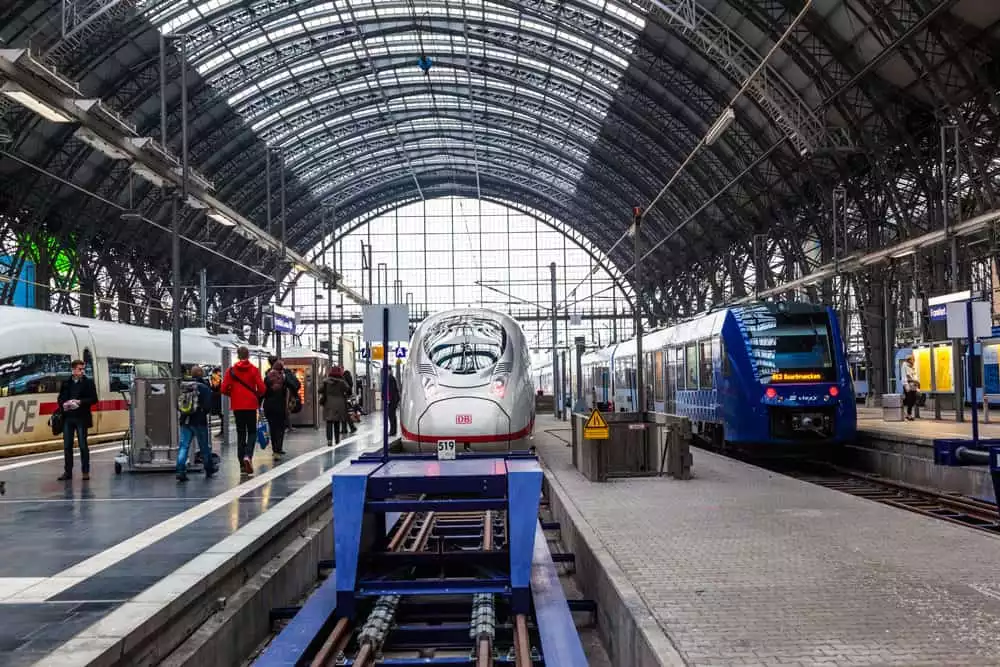
Germany has one of Europe’s greatest rail networks. The trains are fast, frequent, and famous for being punctual. As an added bonus, it’s very easy to book German train tickets online no matter where you’re from. So keep reading because in this Germany Train Guide we’ll cover everything you need to know about traveling through Germany by train—from navigating the system to buying train tickets for the cheapest price.
How To Buy German Train Tickets
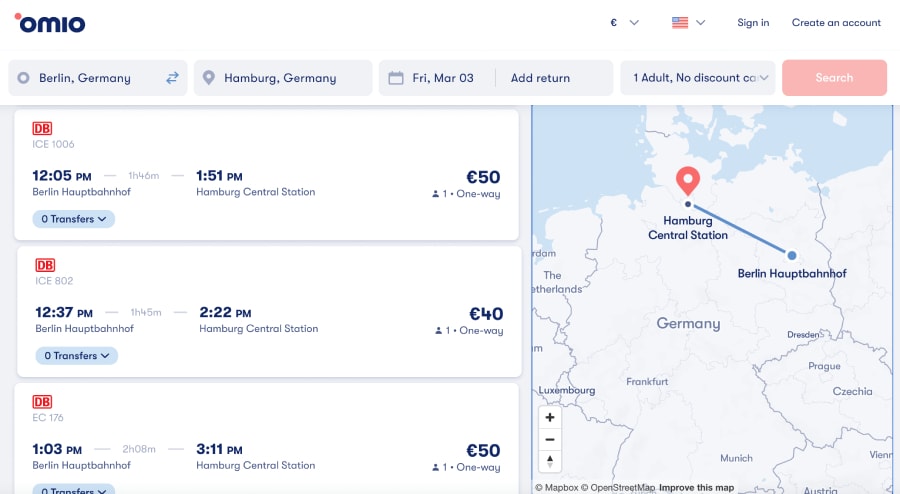
Buying German train tickets is fairly painless since Germany’s rail system’s website is logical and it accepts payments from international credit cards without any hassle. There are also other ways to save (booking early, special tickets, etc.) that we’ll cover below.
Travel Tip: Most train tickets in Germany are now electronic so having reliable high-speed data for your phone is super helpful when traveling by train. Here are a few articles I’ve written to help you get cheap mobile data in Germany: Guide To Mobile Data Plans and Smartphone Phones in Europe , and How To Buy A SIM Card and Mobile Data Plans in Europe .
Where To Buy German Train Tickets
Here are a few places to buy train tickets:
Omio (Recommended)
Omio is a search engine that lets you compare and book trains anywhere in Europe. It allows you easily book tickets with your credit card at essentially the same prices as the Deutsche Bahn website — there is a very small service charge.
Additionally, Omio searches routes for multiple rail services across Europe so it’s great for international trips (since it can easily combine rail journeys of multiple countries).
Train tickets sold via Omio are electronic—simply show the conductor the ticket on your phone (you can also print the ticket if you wish).
TrainLine (Recommended)
TrainLine is another third-party booking site that connects directly to Germany’s National Rail Network and it gives you the same prices you’d find there. They also take international credit card payments without any hassle.
Additionally, it searches routes for multiple rail services across Europe so it’s great for international trips (since it can easily combine rail journeys of multiple countries).
Train tickets sold via TrainLine are electronic — simply show the conductor the ticket on your phone (you can also print the ticket if you wish).
Buying German Train Tickets via Deutsche Bahn—aka the German Rail System
You can buy German train tickets directly through Germany’s national rail system — Deutsche Bahn (www.bahn.de). It accepts most international credit cards and tickets can be sent to you electronically or printed at home.
While rare, sometimes you might encounter some translation issues when using Deutsche Bahn—which is why I prefer using Omio or TrainLine .
NOTE: German train tickets can be purchased about six months in advance.
Buying German Train Tickets At The Train Station
You always have the option to buy your train tickets from any train station in Germany. Every train station will have automated ticket machines and ticket windows. All the machines have an English-language option and most employees staffing the ticket windows will speak English.
DO I NEED TO BUY GERMAN TRAIN TICKETS IN ADVANCE?

Long-Distance Trains
Yes. For high-speed/long-distance trains in Germany, you should book early to get the best price—fares rise as the departure date approaches. For example, a ticket purchased on the day of travel can cost 3x-4x the price as one bought a month or two in advance.
These high-speed trains include InterCity Express (ICE), ICE Sprinter, InterCity (IC), Eurocity (EC).

Regional Trains
No. These trains have a fixed price based on the distance traveled. Simply show up at the station, buy your ticket, and hop on the train. These trains are obviously slower and you’ll have more connections. However, you can book them via the Omio or TrainLine app simply for the convenience of not needing to buy them at the station.
Types of German Train Tickets
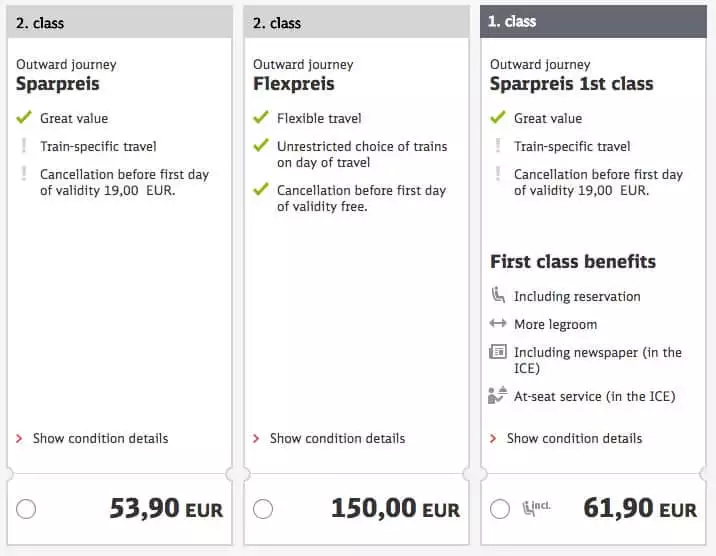
There are two standard ticket types:
- Sparpreis: Sparpreis is a budget ticket that’s valid for a specific route (i.e. it’s not flexible). There is also a first-class version that has the same limitations but you get a few extra perks like nicer seats, more legroom, and access to a nice lounge in large stations — sometimes the first-class and second-class tickets are virtually the same prices so treat yo self.
- Flexpreis: The Flexpreis is a full-price ticket but it offers a lot more flexibility — it’s valid on any train of the day and you can cancel the ticket before the day of travel. It’s also a lot more expensive.
HOW TO COLLECT YOUR TRAIN TICKETS
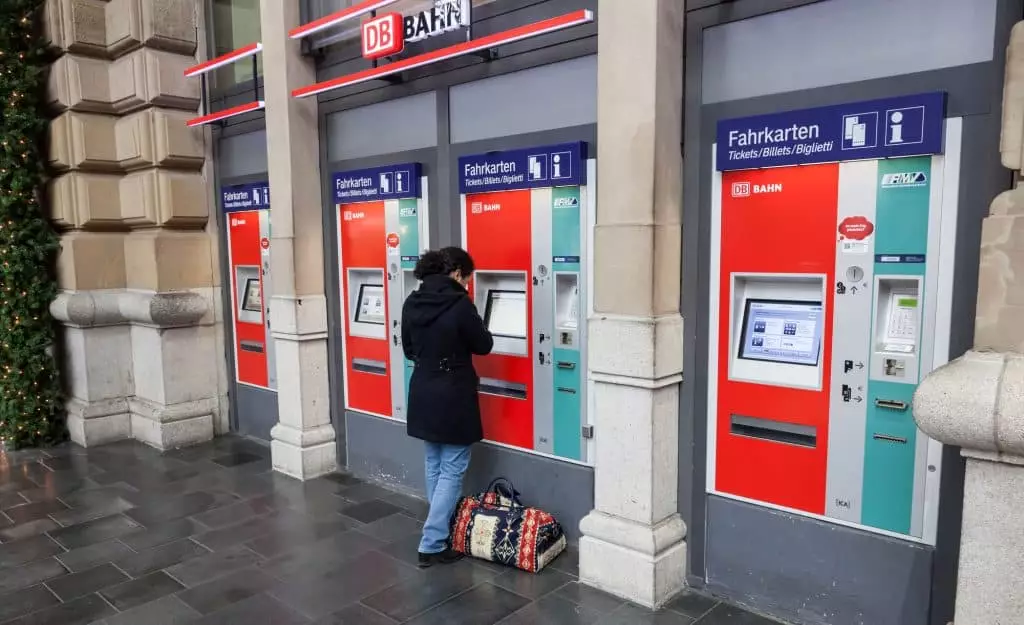
All digital and printed tickets have a QR code that the conductor will scan when they check tickets on the train. It’s super easy.
- Digital Tickets: You can download the ticket as a PDF and save it to your smartphone, tablet, or laptop. This is the easiest way.
- Print: You can also print the PDF.
- DB Navigator App: You can have the ticket loaded to your DB Navigator app.
- Print at the Station: Most of the time you can print your ticket at the station. You’ll be given a code that you type into the ticket machine and it will print there. You can also go to the customer service counter.
- By Mail: Yes, you can get printed tickets mailed to you at an extra cost — I think it’s around €5 and takes a while to arrive.
Tips For Using German Trains
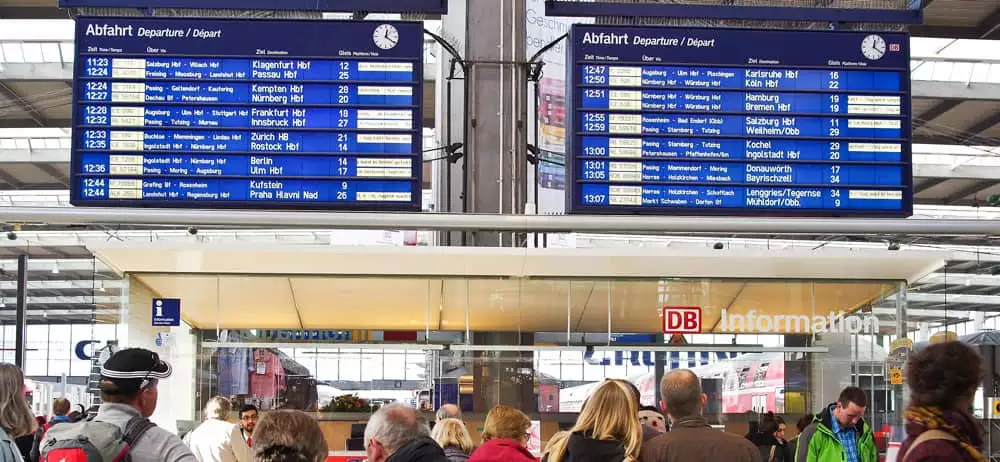
First, we recommend getting to the train station about 20 minutes early so you can find your train platform in plenty of time — by the way, there is no check-in… you simply get on the train. Most are easy to navigate but it’s best to play it safe. Also, if you’re printing a ticket at the station you should leave more time because there can be lines to use the machines.
Once you have your tickets sorted, look at the departure board. This will tell you where to find your train. Pay attention to the board as the platform can sometimes change. Don’t worry if you don’t see your train on the board because they may not list it until it’s closer to departure time.
After you’ve found the platform, use the signs in the station to locate the train. Almost everything should be in English and most Germans speak excellent English.
When the train pulls you’ll want to find your correct car if you have assigned seats (if not, just sit in any non-reserved seat). Each train car will have a number on it so it’s easier to find the car while outside the train than to walk through the train to get to your car. From here, all you gotta do is find your seat.
There is plenty of luggage storage on the train—both above/behind the seats and in the luggage racks at the end of the cars.
Eventually, the conductor will come by to check your tickets.
Rail Passes for Germany
Another great thing about German train travel is that rail passes can actually be a pretty good deal. That’s because they don’t require rail pass users to make reservations — even on the expensive high-speed trains (the exception is overnight trains). So all you gotta do is hop on any train and go.
Check out Eurail.com for the various rail pass options.
Eurail Pass Vs Single Tickets: What’s Cheaper?
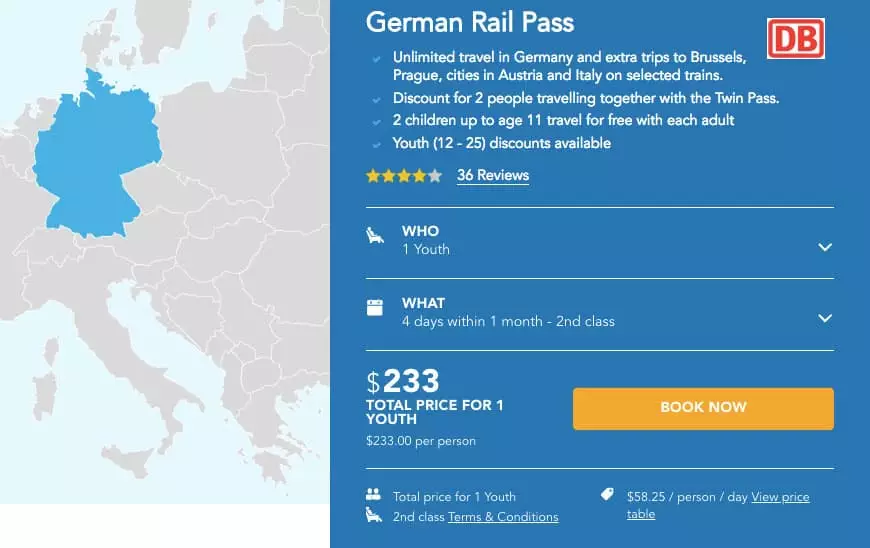
So what’s a better deal—a Eurail pass or single tickets. Well, it depends…
First, you need to look at the per day/per ride cost of the pass — i.e. divide the total cost of the pass by the number of rides it gives you. If you go to Eurail they do a pretty good job of breaking down the per-day price. So, in the image above, a pass that gives four travel days in a month costs $58 (€50) per travel day.
From here you need to estimate how much a single ticket would cost.
The price of a single ticket will vary greatly based on when you buy it and the travel distance. So let’s take a look at a Munich to Berlin ticket.
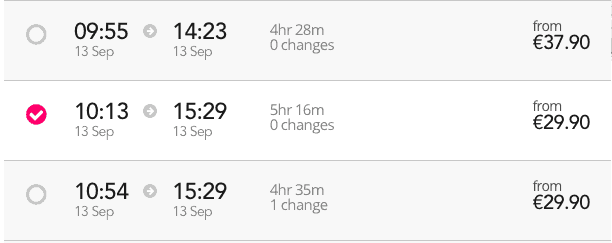
If you buy this ticket four months in advance the price is around €30-€40. So this is quite a bit cheaper than the pass.
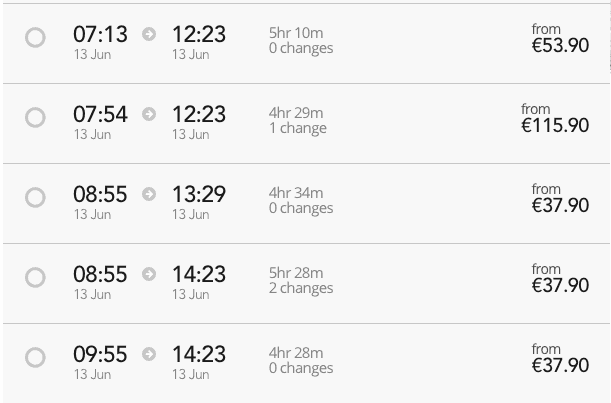
If you buy tickets one month in advance the prices are still fairly affordable at €40-€54. This ends up being a little cheaper or about the same as the pass.
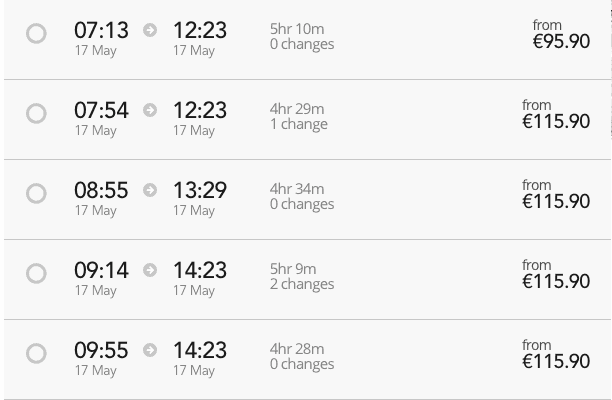
However, when you book less than a week in advance the price skyrockets to well over €50 so a pass is a way better deal.
In conclusion:
Single tickets are almost always cheaper if you buy them a few months in advance but you lose out on flexibility as you have to ride that specific train. Rail passes usually end up being a better deal if your plans aren’t set in stone as you can choose what trains you take on a whim. So we recommend visiting Eurail to see what passes might work for your trip and then do some simple math comparisons.
More Rail Pass Considerations
- 28 & Older: If you’re 28 and over then you’re required to buy a first-class rail pass. This does jack the price up a good amount so it’s less of a deal when compared to 2nd-class single tickets.
- German Rail Twin Pass: When two people travel together they get a 50% discount on the second pass (this is good for both 1st and 2nd class passes). You’ll have to travel on the same train because you’re only given one pass with both your names on it.
More Tips For Riding Trains in Germany
- The Departures Board: You’ll find your train platform via the departure board at the train station. Don’t worry if you don’t see your train because they often only display trains departing within the next 10-20 minutes.
- Self-Service Machines Are In English: Don’t worry if you don’t speak German because the ticket machines (and train station signs) are all in English.
- DB Navigator App: Download Deutsche Bahn’s official app to book tickets, check timetables, and do other helpful stuff.
- Download The Rail Planner App: There are a number of rail apps but we like the Eurail App — it essentially has the timetables/info for every train in Europe and it doesn’t require an internet connection.
- Cheap Tickets Are Non-Refundable: One downside to cheap tickets is that they’re non-refundable and there is a fee to change (but you can’t do it on the day of travel).
- Pack A Picnic: You’re allowed to bring your own food and alcohol on trains. It’s great for those long train rides.
- Luggage: There aren’t any weight limits on luggage and you can bring as much as you want (well, as much as you can carry). Simply bring it on and store it above your head, behind your seat, or in the luggage racks in each car.
- Making Connections: Your trip might require you to change trains along the journey. Don’t worry if there isn’t much time between trains as switching trains are usually fairly quick and easy (it’s not like flying).
- Get To The Train Station Early: Train stations are usually fairly easy to navigate but they can be a little confusing.
- Changing Stations: Some routes might have you switch train stations in a city to make the journey — pay attention to this because stations are usually far apart.
More Articles About Traveling In Germany

- Berlin City Guide : What to do, see, and eat in Berlin.
- Best Hostels in Berlin : The best cheap places to stay in Berlin.
- How To Choose The Best Travel Insurance : Travel insurance will help cover those non-refundable train tickets if something goes wrong during your trip.
- Packing List For Europe Travel : Tips on packing light — which makes train travel much easier.
- How To Buy Train Tickets In Germany : In-depth guide to buying Germany train tickets.
- Recent Posts
- Best Prepaid UK eSIM | Data Plan Buyer’s Guide - April 21, 2024
- How to Avoid Pickpockets in Europe — Tips for Outsmarting the Thieves - April 19, 2024
- Best Prepaid eSIM For Italy | Data Plan Buyer’s Guide - April 18, 2024

No Funny Business
The Savvy Backpacker is reader-supported. That means when you buy products/services through links on the site, I may earn an affiliate commission—it doesn’t cost you anything extra and it helps support the site.
Thanks For Reading! — James
Questions? Learn more about our Strict Advertising Policy and How To Support Us .
Related Reads
How to purchase train tickets for europe | strategies for buying european train tickets.
Tips on the easiest and cheapest ways to buy train tickets in Europe.
Complete Guide To Train Travel In Europe | How To Travel Europe By Train
Our step-by-step guide to traveling Europe by train.
Italy Train Guide — How To Travel Italy By Train
How to travel Italy by train — tips for buying Italian train tickets and advice for navigating Italy by rail.
France Train Guide — How To Travel France By Train
How to travel France by train—tips for buying French train tickets and advice for navigating France by rail.
City Guides
Choosing travel insurance, travel packing lists, budget travel newsletter.
The best budget travel tips sent straight to your inbox.
Join My Journey
Europe travel tips, advertising & privacy policies.
TheSavvyBackpacker.com is a participant in the Amazon Services LLC Associates Program, an affiliate advertising program designed to provide a means for sites to earn advertising fees by advertising and linking to amazon.com.
© 2010 - 2024 The Savvy Backpacker
Website Design by FHOKE
Related Content
Helpful links:, 14 things most worth knowing..., the ice (inter city express) services:, the ic services:, the ec services within germany:, the regio services:, the s-bahn services:, quiet zones:, bicycles on german trains:, detailed train guides, train travel guides:, the booking periods:, discounted prices:, booking tickets at stations:, seat reservations for journeys within germany:, seat reservations on international trains:, journeys with connections:, child tickets:, regional 'lander' tickets:, the national 'quer-duch-lands' ticket:, detailed guides to using tickets and rail passes:, the new national monthly flat-rate ticket, journeys from berlin, journeys from frankfurt (main), journeys from hamburg, journeys from köln / cologne, journeys from münchen / munich, scenic journeys:, international rail routes from germany:, holiday ideas:, notes on using the major stations:, detailed info on the major stations, please support showmethejourney, pan-european train travel guides:, related resources.
- Cities & Stations
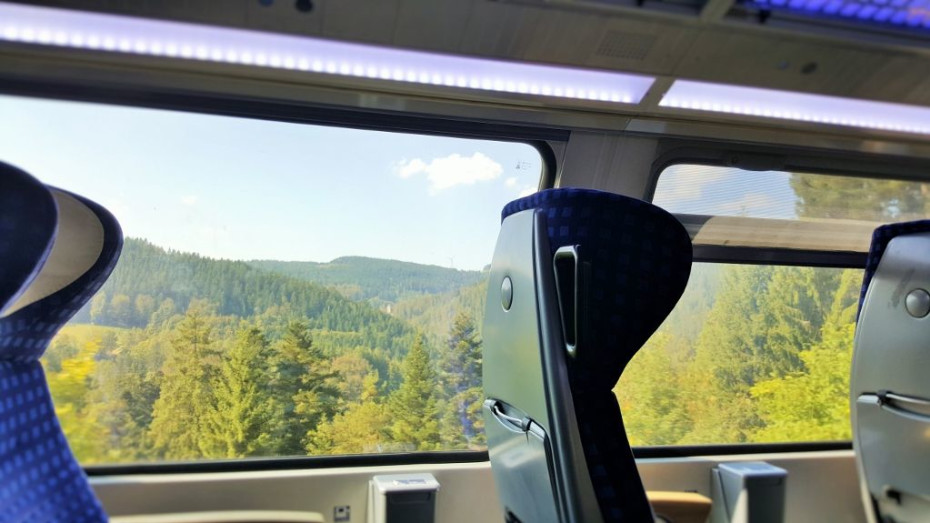
- Germany by train
Welcome to the guide on how to save money, time and confusion when travelling in Germany by train.
Travelling by train in Germany can be an incredible experience. It can boast some of the fastest and most fabulous trains in Europe, has impressive and efficient stations and offers a multitude of spectacular journeys .
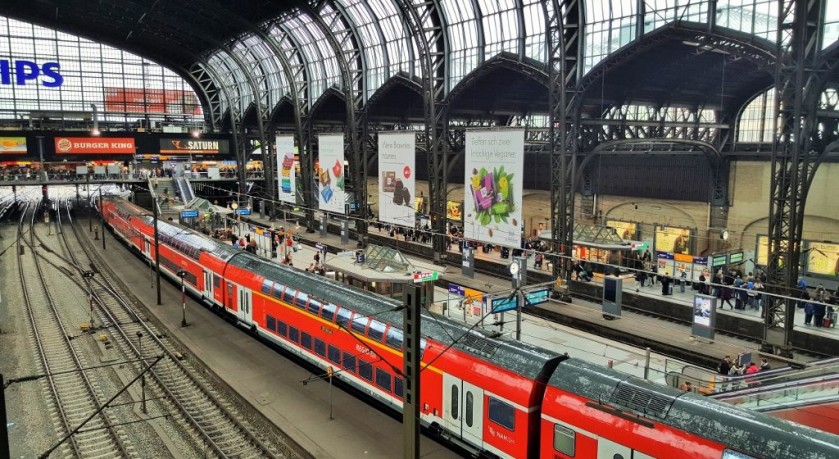
These are the fourten things that are particularly useful to know about German rail travel:
- The German national rail operator is DB (Deutsche Bahn) and it manages all of the national express train services - the ICE trains and the IC trains .
- The ICE trains also operate on international routes to and from Amsterdam, Brussels, Chur, Interlaken, Paris, Vienna and Zurich.
- DB does not operate sleeper trains, but ICE trains overnight on many routes.
- Many of the regional, Regio train services which link cities and towns on shorter distance routes are operated by other companies, but this doesn't affect how tickets can be purchased and used.
- Tickets for journeys by the ICE and ICE trains are typically placed on sale from 6 months ahead of the travel date.
- The discounted tickets are branded Sparschiene tickets - and an adult booking this type of ticket for 1st or 2nd class, can take up to four children aged 15 and under with them at no extra cost.
- Seat reservations are available, but optional, on the ICE and IC trains and have a fixed cost regardless of distance - they are only complimentary and included when booking the more expensive types of ticket .
- Tickets for journeys for the Regio trains aren't typically discounted, and also aren't usually available online.
- When booking the cheapest last minute tickets at the station, they will not be valid on the IC and ICE trains.
- The main central stations in each city are known as hauptbahnhofs, so on timetables these stations are named Hamburg Hbf and Stuttgart Hbf etc. 11 The signage at stations is bi-lingual, it is in English and German, as are the announcements on the express trains, but the station announcements will be in German only.
- The consistent features of the hauptbahnhofs include the information to help you find a train and where to wait for it, left-luggage lockers, step-free access and Reisezentrum travel desks - which sell tickets and reservations for trains across Europe.
- Local S-Bahn trains link the hauptbahnhofs to city centre locations in Berlin, Frankfurt (Main), Hamburg, Leipzig, Munchen and Stuttgart.
- The ICE trains travel up to 300 km/h on these high-speed routes:
- Berlin ↔ Wolfsburg
- Seigburg/Bonn ↔ Frankfurt Flughafen
- Mannheim ↔ Stuttgart
- Hannover ↔ Wurzburg
- Halle and Leipzig ↔ Nuremberg
- Ingolstadt ↔ Munich
- Baden-Baden ↔ Offenburg
- Plochingen ↔ Ulm (the first stage of what will be a Stuttgart ↔ Ulm line)

Travelling on the trains:
German train services are placed into these four categories: ICE, IC, Regio and S-Bahn.
DB (Deutsche Bahn) is the German national rail operator, but it doesn't manage all of the train services in the country. Regional (Regio) services in particular can be operated by other companies, but train tickets for these services are interchangeable. Meaning that if you book a ticket at a station valid for a Regio train, then it can be used on any 'Regio' train to your destination, no matter which company is providing the service.
Five different types of ICE trains are now used on routes within and to/from Germany.
The ICE services are express trains that spend some of their end-to-end journeys travelling on a high speed line. ICE trains travel on high speed lines for most of the journey between these cities:
- Berlin <> Hannover
- Hannover and Wolfsburg <> Frankfurt (Main) and Wurzburg
- Leipzig/Halle <> Erfurt
- Erfurt <> Nurnberg*
- Nurnberg <> Ingolstadt (on route to Munchen/Munich)
- Koln/Cologne <> Frankfurt Flughafen/Airport*
- Mannheim <> Stuttgart
- Stuttgart <> Ulm
- Mannheim <> Offenburg *Trains regularly travel at more than 285 km/h on these lines, but up to 270 km/h is the more usual speed on the other lines.
Note that there are no high speed lines between these cities:
- Koln/Cologne <> Hamburg
- Koln/Cologne <> Hannover
- Hamburg <> Hannover
- Hamburg <> Berlin but ICE trains still operate on these routes.
The IC services ae more conventional express trains, which are mainly used on long cross country routes that don't involve travelling on the high speed lines. Though IC trains can use the high speed lines for comparatively short sections of their journeys.
When there are no high speed lines between cities, the IC services often share the route with ICE services.
Two different types of train used for the IC services; one of which is the new double deck Intercity2 trains.
International EuroCity (EC) services provided by other national rail operators are slotted into the regular German train timetables.
If you will be taking a train journey between Berlin and either Dresden or Hamburg, you could be travelling on a Czech or Hungarian train. Or if you make a journey between north-west Germany and south-west Germany, you could find yourself boarding a Swiss train. And these are just some examples of when this can occur.
The Regio services comprises a broad range of trains because they provide these different functions:
1 Longer distance 'commuter' routes from/and to major cities including Berlin, Koln, Hamburg and Munchen. Regio services often share these routes with IC and ICE trains and when they do so, they can be a cheaper, but slightly slower alternative, to taking those express trains.
(2) The local and branch line services outside the major cities.
(3) Journeys of up to three hours which link smaller towns to regional capitals. On these routes some Regio services can be faster than others because they skip more stations - and those faster trains are usually designated as 'Regio Express' (RE) services. So check the timetables (the yellow Abfarht sheets at stations) before boarding Regio trains - taking the next train to depart MAY not be the quickest option.
The S-Bahn services are the local trains in urban areas of Germany.
Similar to the RER trains in Paris and Elizabeth line trains in London, the S-Bahn trains in Berlin, Frankfurt(Main), Hamburg and Munich/Munchen travel across the city centre, providing faster alternatives to the equivalents of taking the metro from the main 'hauptbahnhof' stations.
'Quiet' and 'Phone' seating areas/zones are available on all ICE trains and on most IC services. You can choose on a seating plan, whether you wish to travel in these zones when making a reservation,
Some form of on board catering will be available on all ICE and IC services and on the EC trains within Germany, but not on Regio services:
In summary:
- Restaurant cars = some ICE trains and the EC trains,
- Bar/bistro counter = all ICE trains, all EC trains, some IC trains
- Trolley services of refreshments = some IC trains (those which don't have bar/bistro counters).
- On demand at seat service in 1st class = all ICE trains
How you travel with a non-folding bike in Germany depends on the type of train service you will be traveling by. Standard (non-folding) bicycles can be taken on all DB trains, except the ICE 1 , ICE 2 , and the older variant of the ICE 3 trains, but special tickets / reservations usually have to be purchased prior to boarding.
ShowMeTheJourney's guide to booking these bike tickets for German train journeys is available here
Click on the buttons below to access info such as on board facilities, and what to look out for when boarding and travelling with luggage/bikes.
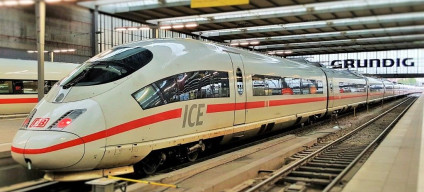
Check out the more detailed info:

Notes on the ticketing:
If you will be buying tickets at the last minute, looking up the train times on the DB website , before you set off for the station can be a good idea.
On most ICE routes the trains depart no more than hourly; and this also applies to some IC routes, and on most Regio routes too.
Though between some destinations the direct trains only depart every other hour; and some very long distance IC services only operate once per day.
Tickets are typically made available up to 6 months ahead of the travel date, but this booking period can be shorter when looking up journeys which involve travelling after the second Sunday in each December. The nationwide and international train timetables / schedules have a major annual update, which takes effect from the second Sunday in December. However, tickets can't be placed on sale until the new timetable is confirmed and this confirmation tends to occur around mid-October, there isn't a set date for this. So if you will be be looking up a journey for travel after the second Sunday in December and can't find any tickets on the route you want to take, it will be because the tickets haven't yet been made available.
The cheapest type of discounted tickets for journeys by the express ICE and IC services are the 'Super Sparpreis' tickets. They can be booked from 6 months ahead of your travel date - the further ahead you can book, the cheaper the prices will be, because only limited numbers of discounted tickets will be available at the very cheapest prices.
On the majority of ICE and IC journeys within Germany the cheapest 'Super Sparpreis' ticket price is now €17.90, this is a newly lowered price. Whether these prices will be available when you book depends on how quickly the tickets at the lowest prices sell out. On the longer distance routes those €17.90 fares can be hard to find if you're not booking at least 3 months ahead.
They will sell out fastest on the most popular departures, so trains leaving at different times on the same day can have different ticket prices. Therefore if you can be flexible re: your departure times then it’s usually worthwhile searching through ‘earlier/later’ departures to find the cheapest fares; or use the ‘Saver Fare’ facility on the DB website. You might save more than €40 by taking trains that are departing earlier or later in the day.
Super Sparpreis and Sparpreis tickets are train specific, you must travel on the train you have selected; this also applies if you haven’t reserved.
Tickets for journeys by S-Bahn trains and nearly all Regio trains aren't discounted, so they cost the same if you buy them last minute at the station; and because they're not discounted, they're not usually available online
However, when you book tickets at a station it will be train service specific. Because the tickets for journeys by Regio trains are cheaper when booked at a station, they can't be used to travel on an IC or ICE train. So once you have booked tickets for a journey by Regio train, you can't then just hop on any next train to your destination - you can only take a Regio train.
Reservations are now only automatically included when booking 1st class Flexpreise tickets, or when booking Flexpreise Plus tickets for 1st and 2nd class travel. When purchasing the cheaper Super Sparpreis and Sparpreis tickets for journeys by express train, you can opt to either:
- travel 2nd class and add a seat reservation for an additional fee of €4.90.
- book 1st class / upgrade a 2nd class ticket to 1st class and add a seat reservation for an additional fee of €5.90. When booking Flexpreise tickets for travel in 2nd class, you can add a seat reservation for an additional fee of €4.90.
Seat reservations are not available on Regio trains.
If you will be using a rail pass on trains within Germany, seat reservations are optional in both 1st AND 2nd class on IC and ICE trains; but the availability of seats isn't guaranteed if you haven't reserved .
Making reservations is OPTIONAL on some international train services/routes, including:
- ICE trains to/from Austria, Belgium, The Netherlands and Switzerland.
- EC trains to/from Denmark (outside summer months), Hungary , Switzerland and The Czech Republic .
- IC trains to/from The Netherlands and Switzerland
- Railjet trains to/from Austria and Hungary
Although reservations are automatically included when booking 1st class tickets.
However in contrast reservations ARE compulsory on:
- DB-SNCF trains to/from France
- EC trains to/from Croatia , Denmark (summer only), Italy , Poland and Slovenia ,
- All overnight trains from/to Germany.
These compulsory international train reservations are automatically INCLUDED when booking 1st AND 2nd class tickets online or at stations Though rail pass users have to book reservations before boarding these trains.
Often making a change of train can save money in comparison to taking the direct ICE trains. The connections are usually designed to make the changing of trains as simple as possible.
On many routes taken by ICE trains, the timetable is set up so that in one hour there will be a direct ICE train between cities. Then in the alternate hours, a 5 – 10 min connection between ICE trains is required to complete a journey.
However IC and ICE trains AREN'T exceptionally punctual, so allowing a minimum of 30mins to make a connection between long distance trains can be the best option.
If your journey involves making a connection between two trains at a Hauptbahnhof and you miss the connection due to a late arrival of a train, tickets and reservations can be re-arranged for a subsequent train free of charge at a Reisezentrum travel desk.
These have recently changed for the better .
- For journeys by the express trains, the EC , IC and ICE trains , an adult (on German railways an adult is a person aged 15 and over) can now take up to four children aged 6 - 14 with them at no additional charge. The change is that this policy only previously applied when parents or grandparents were accompanying the children. Their ages will need to be entered when booking , so you can't just turn up at the station and hop on board; the kids will still require tickets, but in effect they will be complimentary. These new terms also apply to 1st class tickets and it doesn't matter which type of ticket is chosen; and it also applies to international journeys by these specific trains (except for the ICE trains to/from Paris).
- For journeys by the the Regio and S-Bahn trains the former child ticket policy applies, namely a parent or grandparent can take up to four children aged 6 - 14 with at no charge
- Children aged 5 and under travel for free on all trains.
- Children aged 6-14 travelling unaccompanied by adults, or when travelling in a party of more than 6 people will be charged 50% of the adult rate.
If you are planning a day trip by train within a particular region in Germany , these regional day tickets can be great value for money, they cost from €23 - 31 for an individual, but up to four other people can be added to the ticket for only €3 - 7 per person. Meaning that, for example, five adults can explore anywhere in Bavaria in a day by train for only €52.
Though these 'Lander' tickets can be used to travel only on Regio and S-Bahn services and not on the express IC and ICE trains.
If you want to travel between regions , then the Quer-Duch-Lands-Ticket (see below) can be a good option.
Also known as the Day Ticket , this Quer-Duch-Lands-Ticket allows for travel anywhere in Germany for a day, as long as you travel only on Regio and S-Bahn services and not on the express IC and ICE trains.
Though using this ticket becomes a particularly good option if you will be travelling in a group. That's because the base price for one Adult is €42, but up to four other adults can travel on the ticket for only an additional €7 per person.
This ticket can be used for making a long-ish day trip by train, OR a multi-destination single day itinerary, OR as a cheaper, but slower alternative to taking the ICE and IC trains when the cheapest express train tickets have sold out.

The journey guides include access to booking links and information about the trains, tickets and destination stations. Plus for the scenic routes there are insights on how to make the most of the rides on the trains.
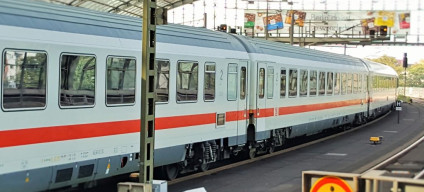
Search for a journey:
- Frankfurt (Main)
- Köln / Cologne / Koeln
- München / Munich
- No Matching Cities
- List is empty.
Seven beautiful journeys through river valleys and gorges:
- Bonn > Koblenz > Bingen - (Mainz)
- Koblenz <> Trier
- Dresden > Bad Schandau > over the Czech border to Decin
- Regensburg <> Passau
- Ulm <> Tuttingen
- Heidelberg <> Neckarelz
- Naumbrg > Jena > Saalfeld
Five lovely routes through forests:
- Offenburg > Singen > Konstanz
- Stuttgart <> Singen
- Freiburg <> Donaueschingen
- Seebrugg <> Titisee
- Platling <> Bayerisch Eisenstein
Six wonderful Alpine journeys:
- Rosenheim <> Berchtesgaden
- Kempten > Immenstadt > Lindau
- Ulm <> Goppingen
- Kempten > Reutte > Garmisch
- Murnau > Garmishch > Mittenwald > Seefeld
- Murnau <> Oberammergau
Short videos showcasing some of these journeys have been uploaded to the ShowMeTheJourney channel on YouTube .

Let the train take you to beautiful locations:

Six things that are good to know:
1 . The main central stations in Germany cities are named ‘Hauptbahnhofs’ and this is universal across the country. The names of landmarks or notable people etc are not used for the names of hauptbahnhofs. 'Hauptbahnhof' is usually shortened to 'hbf' on timetables, departure screens and the DB website.
2 . In some cities including Berlin, Hamburg and Munchen/Munich, long distance trains can call at other stations in the city, before they arrive at the hauptbahnhof/hbf.
So avoid seeing the name of the city on the signage at a station and assuming you've arrived in the city centre. In German cities anything but 'hbf' in a station name indicates that the station is NOT the main, city centre station.
3. All hauptbahnhofs house Reisezentrum (travel desks) at which tickets and reservations on most European international trains can be arranged - without paying booking fees. European train services that can be booked at a Reisezentrum desks include trains that DON'T travel to/from Germany.
Therefore Reisezentrums can be a great resource if you're following a Eurail or InterRail pass itinerary. You can avoid the booking fees payable on the Eurail and InterRail online reservation services; AND the booking fees payable when arranging reservations at stations in Belgium, Switzerland and The Netherlands.
4. You won't go hungry at a hauptbahnhof. The largest German stations usually house 'food courts' with multiple dining options, though 'fine dining' restaurants are less common. Numerous take-away outlets will sell food that is of better quality than you will find on any train.
5. All hauptbahnhofs have coin operated left luggage lockers, which can be accessed during the stations opening hours
When depositing bags you must pay for an initial 24 hours - even if you will be only depositing a bag for a couple of hours. Then on collection you pay the balance if you have left your bag for more than 24 hrs; the charge will rise per day, but keep in mind that you may have to pay in excess of 20 euros in coins, you can't use cards or notes.
Change machines for converting notes into coins can be available, though in our experience they tend to be unreliable. What we do is to collect coins during a trip and put them wherever we have stashed the key, which will open the locker.
6. The German word for platform/track is 'gleis'. At non terminal stations the gleis will be divided into zones. There will be information on the gleis showing in which zones each coach on the trains using that gleis will be located.
So if you have a reserved seat, or want to travel in a specific part of the train, then you can wait in the corresponding zone. You can usually only find out the specific zone info when you are on the platform/track/gleis.
Click the buttons below to discover how to travel to and from the stations by public transport, plus links to additional info including the station and city websites.

This second version of ShowMeTheJourney is exciting and new, so we are genuinely thrilled that you are here and reading this, but we also need your help. We’re striving not to let anything get in the way of providing the most useful service possible, hence a facility has been set up with DonorBox which can be used to support the running costs and make improvements.
Instead of advertising or paywalls, your financial support will make a positive difference to delivering an enhanced service, as there’s a lot of ideas which we want to make happen.
So if you have found the info provided here to be useful, please go here to say thank you .

Help keep us advertising and paywall free!
This second version of ShowMeTheJourney is exciting and new, so we are genuinely thrilled that you are here and reading this, but we also need your help.
We’re striving not to let anything get in the way of providing the most useful service possible, hence a facility has been set up with DonorBox which can be used to support the running costs and make improvements.
So if you have found the info provided here to be useful, please consider saying thank you.
See if there’s a unique journey guide for your trip, featuring info on the trains, tickets & stations.
- Austria by train
- Wien / Vienna
- Belgium by train
- Bruxelles / Brussels
- Czechia by train
- Praha / Prague / Prag
- Denmark by train
- København / Copenhagen
- France by train
- Great Britain by train
- Hungary by train
- Italy by train
- Firenze / Florence
- Milano / Milan / Mailand
- Roma / Rome
- Torino / Turin
- Venezia / Venice / Venedig
- Netherlands by train
- Norway by train
- Poland by train
- Warszawa / Warsaw
- Spain by train
- Sweden by train
- Switzerland by train
- Basel / Bâle
- Genève / Geneva
- Zürich / Zurich

This is one of more than 100 train travel guides available on ShowMeTheJourney , which will make it easier to take the train journeys you want or need to make. As always, all images were captured on trips taken by ShowMeTheJourney.

- Europe by Train
- Journey Guides
- Rail Stations
- Trip Planning
- Travel Articles
- Tips from 100s of journeys
- How to take a night train
- Good to know about daytime trains
- Travelling with Children
- Taking Bikes on Trains
- Travelling with Luggage
- Taking dogs on trains
- Common benefits of first class travel
- Journeys with multiple connections
- Money saving advice
- The best permanent deals and offers
- Intro to seat reservations
- Step-by-step booking guides
- InterRail/Eurail
- Access over 500 rail holidays
- Save 5% on more than 30 Swiss rail holidays
- Book a range of Swiss rail passes
- Buy Half Fare Cards for Switzerland
- Book train tickets with Trainline
- Book rail holidays worldwide with Bookmundi
Train Travel in Germany
All About Train Travel and the German Railway
One of the best ways to discover Germany is by train. The German railway system is very well developed and reliable, and you can reach almost every city in Germany by train ; not to mention that watching the German landscape stream by your window is a very relaxing and comfortable way of traveling.
The German National Railway is called Deutsche Bahn, or DB for short. Here is an overview of the German Railway System that will help you decide what trains to take and how to get the best tickets for your train travel through Germany.
The German High Speed Train
If you want to travel as fast as possible from A to B, take the Intercity Express ( ICE - though it is not pronounced "ice" in German, it is referred to by its abbreviation). The German high speed train, which reaches speeds up to 300 kilometers per hour, is a signature silver snout takes only 4 hours from Berlin to Frankfurt and 6 hours from Munich to Berlin. It connects all major German cities.
The German Regional Train
If you want to travel at a different speed and the journey is your reward, take the regional (and cheaper) trains. They will stop more often but reach smaller German towns and villages. The regional trains are called Regional-Express or Regionalbahn.
The German Night Train
If you don’t want to miss a single day of your trip and want to save on hotels, take a night train. The trains leave in the early evening and as morning comes, you will have reached your destination. You can choose between seats, couchettes, or comfortable sleepers, and there are also deluxe suites with two to six beds, a private shower and toilet, available.
Tips for Train Travel in Germany
Where to Get Your Train Ticket:
With a standard train ticket you can board any train on the German Railway at any time. When you buy your ticket, you can choose between first and second class. Look for the large 1 or 2 next to the car door to find the right class.
There are various ways to purchase your train ticket:
- Online: The official website of the German Railway is available in English. Book tickets online and conveniently print them out at home. Keep your eyes open for online deals.
- Ticket Vending Machines: Almost every train station has a touch screen ticket vending machine where you can purchase tickets and make seat reservations up to the last minute. This service is available in English and five other languages. You can pay either cash or with a Maestro Card, and sometimes Visa or Mastercard are accepted.
- German Railway Ticket Counter: If you want to talk to an agent and get some personal advice, maps, and timetables, head to the ticket counters of the German Railway, called DB Reisezentrum . These ticket counters are located inside most train stations.
How to Save on Your Train Tickets:
You can get huge savings on long-distance train travel in Germany if you book your tickets in advance. Special rules apply to those tickets, for example you may be restricted to a particular day and train, or your round trip journey must start and end at the same train station.
Find out more about Special Train Tickets in Germany that will save you money.
How to Reserve Your Seat:
You can travel on most German trains without having a reserved seat, but you can also spare yourself the hassle of trying to find an empty seat by reserving it beforehand .
For 2 to 3 Euro, you can reserve your seat either online, at a ticket vending machine, or at the ticket counter.
A reservation is especially recommended when you take the train at peak times, such as Christmas or on a Friday afternoon, and it is required for night trains, so make sure you plan ahead.
Traveling by Train in Europe: Where, Why, and How
Train Travel in Morocco
About Single Europe Train Tickets
German Rail Map and Transportation Guide
Discount Train Tickets in Germany
Germany Guide: Planning Your Trip
Useful German Phrases for Train Travel
Getting Around Paris: Guide to Public Transportation
Taking the Train in Italy
How to Travel from Amsterdam to Dusseldorf by Train, Bus, Car, and Plane
Getting Around Germany
Italo High-Speed Trains
How to Travel from Rome to the Cinque Terre by Train, Bus, Car, and Plane
Guide to Bus and Train Travel in Spain
When Should I Buy My Train Tickets for Italy?
How to Enjoy a Quick Layover in London on a Budget
Matador Original Series
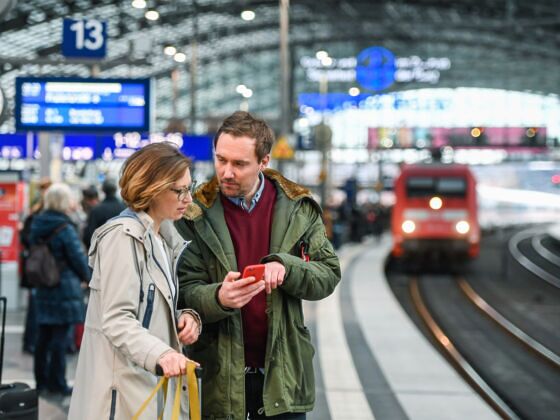
Beginner’s Guide to Train Travel in Germany
By: Conor O’Rourke
G ermany beats like the heart of Europe, at the center of a flowing, intricate web of connections. But this web is built of iron and steel, traversed by a fleet of high-tech trains offering quick, comfortable, and sustainable travel — without breaking the bank. (And without the security lines and baggage limits.)
Whatever your travel taste, Germany’s got it, and Deutsche Bahn can get you there. Using the train-travel primer below, soon you could be hiking the jagged hills of Sächsische Schweiz National Park or tasting wines in the Rhine Valley. You could be plumbing the depths of Berlin’s nightclub scene or exploring the Port of Hamburg, Germany’s “door to the world.” With Deutsche Bahn, you’ve arrived at the door to the world, indeed.

This post is proudly produced in partnership with Deutsche Bahn and the German National Tourist Board .
PLAN YOUR DREAM JOURNEY
M unich or Frankfurt to Berlin? Less than four hours. Berlin to Hamburg? Less than two. Cologne to Frankfurt? Around one. Beyond speed, most airports in Germany are connected to ICE trains; Super Saver Fares start at €17.90; and long-distance trains are 100% green. (And once you get off your train, Germany makes it easy to stay sustainable .) If you’re somehow not sold yet, check out where you can go.
Bavarian Route. Here in the land that gave us Oktoberfest, you’ll find everything your inner Günther desires. Fairytale castles — like the famous Neuschwanstein, inspiration of the Disneyland castle — dot the subalpine landscapes around Munich and Nuremberg. Breweries craft 400-year-old recipes. In the summer, hike through mountain valleys to find hidden glacial lakes. In the winter, strap on your skis and hit the slopes.
Rhineland Route. Compacted into a corner of western Germany, the Rhineland is a densely populated expanse of rivers, vineyards, and cities. Here, you get a lot of bang for your traveling buck — travel between major cities like Cologne, Aachen, and Düsseldorf rarely takes longer than an hour. With its Roman history, you’ll want to be sure you visit the Ruins at Trier, Germany’s oldest city and one-time capital of the Roman empire. Also check out the local wine scene, and, of course, cruise the famous river that gives the region its name.
North Coast Route. Bookended by Germany’s two most famous and beautiful islands, Rügen and Sylt, this route will ensure you keep the sea in view at all times. Many of the cities along this route — Lübeck, Kiel, Hamburg, etc. — were members of the historic Hanseatic League; nowadays, you can see the Hansa influence in traditional Brick Gothic architecture exhibited on the region’s cathedrals and town halls. The area is known for its excellent bike trails, made all the more welcoming (and leisurely) by its extremely flat landscape and beautiful sea views.
Eastern Route . Travel through Germany’s ex-communist east, the former lands of the German Democratic Republic. You’ve got both ends of the spectrum here: old Soviet-style factories decay amid picturesque, unspoiled forests and lakes. With just a few hours’ train ride, you can travel from Berlin’s thumping nightclubs to Dresden’s reconstructed Baroque city center to the fantastical limestone rock formations of Sächsische Schweiz National Park.
The Grand Tour . For the completionists among us, it’s possible to visit all of Germany’s major cities by rail in just a few days. Start in the historic Römerberg neighborhood in Frankfurt; an hour away in Cologne, witness the Cologne Cathedral; head to Hamburg’s UNESCO-designated Speicherstadt, the world’s largest warehouse district; two hours later, scope out Berlin’s impressive museums or party the night away (or both). For your last and longest leg, a four-hour ride gets you to Munich, home of Oktoberfest, where you can finally sit down in a traditional biergarten, toasting to your journey.
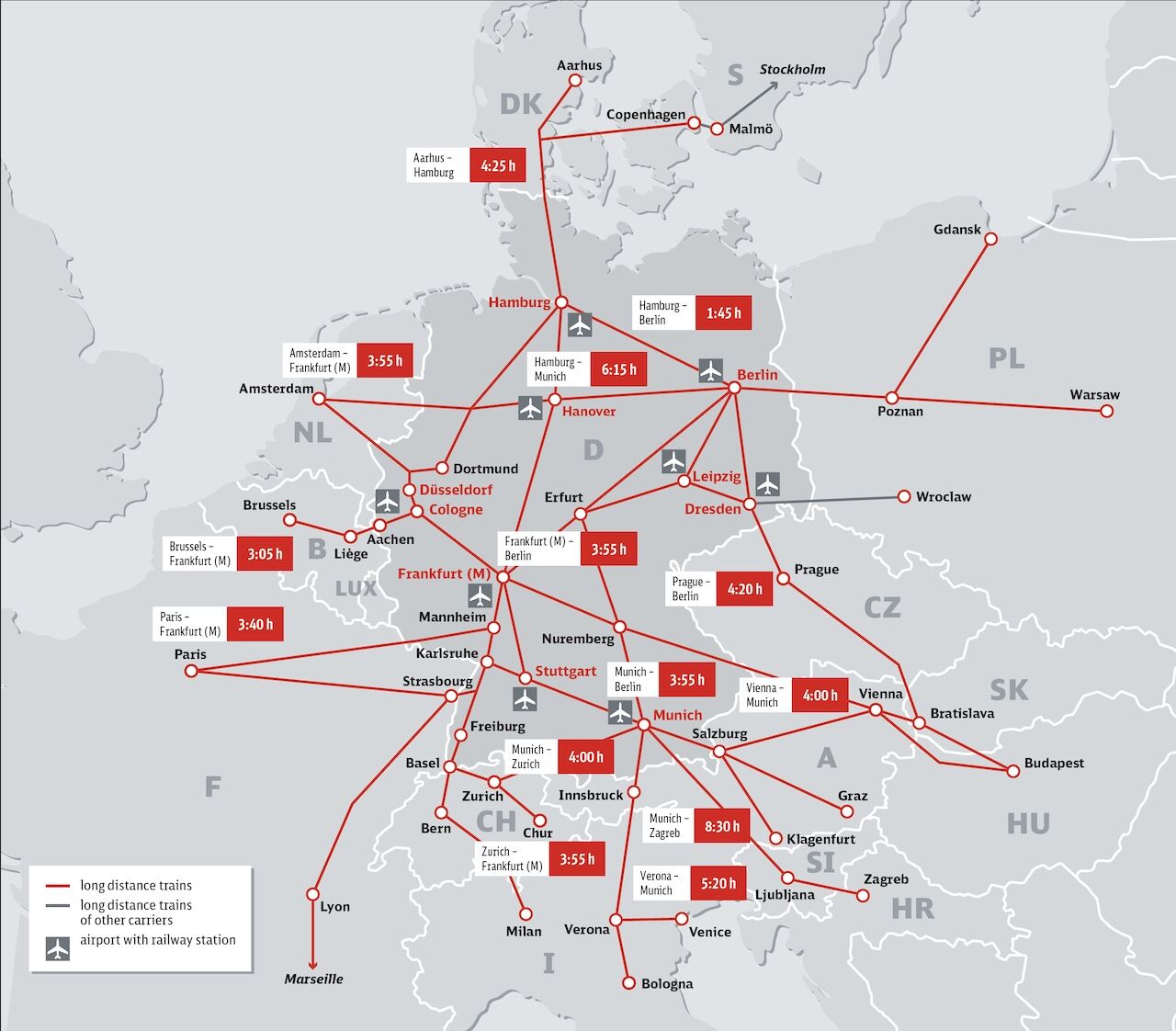
NAVIGATING TRAIN TRAVEL
ICE/IC/EC/regional trains. By and large, Germany’s high-speed Intercity-Express (ICE), Intercity (IC), and Eurocity (EC) lines are for longer-distance travel. These trains are generally more advanced, even faster, and a bit more amenity-laden than their regional counterparts, offering first- and second- class tickets, dining cars, and so on.
The ICE Sprinter. This is the pride of German rolling stock, offering more legroom than on planes, free Wi-Fi, plugs for your electronics, on-board catering, “quiet zones,” and more. First-class travelers can travel without worry, since they get seat reservations and meals, drinks, and snacks. But here, the real seller is definitely the speed — on some routes, ICE Sprinter trains reach speeds of 185mph (300 km/h). You’re not wasting any time getting to your destination.
Buy early and online. Buying tickets for Deutsche Bahn can definitely take place at the station, but for better prices, it’s best to book in advance (or to be under 27 years old ). If your trip is starting or ending in Germany, the easiest way to get tickets is to book online, either at the Deutsche Bahn website or using the DB Navigator app on your mobile phone. Those traveling internationally may also find Rail Europe useful in their own trip-planning.
Get a Eurail Pass. The ultimate choice for a flexible European vacation, the Eurail Pass allows you to travel in 33 countries for a set number of days based on the ticket you buy. Most trains don’t require you to make a reservation either — you can use your Eurail Pass whenever you want. For convenience, a mobile phone pass is also available and, if you lose your phone, it’s simple to get a replacement pass so your vacation won’t be stalled.
THE PERKS OF TRAIN TRAVEL
Speed. For most single-country journeys — especially in or around Germany — train travel is often equivalent or faster than flying. When you factor in showing up at the airport early, checking baggage, going through security, the flight itself, time at baggage claim, and customs lines, train travel can look downright speedy by comparison.
Sustainability. Trains today are far removed from the coal-burning steam engines of the nineteenth century. Today, all of Deutsche Bahn’s ICE, IC, and EC trains within Germany are powered by 100% renewable power, mostly from wind, solar, and hydroelectric sources. And as part of its ambitious climate goals, DB aims to be totally climate-neutral by 2040. Many of the local city-rail networks DB operates across Germany run entirely on renewable energy as well.
Comfort. Prefer to overpack? Trains let you bring as much baggage as you can carry. Like to spread out while you’re traveling? Trains offer more space than planes or buses. Picky eater? Just bring your own food and drinks on the train with you. Desperately need Wi-Fi? Long-distance ICE trains have free, unlimited Wi-Fi, and many train stations offer free Wi-Fi for an hour.
Train travel is also far quieter and smoother than traveling by bus or plane, making it that much easier for you to close your eyes, stretch out your legs, and get some much-needed shuteye. And, yes, there is air-conditioning, so you can enjoy that mid-summer travel. To sum up: Until they get around to inventing flying massage tables, trains have got to be the most comfortable way to do long-distance travel.
Affordability. While the price of oil (and therefore airfare) rises, train operators in Germany and beyond are working to reduce the costs of train travel. Deutsche Bahn now offers Saver Fares and Super Saver Fares that offer prices competitive with or cheaper than the equivalent journey’s airfare. Saver Fares include local transport at departure and destination cities, cancellation for a fee, and free travel for anyone under 15 years old who’s traveling with an adult. Super Saver Fares offer an even cheaper base rate for those comfy with no cancellation option — available from as little as €17.90 for long-distance services within Germany.
TIPS & TRICKS
Bring your ID. As we touched on above, luggage is no problem, so feel free to pack as much as you can comfortably carry. There are some essentials, though: tourists need to carry an ID recognized by Germany on their person at all times. Note: American drivers’ licenses do not count as legal ID in Germany.
Keep your essentials portable. For greater peace of mind, it’s a good idea to bring a small bag for your essential documents, money, and valuable items like jewelry or phones. That way you can easily bring it with you on your way to the bathroom or dining car.
Bring something to keep busy. While essential info is available on your ICE ride in English, onboard entertainment comes in German — you might want to load a tablet or other device with some movies and TV shows unless you speak Deutsch. Books, games, or a journal are also classic train companions, but to tell you the truth, there’s something magical about putting your headphones on and just gazing out the window at the passing landscape.
- Travel recommendations
- The taste of travel
- Tips & tricks
- Travel experiences
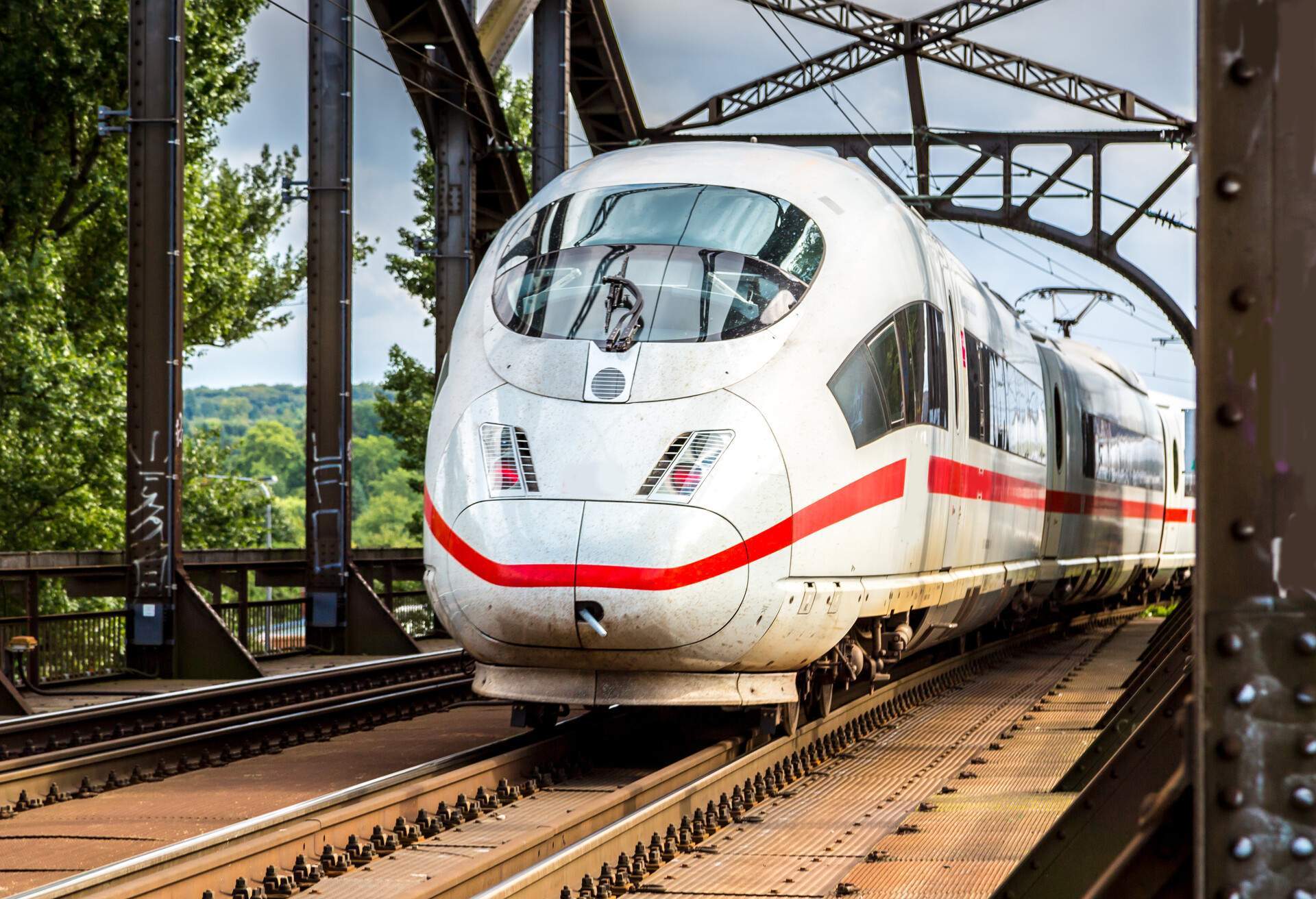
Everything you need to know about exploring Germany by train

Listen, who among us has not romanticized traveling transported through fairytale landscapes aboard a steam train? Really – it’s the dream. And Germany, with its natural beauty and unparalleled efficiency, is the perfect place to plan a journey. Here’s what you need to know to get your training plans started.
1. Where can I buy tickets?
You can purchase tickets for trains traveling to and around Germany online or in person at the train station. To find train tickets on KAYAK, head over to https://www.kayak.com/trains . You can filter your search by duration, arrival/departure time and price to find the deal that suits your needs.
The second option is to purchase tickets in person. All stations in Germany have automated ticket machines and ticket windows. All ticketing machines have an option for English. Short notice tickets bought in person are often more expensive than those bought online, but it does give you the added opportunity of spontaneous travel.
2. Is pre-booking better?
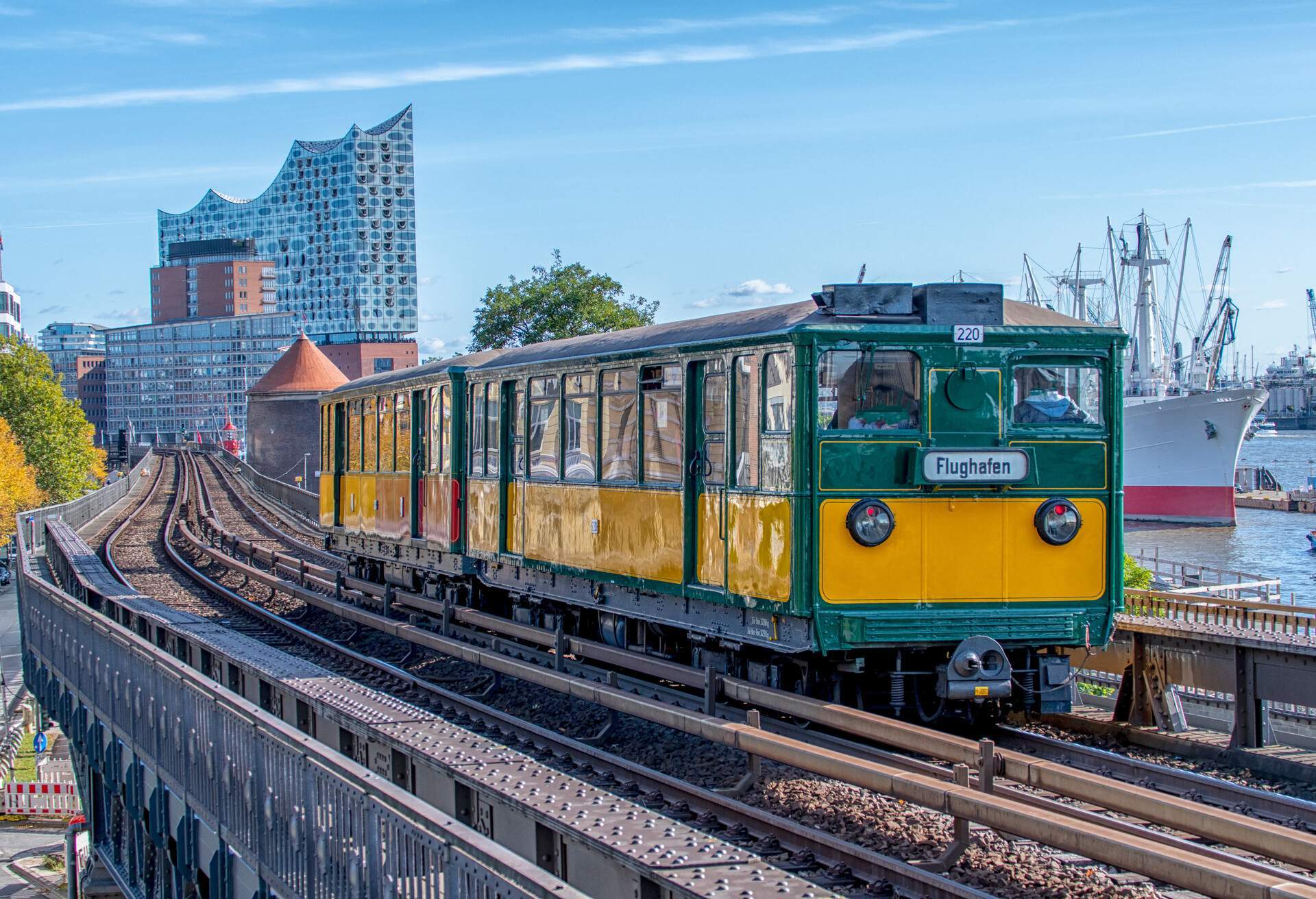
Ticket prices for travel within Germany don’t often differ too much; though online, pre-booked purchases can sometimes be cheaper. Booking tickets months in advance online will often save you more money, as tickets tend to increase in price as you near the departure date.
Another benefit to pre-booking tickets is getting a preferred seat on the train, especially the busier high-speed/long-distance trains. Regional trains have a fixed price based on the distance they travel, whether you purchase tickets online, on the day, in advance or at a ticket machine, so it isn’t necessary to pre-book these before traveling.
3. What ticket types are available?
There are three types of train tickets to choose from. There are two standard types, Sparpreis and Flexpreis, as well as a Sparpreis First Class ticket. Sparpreis is a budget ticket that isn’t flexible and is only available for specific routes. Flexpreis is a full-price option that offers a ton of flexibility and is valid for any train during the chosen day. Although the First Class ticket has the same limitations as the Sparpreis ticket, it does offer a few extra perks, including extra legroom, nicer seats and lounge access in the larger stations.
4. Should I buy a rail pass?
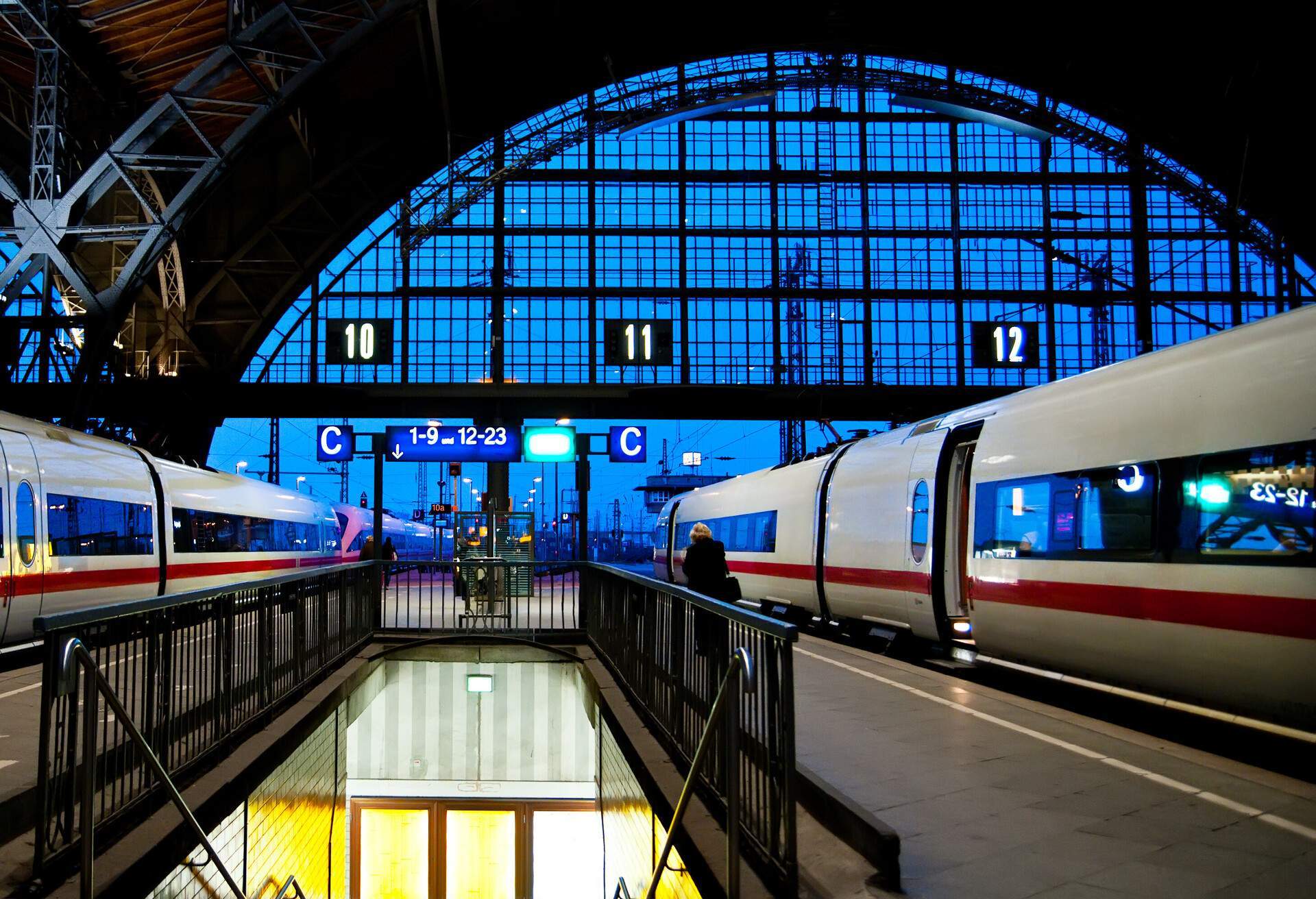
Purchasing a rail pass removes the need to make a reservation to ride any train, except for the overnight trains. You can head to any station and hop on any train you choose.
5. What types of trains are in Germany?
Various trains run on the Deutsche Bahn network, with the faster and more modern option being the Intercity Express (ICE) trains. These trains have a top speed of around 200 miles per hour and offer extremely high standards in comfort and technology.
Both the Eurocity (EC) and Intercity (IC) trains provide long-distance routes connecting major German and other European cities, while metropolitan and rural areas are generally connected by suburban and regional trains that run at varying speeds. All of the trains in the Deutsche Bahn network are of the highest quality and are regularly serviced to ensure passenger safety.
6. What do I need to know about the boarding process?

Once you’ve arrived at the station, check the departure board to find your train. Sometimes the platform on the board can change, so make sure to keep an eye on it. If you don’t see your train, you may be too early. Your train should be displayed closer to the departure time. Downloading the DB app is very useful for finding platforms and staying updated in case of delays.
The most scenic Germany by train trips to take
Freiburg im breisgau to donaueschingen.
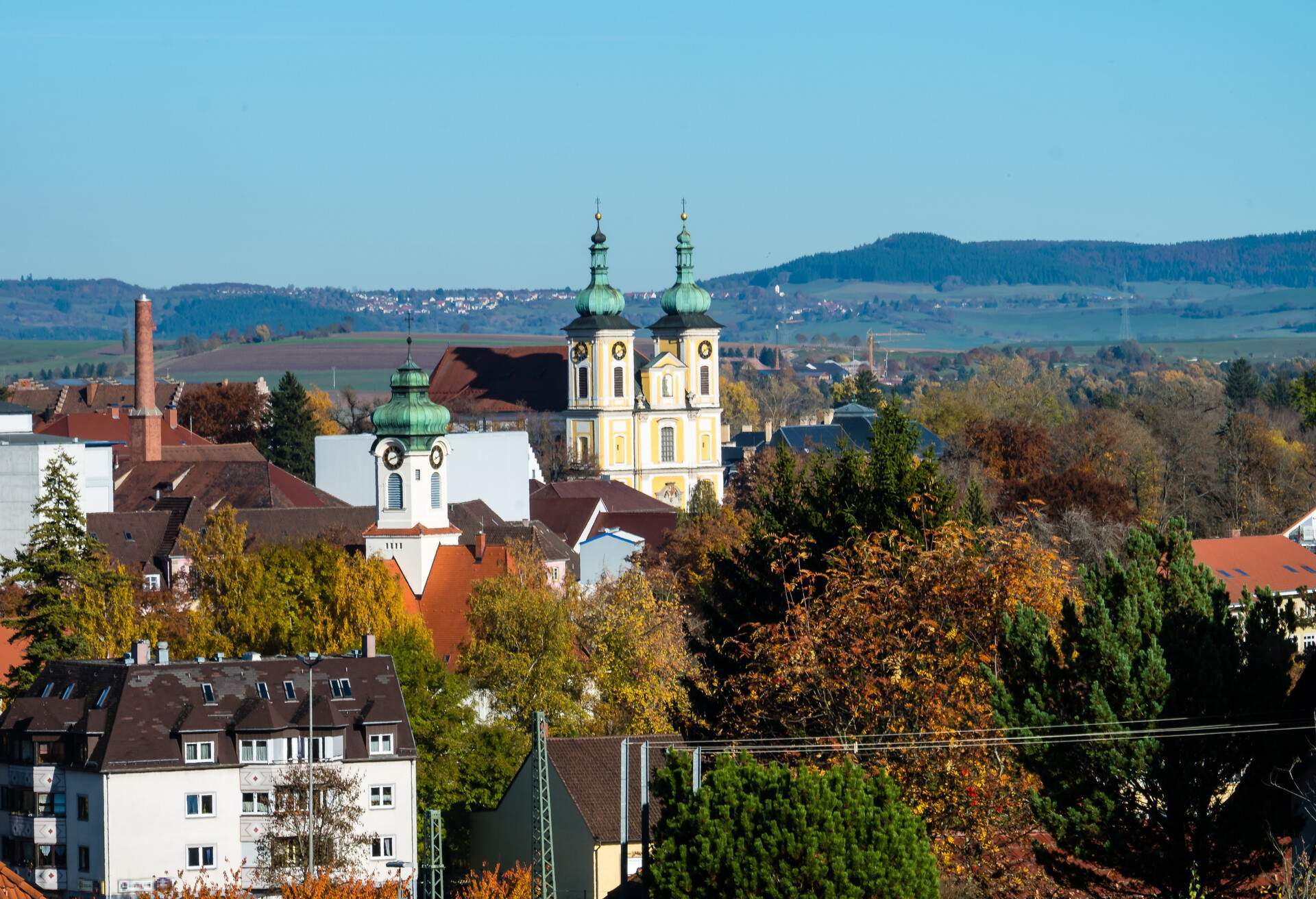
Otherwise known as Hollentalbahn, which is Hell Valley Railway in English, Freiburg im Breisgau to Donaueschingen is a beautiful journey between these two cities. It runs along the Dreisam River valley and is one of the steepest rail lines in Germany. One of the most thrilling parts of the journey is across the Ravenna Gorge, along the Ravenna Bridge. This trip typically takes just over 2 hours.
Konstanz to Offenburg
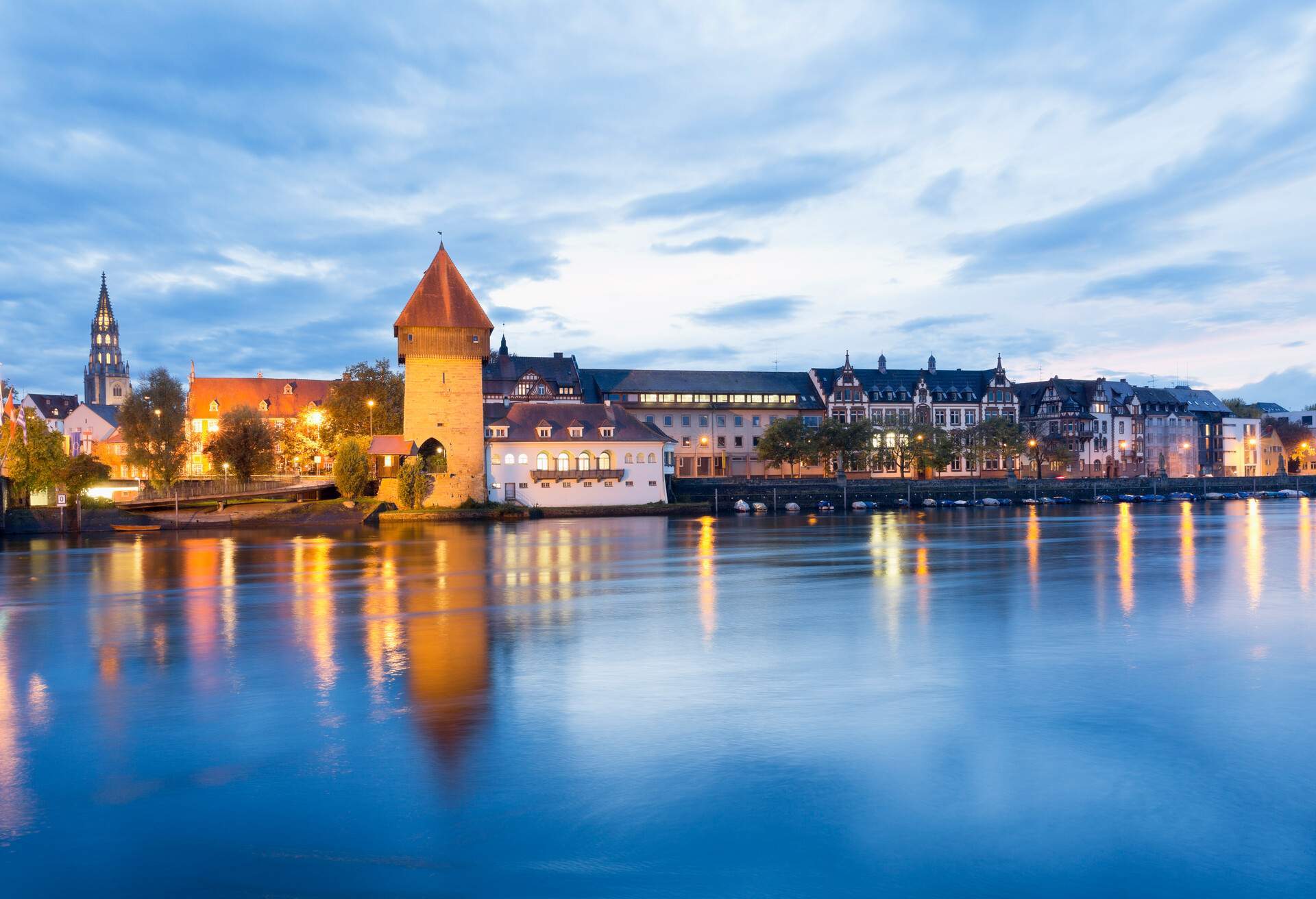
Konstanz is a picturesque part of the country on the shores of Lake Constance (otherwise known as Bodensee), and this route takes you through to the Black Forest, the backyard of Hansel and Gretel. The trip is usually covered in under an hour and runs through some of the most exquisite scenery imaginable, including beautiful meadows, quaint hamlets and rows upon rows of pine trees lining the outskirts of the forests. Along the route, you’ll pass through Triberg, a beautiful small town, as well as the Hornberg Viaduct. The journey from Konstanz to Offenburg typically takes around 2 hours and 15 minutes.
Munich to Neuschwanstein Castle
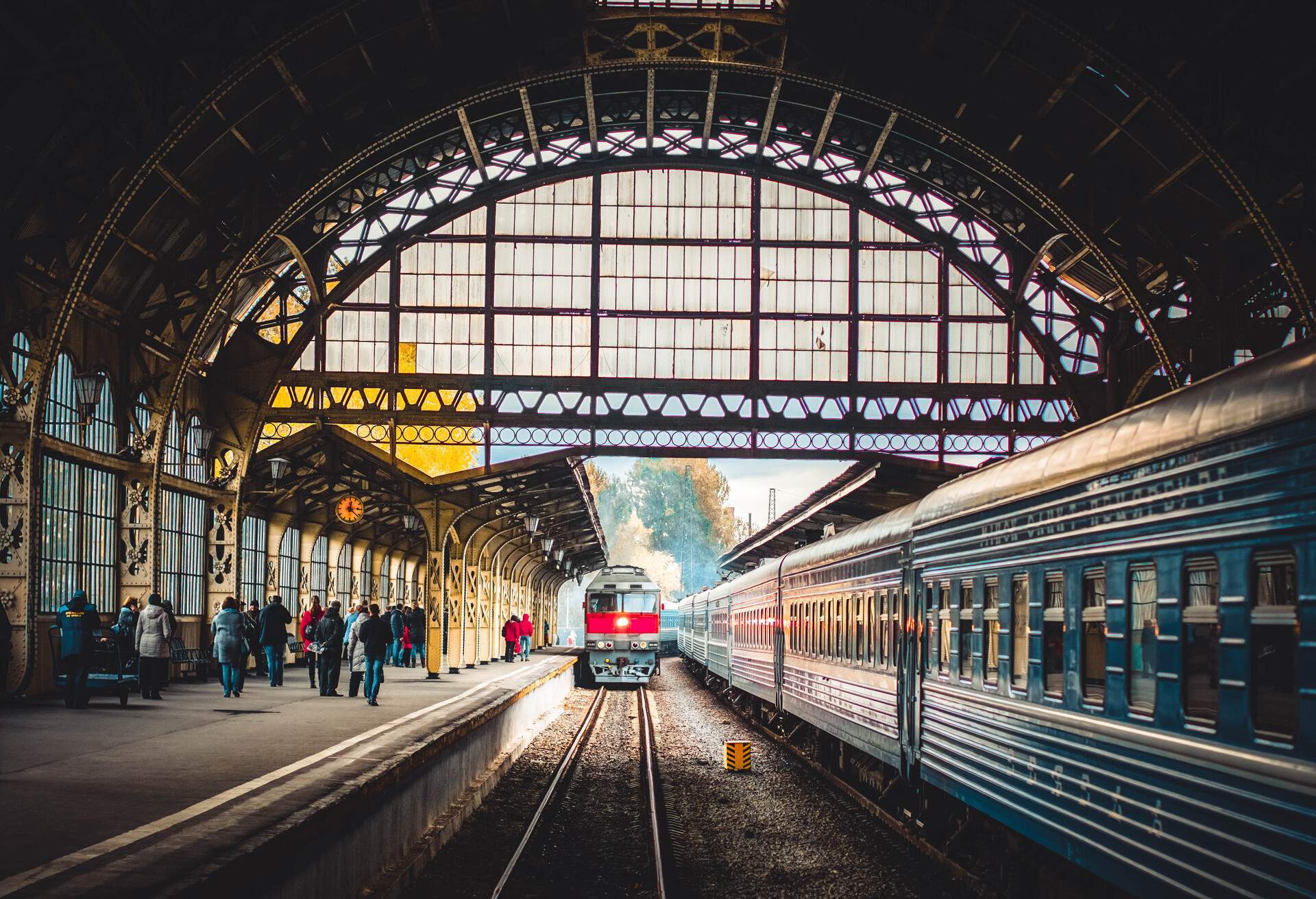
The theme of this journey is a fairy-tale scene as it crosses the Bavarian countryside between Fussen and Munich in around 2 hours and 30 minutes. You’ll make your way through stunning little villages with picturesque architecture and lush, flowing meadows lining the country. At the end of the journey, you’ll be greeted by the breathtaking backdrop of Neuschwanstein Castle, standing against the snow-capped Alps. To make sure you get the ideal view of the castle as you arrive, book a ticket on the left-hand side of the train and send us a thank you note afterward.
Rhine Valley

Taking a trip along the majestic Rhine River is a must as you take in the Upper Middle Rhine Valley. It connects Bingen and Koblenz and is a UNESCO World Heritage site lined with castles, historic towns and vineyards. The Rhine has served as a transport link between the northern and southern halves of the continent for hundreds of years. It also played a part in the cultivation of trade and cultural exchanges in ancient times.
Cologne to Mainz is another route you could take along the Rhine, or one of the most popular of these routes is Cologne and Koblenz, taking around 1 hour and 20 minutes total.
From Munich to Mittenwald
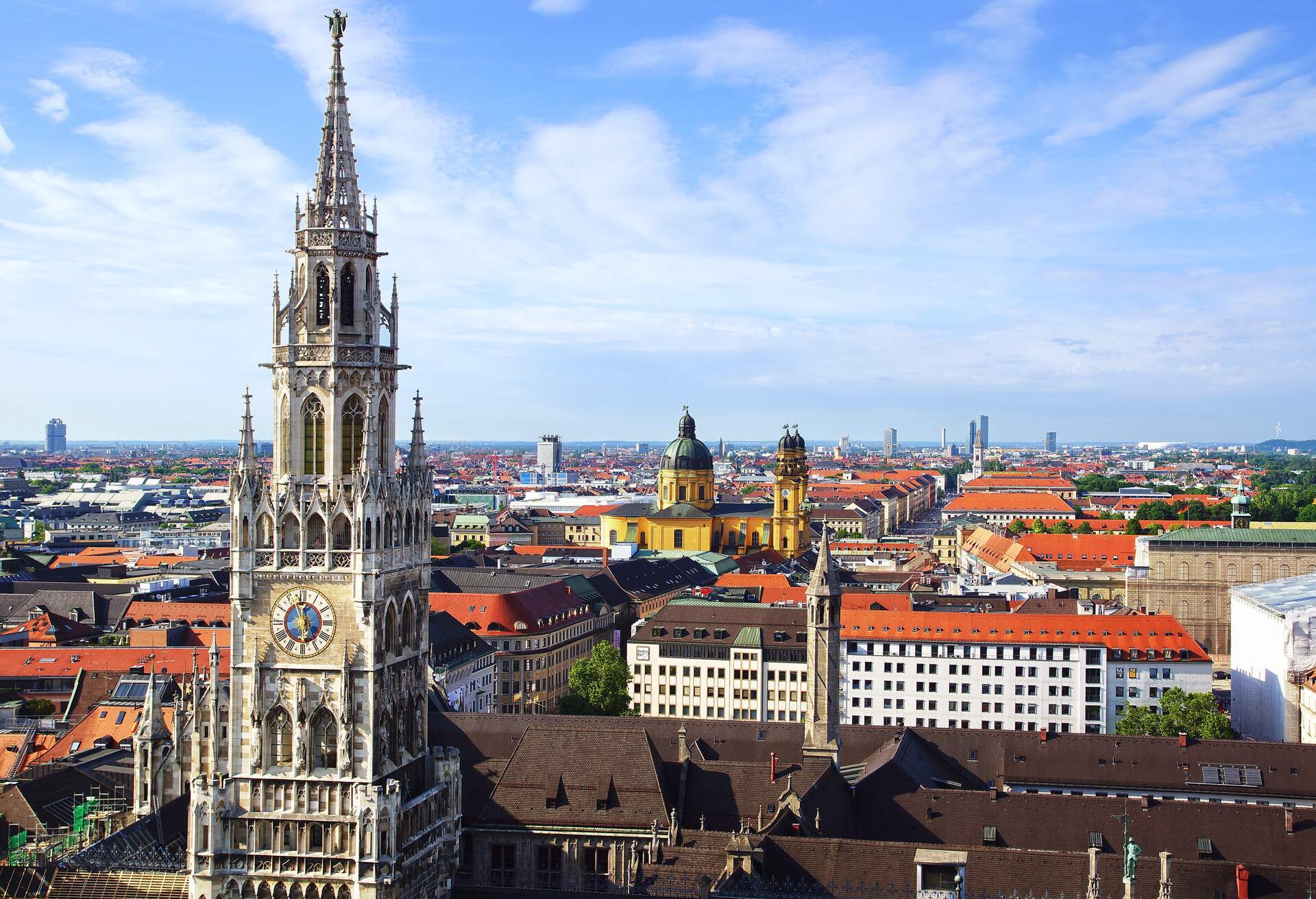
This trip covers roughly 50 miles and will generally take just under 2 hours. This journey is widely considered one of the most beautiful routes in the country, passing through exquisite Bavarian countryside panoramas en route to one of the most stunning alpine towns in the country, Mittenwald. The countryside moves from a sweeping green of rolling hills in the summer to a snow-capped alpine dream in the winter.
Moselle River route
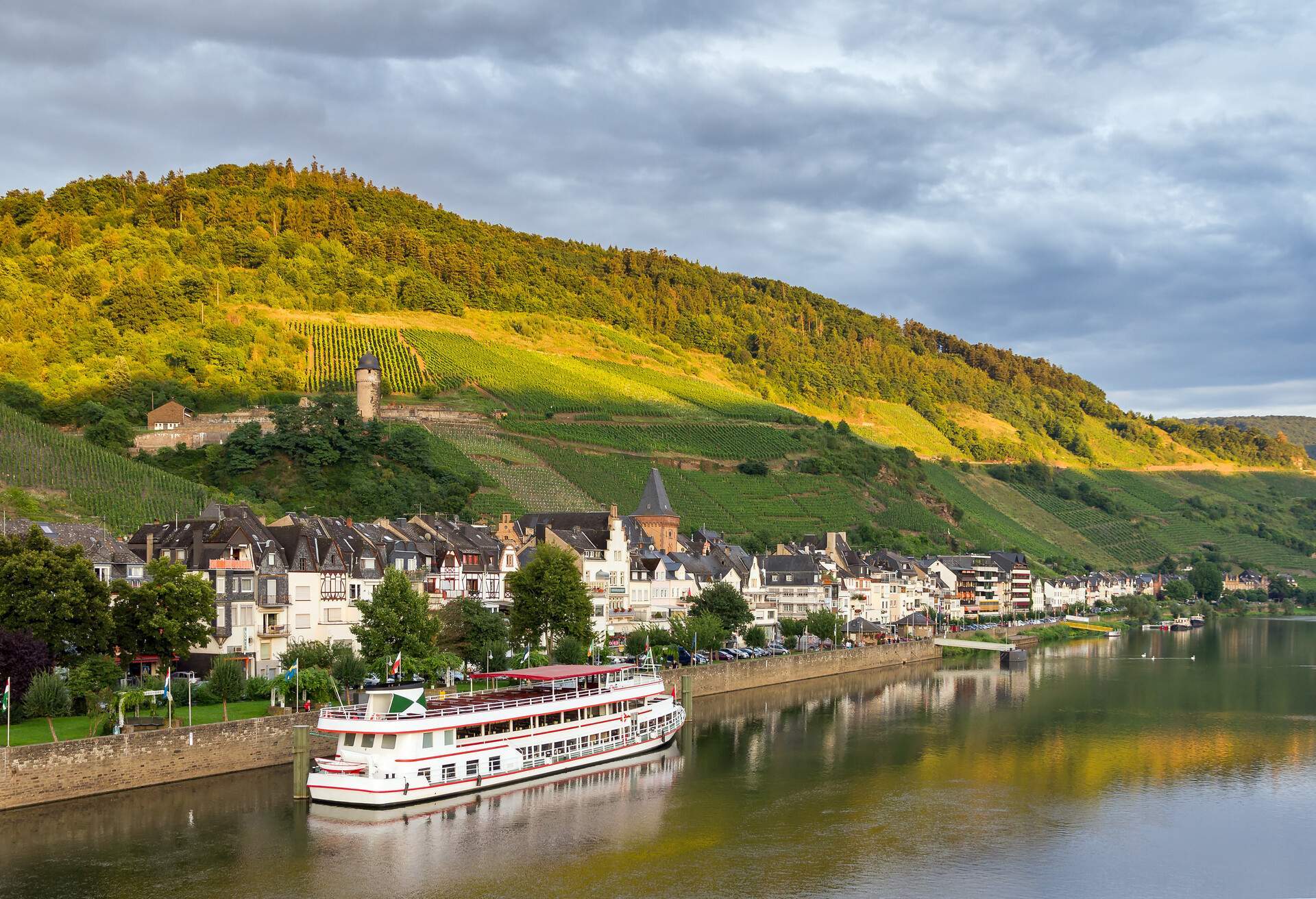
Another one of the most breathtaking routes in Germany is along the Moselle River, which will start in Koblenz where the Moselle river meets the Rhine. The route runs through countless vineyards and past beautiful villages and castles. Deutsche Bahn typically offers a route from Koblenz to Trier in around 1 hour and 45 minutes.
About the author

Explore more articles

- How we work
- Hotel owners
- Advertise with us
- Airline fees
- Low fare tips
- Badges & Certificates
- Terms & Conditions
California consumers have the right to opt out of the sale * of their personal information. For more information on how we securely process personal information, please see our Privacy Policy .
Do not sell my info ON
* The definition of "sale" under the California Consumer Privacy Act is applicable only to California consumers.

My Life in Germany
All you need to know about studying, working, and living in Germany
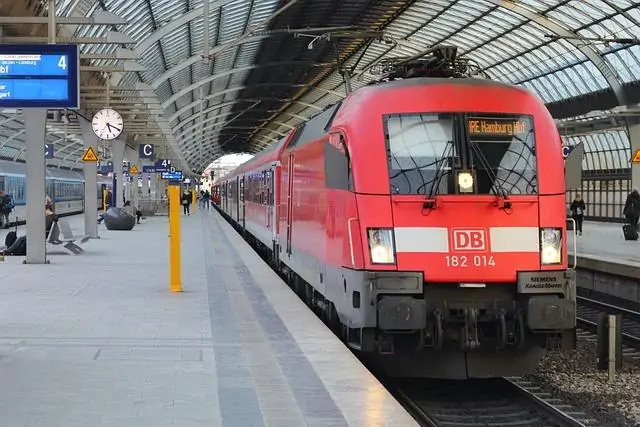
Train in Germany – A Comprehensive Traveler’s Manual
This post contains affiliate links. It means that if you click on the links and make a purchase, we will receive a small commission at no additional cost to you. This allows our blog to continue providing you with free information. We only include links and products that we truly believe in. You can read the full disclosure here .
Moving to Germany or new in Germany? Check out our Resources Page for all the help you need!
When it comes to exploring the heart of Europe, there’s no better way than hopping on a train in Germany. In this guide, we’ll break down everything you need to know about train travel in Germany. From booking your ticket to understanding the train types and other insider tips , we’ve got your back. So, grab your ticket, and let’s embark on a train adventure in Germany!
Table of Contents
Train companies in Germany
Germany has a diverse railway industry with several train companies operating both domestically and internationally.
Deutsche Bahn is the national railway company of Germany and one of the largest train operators in Europe. It covers a wide range of train types and routes, from high-speed journeys between major cities to regional travel within different states.
Besides Deutsche Bahn, you can also find private train operators in Germany such as FlixTrain, NordWestBahn, HKX (Hamburg-Köln Express), LEO Express, and others. They offer alternative options for rail travel, fostering competition.
Read also: Free Credit Card in Germany – Top 5 For Travel and Cashback
Different types of trains in Germany
Regional trains in germany.
Germany has a super well-connected web of regional trains that pretty much covers the entire country. Locals use them for daily commutes, and tourists use them to explore different places. Regional trains are not the flashy high-speed ones but do a fantastic job connecting smaller places.
Depending on where and when you’re traveling, regional trains can run every half-hour or hour . But in quieter areas, they might not show up as often.
These trains can look different – some are single-deck, while others have two decks. They’re either run by Deutsche Bahn (DB) or sometimes by other companies. But you can usually buy tickets for all of them on the DB website .
Many regional train stations have ramps and elevators to make it easy for passengers with disabilities. These trains also like to partner with other forms of public transport , like trams, buses, and subways. It’s like a one-ticket-fits-all deal, making it convenient to move around cities and regions.
There are different types of regional trains in Germany:
The S-Bahn is the most frequent type of regional train, and it can show up as often as every few minutes .
Think of S-Bahn trains as the city’s commuter buddies. They can cover quite a distance, but they’re mainly for folks living in big cities . These trains basically connect the downtown hub with the suburbs and nearby spots .
Back when I lived in a big city like Munich or Berlin, I used the S-Bahn all the time. But when I moved to the suburbs , I ditched the S-Bahn (unless I had to travel to the big city from the suburbs). People in the suburbs find it easier to get around on bikes, by car, or just walking inside their smaller towns.
You can also use the S-Bahn for trips between big cities sometimes, but it stops at a lot of places along the way and isn’t the speediest option.
Read also: Living in Germany – Big City vs. Small Town
Regional Bahn (RB)
This is similar to S-Bahn. They stop a lot and mostly cover short trips within one state or region . They have fewer stations than the S-Bahn.
Regional Express
There are 2 types of regional express: InterRegio-Express (IRE) or Regional-Express (RE) . IRE is the fastest regional train. They only stop at a few stations and usually travel longer distances. RE trains are slower than IRE and they are stopping at more stations.
If you’re going between big cities in the same region , you can choose to use the regional express. It will be faster than if you do so with a S-Bahn.
U-bahn is very similar to S-Bahn with the exception that U-bahn mainly operates within the city . S-Bahn connects the city with its suburbs and neighboring towns and it covers longer distances.
U-Bahn trains also have more frequent stops within the city center . They run mainly underground in the city centers and have very frequent service .
IC or ICE trains in Germany
Ice trains in germany.
ICE stands for “ InterCityExpress .” These are very fast trains run by Deutsche Bahn (DB). People love them because they’re fast, comfy, and have cool stuff on board.
ICE can run up to 300 kilometers per hour on some routes. That means you can cover big distances between major cities in no time .
When you hop on an ICE train, you’re in for a comfy ride . The seats are roomy, there are power outlets to charge your gadgets, and some even have Wi-Fi. Plus, there’s usually a restaurant or a bistro car where you can grab a bite to eat.
You can use ICE trains to travel between big cities in Germany. But ICE trains don’t just stick to Germany. You can use them to explore other neighboring countries too.
ICE trains are also user-friendly to people with disabilities . There are spots for wheelchairs, accessible restrooms, and staff who can lend a hand.
ICE Sprinter
The ICE Sprinter is a premium high-speed train service operated by Deutsche Bahn. It is similar to ICE and can reach speeds of up to 300 kilometers per hour, covering long distances between major cities within Germany and internationally .
The difference between ICE and ICE Sprinter trains is that ICE Sprinter trains make fewer stops compared to the regular ICE services. This allows passengers to reach their destinations more quickly, making it a preferred choice for business travelers and those seeking shorter travel times.
IC trains in Germany
IC means InterCity and it is also run by Deutsche Bahn. IC trains are very similar to ICE trains but they are not as fast (up to 200km/ h) . Similar to ICE, they often have amenities like power outlets, restrooms, and sometimes dining or bistro cars, depending on the route. IC trains primarily connect major cities within Germany .
The primary difference between IC and ICE trains is their speed. ICE trains are high-speed trains that can travel significantly faster than IC trains. ICE trains usually provide more frequent service between major cities. And they offer more modern amenities and a higher level of comfort compared to IC trains.
IC trains are often used for regional and domestic travel within Germany , while ICE trains are favored for both domestic and international journeys, including connections to neighboring countries.
EC trains in Germany
EuroCity , often shortened to EC, is your way to smoothly travel between different countries in Europe .
When you step into an EC train, you’ll find it quite cozy. On some routes, you might even get dining cars or onboard food service , adding a touch of convenience to your journey.
EuroCity trains run at a speed of up to 200km/h . They connect you to a bunch of fantastic European cities, from Germany to Italy, Austria, and beyond.
Night trains in Germany
Night trains in Germany offer a unique and convenient way to travel long distances while combining rest and transportation . Deutsche Bahn used to offer night train services called City Night Line (CNL). But it has been discontinued since 2016.
However, you can find other night train providers in Germany. For example, ÖBB Nightjet or EuroNight (EN) connects Germany with various European destinations.
Many modern night trains offer comfortable sleeper compartments with beds, private bathrooms, and other amenities. Some also have dining cars or onboard catering services.
A few years back, I hopped on the night trains. It was pretty awesome. I could catch some sleep during the ride. And by the time I woke up, bam, I was at my destination. No time was wasted, and it was way comfier than taking a plane too.
Other privately run trains
In addition to the trains operated by the national railway company Deutsche Bahn, there are also privately run train services in Germany.
For example, FlixTrain, NordWestBahn, HKX (Hamburg-Köln Express), LEO Express, etc. These services may connect major cities and offer alternative options for travelers.
Price of train tickets in Germany
There are different types of train tickets in Germany. If you go to the Deutsche Bahn website , you will find the different types below.
Super Sparpreis
This means super saver . You can save a lot of money by choosing this type of ticket. However, no cancellation is allowed and the ticket is only valid on your selected train . City ticket is not included in this type of ticket, meaning that you cannot travel free of charge on public transportation to get to your departure station or from your destination station.
There are also Super Sparpreis Young and Super Sparpreis Senior . These are discounted tickets for people under 27 years old and over 65 .
This is saver fare . You can cancel with a 10 EUR cancellation fee . The ticket is only valid on your selected train but a city ticket is included .
These are flexible tickets and you can cancel free of charge . It is not limited to specific trains and city ticket is also included.
Group saver fares
If you are traveling in a group of 6 people or more , you can get this discounted ticket . It is only valid on your selected train with seat reservation included.
Regional offers
You can use this in local transport like IRE, RE, RB, and S-Bahn. You can get a day ticket for 1 to 5 people .
How to Buy Train Tickets in Germany
When it comes to buying train tickets in Germany, you’ve got some different options.
Different ways to buy train tickets in Germany
Mobile app:.
Grab tickets using the DB Navigator app . It’s like your travel sidekick, letting you manage your trip and even flash your ticket as a mobile PDF . Super handy for your train travels on the move.
Hop onto the Deutsche Bahn website to peek at train schedules and prices, and secure your tickets well ahead. It’s mobile-friendly. Plus, you can also use online booking services like Omio or Trainline to buy your tickets.
Vending Machine:
Find a touchscreen ticket machine at the station. They’re usually card-friendly and make ticket-buying a breeze.
Staffed Ticket Counter:
If there’s a ticket counter hanging out at the station, you can swing by and grab your tickets there. They’re usually cool with credit cards . Just watch out for queues during rush hours .
When you’re buying your ticket, you can choose between riding first class or second class . You can also decide if you want to pay extra for a seat reservation.
Most online tickets pop up as mobile tickets, which you can show to the conductor on your phone . But if you go old-school and buy a physical ticket at the station, remember to validate it unless there’s already a specific time printed on it.
Can I buy a train ticket on the train in Germany?
Starting from January 1st, 2022, buying tickets from train attendants on long-distance trains is a no-go .
But no worries!
For those long-distance trips, like ICE and IC/EC trains, you can use the DB Navigator app and book a ticket up to 10 minutes after the train has departed. Just make sure there’s more than a 10-minute gap between your boarding station and the next train station.
Do I need to buy train tickets for my children?
Good news for parents! Small children aged 5 and under can ride Deutsche Bahn trains for free. But if you want them to have their own seat, you’ll need to pay for that.
Children aged 6 to 14 can also ride for free, but they’ve got to ride with someone who is 15 or older. Don’t forget to reserve extra seats if you need them. Once they turn 15 years old , it’s the regular adult fare.
Should you buy train tickets in Germany in advance?
In Germany, booking train tickets ahead of time isn’t always a must, especially for local and regional trains. Here’s a simple guide:
Local and regional trains:
Usually, you don’t have to book tickets in advance for these trains. You can buy them at the train station just before your trip. These trains run frequently in specific areas and usually don’t fill up.
Long-distance/ high-speed/ international travel:
If you’re taking long-distance or high-speed trains like ICE (InterCity Express) or IC (InterCity), especially during busy times, it’s a good idea to book ahead. These trains can get crowded , and booking early often gets you cheaper tickets . Plus, it’s smart if you want a specific seat.
In a nutshell, while it’s a good idea to book ahead for certain train trips in Germany, it’s not a must for local and regional travel. Germany’s railway system often has special deals, discounts, and saver fares for early birds. These can save you money, so it’s worth checking for these if you have a fixed travel date.
Getting a BahnCard in Germany
A BahnCard is a popular subscription-based discount card offered by Deutsche Bahn. It offers two main types with varying discounts:
BahnCard 25 :
- Provides a 25% discount on flexible fares and saver offers for long-distance travel.
- Available for both second class and first class.
BahnCard 50 :
- Offers a 50% discount on flexible fares and 25% on saver offers for long-distance travel.
Additionally, there are Trial BahnCards available for a three-month trial period , providing immediate savings.
For younger travelers between 6 to 26 years old , there are also My BahnCards available, which are cheaper than the regular BahnCards.
BahnCards can be ordered online and provide discounts on train travel in Germany. You can cancel a BahnCard up to six weeks before the end of the validity period.
Please note that prices and conditions may change, so it’s a good idea to check the Deutsche Bahn website for the most up-to-date information on BahnCards and their benefits.
Rail pass for trains in Germany or Europe
The Interrail Pass is like a magic ticket that lets you travel around Europe by train. You can either really get to know one country or explore several countries by train (choose from 33 different countries!).
There are two types of passes: the Interrail One Country Pass and the Interrail Global Pass .
The One Country Pass lets you travel around just one country for 3 to 8 days within a month . Prices start at EUR 54. The Global Pass, on the other hand, allows you to explore 33 European countries from 4 days to 3 months . Prices start at EUR 194.
You can use the Interrail pass if you are a resident of Europe, Turkey, or Russia. Remember, though, that some fast trains and night trains need reservations , and these aren’t included in your pass.
If you are residing outside of Germany and want to explore the entire country by train? In that case, you can use the German Rail Pass as it offers unlimited travel on German trains and select routes in Italy, Belgium, and Austria. Check more details here .
Regional offer to travel by train in Germany
Germany offers various regional travel options for exploring its beautiful regions using local transport. Here are some of the key regional offers:
Regional Day Ticket for Bavaria
- Also called Bayern-Ticket
- Travel throughout Bavaria for one day
- Valid on all local and regional trains, transport association services , and nearly all buses in Bavaria.
- Not valid on long-distance trains (ICE, IC)
- Available for up to 5 people.
- Prices start from EUR 27.
- No exchange or cancellation is possible
- Ideal for exploring Bavaria’s attractions
Day Ticket for Germany
- Also called Quer-durchs-Land-Ticket
- Travel across Germany on regional services for a day.
- Suitable for groups of up to 5 people .
- Prices start from EUR 44 .
- Perfect for day trips across the country.
Deutschland-Ticket
- Also called D-Ticket
- Conveniently travel throughout Germany with a single ticket.
- Available for just EUR 49 per month by subscription.
- Provides access to local transport networks . (not valid in ICE, IC/EC)
- Monthly cancellable
These regional offers make it easy and affordable to explore Germany’s diverse regions and enjoy its cultural events and attractions.
Train in Germany – seating class
Wondering if you should buy a First Class ticket on DB trains? Well, whether you’re headed to Berlin, Munich, or Cologne, First Class is where the magic happens.
It’s got ample luggage storage, quiet spaces, power sockets, seat reservations, extra comfy seats, at-seat meals, free daily newspapers, unlimited free WiFi , and access to first-class lounges (where available).
In case you’re wondering, Second Class is pretty good too, but it doesn’t offer all these extras.
When it comes to seating in First Class, DB trains typically have two or three First Class carriages. With First Class, you can sit at a table for four or two seats side by side. Plus, there are options for solo travelers, including single seats with their own tables and seats facing each other for pairs .
Since we were traveling with 2 small kids this summer, we booked the First Class ticket. It wasn’t a lot more expensive and I would definitely recommend it for long-distance travel as it is more comfortable.
Should you reserve a seat when traveling with a train in Germany?
Reserving a seat on long-distance train journeys can significantly enhance your travel experience, providing several advantages.
It allows you to select your preferred seat on many Deutsche Bahn trains, ensuring you find a comfortable spot. You can make seat reservations well in advance, up to six months before your journey, offering flexibility and convenience. The cost of seat reservations starts at just 4.90 Euros , making it an affordable option for travelers seeking added comfort.
It’s good to know that seat reservations are valid for single journeys, including all connecting trains . However, if you’re traveling on a train with mandatory reservations, seat reservations for connecting trains are not included free of charge.
Besides, free seat reservations are available to first-class passengers with tickets for specific long-distance (ICE, IC, EC) trains.
Train in Germany – traveling with children
Traveling with kids in Germany is family-friendly and budget-conscious. Little ones under 5 can travel for free with Deutsche Bahn. And kids aged 6 to 14 can also ride at no cost when accompanied by someone 15 or older.
Deutsche Bahn trains offer family areas with child-friendly spaces, accommodating up to five people. You can reserve seats in these areas for a small fee to ensure your family stays together.
Families with babies and toddlers up to age 3 can make use of the Deutsche Bahn family compartments , complete with stroller storage, play areas, bottle warmers, and changing tables.
When booking tickets, specify the number and ages of your children. If you have a larger family with children between 6-14 years old, check out the DB family ticket . It allows up to eight children on one ticket.
Feel free to bring a stroller, but opt for a compact, foldable one , and check the platform information to board the train efficiently.
My kids like traveling by train in Germany
Traveling by train in Germany with kids is a convenient and enjoyable experience. I have just made it with my two kids this summer (3 and 6 years old).
We paid a little more to have a seat reservation in the first class and got our own table . Our kids played with their toys on the table and enjoyed the scenery during the trip. The two hours flew by fast.
What happens if you miss your train in Germany?
If you have lived in Germany for a while, you probably know that train delay in Germany is very common . We honestly don’t take a train in Germany very often as we usually just drive. But when we did, we always encountered some kind of delay.
Coming from Hong Kong where metro/ trains are almost always on time, it was hard for me to understand why trains in Germany often have such delays.
So, why are trains in Germany often delayed?
Trains in Germany often run late for a few reasons. Sometimes, there are problems with the train tracks or the trains themselves . Bad weather , like heavy snow or storms, can also mess things up and make trains late. When lots of people are trying to get on and off the train, especially during busy times , it can slow everything down.
Technical stuff like train breakdowns, accidents at railway crossings, or issues with signals can cause delays too. If there aren’t enough train staff , like conductors or maintenance workers, that can mess with schedules. Sometimes, sad things like suicides or accidents on the tracks happen, and they need time to get sorted out.
Planned track changes, maintenance, or upgrades can also lead to delays. Plus, since there are lots of freight trains sharing the tracks with passenger trains, delays in freight train operations can affect the passenger trains.
What to do if your train is delayed?
So, what happens if your train’s delayed or canceled, or you miss your connecting train? Let’s break it down:
Getting Money Back for Delays:
If your train is super late, like more than an hour behind schedule, you can get some cash back. It’s 25% of what you paid if it’s 60 minutes late and 50% if it’s over 120 minutes late . This goes for nighttime travel too.
Changing Your Mind:
Imagine your train is running seriously late, over an hour. You’ve got options. You can cancel your trip and get all your money back. Or, if you’ve only used part of your ticket, they’ll refund what you didn’t use .
Season Ticket Folks:
For those with season tickets, here’s the deal. If your train is over an hour late, you could get some money back. The exact amount depends on your ticket, but it won’t be more than 25% of what you paid for your season ticket.
Plan B for Travel:
Sometimes, the train people don’t tell you what to do when your train is mega late, within 100 minutes of when it should’ve left. In that case, you have the right to find another way to continue your journey, like using a different train company or even a bus . They’ll cover your reasonable expenses.
Sleeping at a Hotel:
If your train gets so delayed that it’s impossible to finish your trip on the same day, and they don’t sort out a place to crash for you, don’t worry. They’ll cover the cost of a hotel or some other way to rest up, like up to €120.
Seat Reservation Refunds:
Sometimes, because of the delays, you can’t sit in the seats you reserved. Ask for your reservation fee back, and they’ll sort it out for you.
Raising Concerns:
If things go wrong, like a big delay, make sure to speak up. File a complaint within three months of what happened, although some companies might still listen up to a year later.
What is train splitting in Germany?
My train was split.
When I was in Germany for the first time, I had a bit of a train adventure. I didn’t speak German, and I thought my train was taking me directly to where I wanted to go.
But about halfway into the journey, everyone on the train suddenly stood up and started walking off. I had no clue what was happening, so naturally, I followed them. This left me feeling totally lost and not sure what my next move should be.
As I stood there looking confused on the platform, a friendly woman noticed me. I tried to tell her where I was headed, but we couldn’t really communicate because of the language barrier.
She seemed to suggest that I should run to the front of the train , which was pretty puzzling to me. I mean, why would I need to get back on the same train but with a different carriage? It didn’t add up.
Feeling unsure of what to do, I remained on the platform, watching as my train departed without me. I ended up waiting there for about 30 minutes until the next train arrived , which I could then board. It was during this time that I finally understood what I should have done in that situation.
Why trains in Germany can split?
“Train splitting” in Germany is when a single train that initially had only one final destination splits into multiple parts, each going to a different end stop . It might sound a bit puzzling, so let me break it down for you:
Imagine there’s a long-distance train starting in City A, with its ultimate goal being City D. However, this train also makes stops in City B and City C along the way.
Now, at one of these stops, let’s say City B, the train physically divides into two or more sections . One part keeps on driving toward City C, and the other part continues its journey to City D.
So, what does this mean for passengers?
Well, folks who originally got on the same train may suddenly find themselves on different train parts, each going to a separate final destination.
Why do they do this, you ask?
It’s all about efficiency! Train companies can efficiently serve multiple cities along a route without needing a bunch of separate trains.
Therefore, next time, if you go on a train that splits, make sure you know which carriage you should go to . Otherwise, you could end up at the wrong destination!
What is Hauptbahnhof?
A”Hauptbahnhof” in Germany is like a super important train station in a city. These places are where you catch all sorts of trains, from speedy ones to slow local ones, and even trains to other countries.
Hauptbahnhof is pretty cool because you can do lots of stuff there. You can buy tickets, grab a snack, do some shopping, or just hang out while waiting for your train.
I often forget that all shops are closed on Sunday during my first year in Germany. When that happened, I would head to Hauptbahnhof to do my grocery shopping. Yes. There are big supermarkets such as Edeka there and they are still open on Sunday.
Besides the shopping, Hauptbahnhof is usually located right in the heart of the city. And you can often catch buses, trams, or subways from there too. Trains are constantly coming and going, so you won’t be twiddling your thumbs for long.
The difference between Hauptbahnhof and the regular everyday train station, which we call “ Bahnhof ,” is that Bahnhof is smaller and more local . They’re still crucial for getting around in smaller areas. But they’re not as massive as the Hauptbahnhof.
Train stations at airports in Germany
Many major airports in Germany are well-connected to the country’s extensive railway network, and they have train stations located directly at or within close proximity to the airport terminals. These train stations provide convenient access to various cities and regions in Germany.
Airports in big cities like Frankfurt, Munich, Berlin, Düsseldorf, etc. are connected directly with train stations. Besides these airports, many other airports in Germany also have train stations or convenient rail connections
When we went to Germany this summer, we flew into Frankfurt . From there, we hopped on a train to my parent-in-law’s place near Düsseldorf. We picked Frankfurt because it has direct flights from the US , which means no layovers.
Plus, the train station at the airport made things super easy. When you plan your travel, you can also consider choosing a big airport with lots of flight options and then just catch a train to where you want to go.
Read also: Germany Travel Tips: Getting Around
Train in Germany – Bringing your bike
Traveling with your bicycle in Germany is a great way to get around in an eco-friendly manner. You can bring your bicycle on most regional, IC, and EC trains, as well as on selected ICE routes.
If you’re planning to take your bike on a long-distance train journey, you’ll need two things: a long-distance bicycle ticket and a reservation for your bicycle. Remember to book these ahead of time because they’re super important for taking your bike on the train.
Now, for regional trains , it’s a bit different. You can simply get a flexible bicycle day ticket from ticket machines, at the train station’s DB travel center, or online. These trains don’t have reservations for bike storage, but you’ll need your bicycle ticket and a valid train ticket.
Keep in mind that how you bring your bike on board can vary depending on where you are in Germany. Different regions have different rules, and there may be restrictions during busy times, like rush hours. So, it’s a good idea to check out the specific info for the area you’ll be traveling through on the Deutsche Bahn website.
When it comes to booking your bike space on long-distance trains, it’s a smart move to do it well in advance, especially if you’re traveling during peak times. You can actually reserve your bicycle space up to six months ahead of your trip.
Usually, you’ll find the bicycle compartments in second-class carriages, and your reservation details will tell you which carriage to head to. Just remember, there’s no special locking system for bikes on trains, so bringing your own lock can be a smart move to keep your bike safe.
Tips for travelling by train in Germany
Here are some important things to know when traveling by train in Germany:
Carry Your ID : Always bring an ID that’s valid in Germany .
Quiet Carriages : Some trains have quiet carriages where noise and phones are a no-no. It doesn’t cost extra to sit here.
Connecting Trains : Changing trains can save you money sometimes. Connections are usually easy, but give yourself at least 30 minutes for transfers, especially if you’ve luggage.
Food & Drink : Trains often have a bistro with drinks and snacks. You can also bring your own food and drinks, even a bottle of wine!
Luggage : There are no baggage fees or weight limits. Take your bags on board and put them on racks or above your seat . It is also good to know that many train stations have lockers to store your bags while you explore.
Pets : Small pets like house cats can travel free on German trains if they are in an appropriate carrier . Larger dogs need a half-priced ticket . Dogs traveling outside carriers must be leashed and muzzled.
Ticket Validation : Always buy and validate your train tickets. Machines are usually at the station. If you don’t, you might get a fine.
Toilets : Trains in Germany have bathrooms you can use.
WiFi : Most trains have WiFi. It’s free if you’re in first class, but you might have to pay a bit if you’re not.
Remember, plan your trip, follow the rules, and enjoy your train journey through Germany’s pretty landscapes!
Pin it for later:

How do you like traveling by train in Germany? Leave a comment below and share your experience!
If you found this article helpful, consider supporting this website by buying me a coffee. Every small donation helps to keep this blog alive . You can also ask me any questions here. Buy me a coffee

Leave a Reply Cancel reply
Your email address will not be published. Required fields are marked *
Notify me via e-mail if anyone answers my comment.
I consent to My Life in Germany collecting and storing the data I submit in this form. (Privacy Policy) *
Yes, subscribe me and send me my MONEY SAVING GUIDE IN GERMANY for free!
This website uses cookies to improve your experience. We'll assume you're ok with this, but you can opt-out if you wish.
Cookie Settings
10 day itinerary in Germany by train
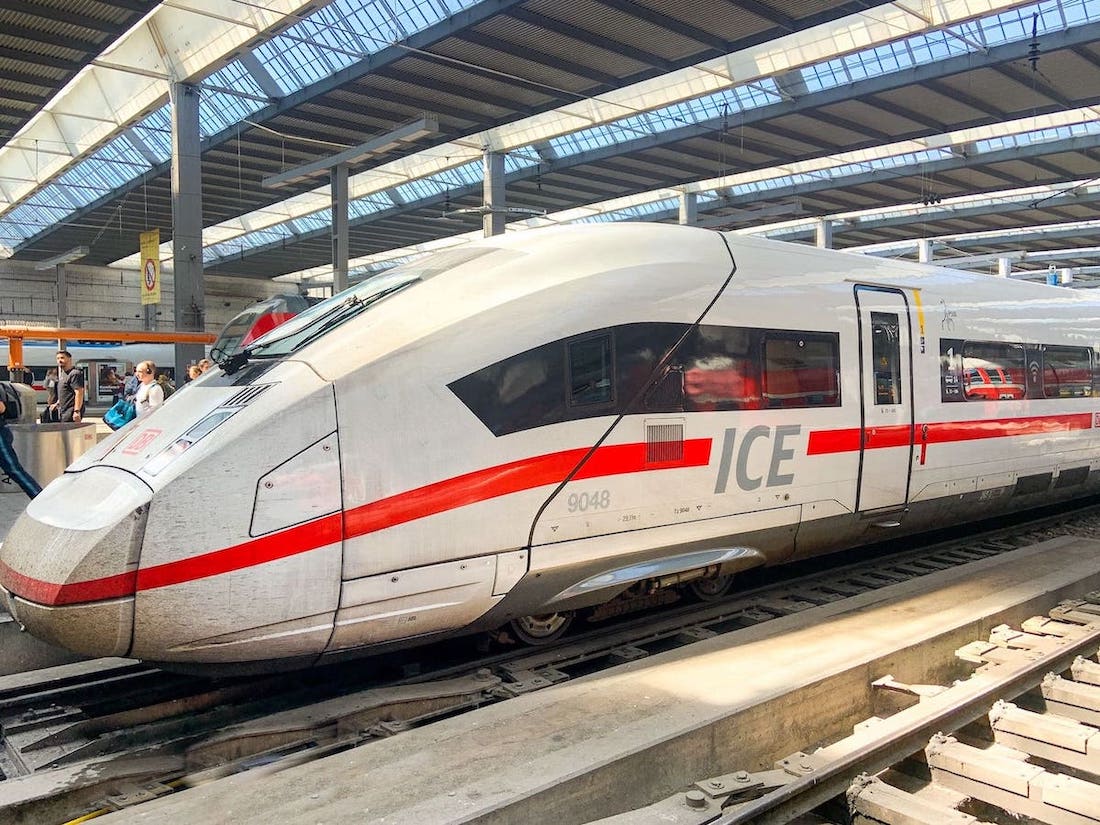
If you’re planning a trip to Germany and looking for a perfect 10-day itinerary , then you’ve come to the right place.
As Germans, we know that there is so much more to see in Germany, but if you only have 10 to 14 days, then this tour is the best way to check off all the must-sees.
We recommend taking the train as public transportation such as the bahn.com/EN“ target=“_blank“ data-type=“link“ data-id=“https://www.awin1.com/awclick.php?gid=372473&mid=14964&awinaffid=1109389&linkid=2476117&clickref“ rel=“noreferrer noopener nofollow sponsored“>Deutsche Bahn* (German train system), as it’s an easy way to travel and you won’t have to worry about parking or driving regulations in Germany.
In this blog post, we’ll take you on a journey through some of Germany’s most iconic destinations, including Berlin , Dresden , Rothenburg ob der Tauber , Munich , Heidelberg , Cologne , and Hamburg .
This 10-day itinerary will give you a chance to explore the best of Germany, from its bustling cities to charming medieval towns, stunning castles , and vibrant nightlife .
So, let’s hop on a train and discover the beauty of Germany through this 10-day itinerary.
10 day itinerary for Germany
This 10 day itinerary for Germany starts in Berlin and ends in Hamburg. If you have more time, you can easily add a couple of days here and there. It is very easy to get from Hamburg to Berlin e. g. by the train (= Deutsche Bahn), so you could also end your trip in Berlin if you want to.
Book your train tickets online
You can book all your train tickets with the bahn.com/EN“ target=“_blank“ data-type=“link“ data-id=“https://www.awin1.com/awclick.php?gid=372473&mid=14964&awinaffid=1109389&linkid=2476117&clickref“ rel=“noreferrer noopener nofollow sponsored“>Deutsche Bahn online .
Day 1: Berlin

- Check into your hotel and explore the city’s iconic landmarks, such as the Brandenburg Gate and the Reichstag building.
- Take a stroll along the Berlin Wall and visit the East Side Gallery to see the famous murals.
- Experience Berlin’s vibrant nightlife by visiting one of the many bars or clubs in the city.
Day 2: Berlin
- Visit the Museum Island, which is home to five world-renowned museums.
- Take a tour of the Berlin Cathedral and climb to the top for a stunning view of the city.
- Explore the trendy neighborhoods of Kreuzberg and Neukölln, known for their street art and diverse food scene.
Day 3: Dresden
- Travel to Dresden (2- 3 hours by train) in the morning and check into your hotel.
- Visit the stunning Zwinger Palace and the Semper Opera House.
- Take a walk along the Elbe River and enjoy the beautiful views of the city.

Day 4: Dresden
- Explore the historic Old Town and visit the Frauenkirche, a symbol of the city’s resilience after its destruction during World War II.
- Visit the Green Vault, one of the oldest museums in Europe, and see the impressive collection of jewelry and art.
Day 5: Nuremberg
- Travel to Nuremberg by train (approx. 4 hours) and check into your hotel
- Visit the Nuremberg Castle, a medieval fortress that offers stunning views of the city.
- Explore the historic Old Town and explore the famous Nuremberg Christmas Market in winter, one of the oldest and most traditional Christmas markets in Germany.
Optional if you have an extra day: Rothenburg ob der Tauber

- Travel to Rothenburg ob der Tauber and check into your hotel.
- Explore the charming medieval town and its well-preserved buildings and walls.
- Visit the famous Christmas Museum and learn about the town’s history of Christmas traditions.
Day 6: Neuschwanstein and Munich

- Travel to Munich or Füssen if you prefer to be closer to Neuschwanstein (approx. 1 to 2 hours by train) and check into your hotel.
- Take a day trip to Neuschwanstein Castle* , the inspiration for Disney’s Sleeping Beauty Castle.
- Return to Munich and explore the city’s famous beer gardens and traditional Bavarian cuisine.
Day 7: Munich
- Visit the famous Marienplatz and see the Glockenspiel, a clock tower with moving figures.
- Explore the English Garden, one of the largest urban parks in the world.
- Visit the Hofbräuhaus, one of the oldest beer halls in Munich, and enjoy a traditional Bavarian meal.
Day 8: Heidelberg
- Travel to Heidelberg by train (approx. 3 hours) and check into your hotel.
- Visit the famous Heidelberg Castle and enjoy the stunning views of the city from the castle’s terrace.
- Take a stroll through the charming Old Town and visit the historic university.
Day 9: Cologne
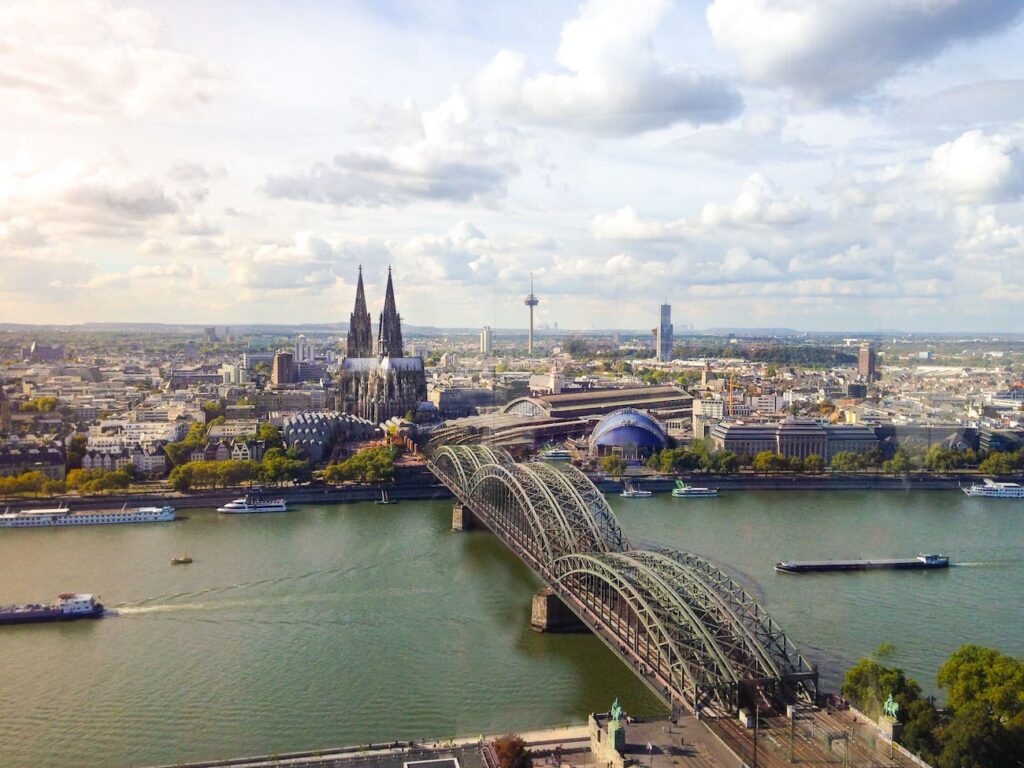
- Travel to Cologne by train (approx. 2 hours) and into your hotel.
- Visit the iconic Cologne Cathedral, a UNESCO World Heritage Site and one of the largest Gothic cathedrals in Europe.
- Explore the lively bar-scene in the city, particularly in the trendy neighborhoods of Ehrenfeld and Belgisches Viertel.
Day 10: Hamburg
- Travel to Hamburg by train (approx. 4 hours) and check into your hotel.
- Visit the famous Elbphilharmonie, a stunning concert hall with breathtaking views of the city.
- Explore the historic warehouse district of Speicherstadt and take a boat tour of the canals.
- End your trip by visiting the trendy neighborhoods of St. Pauli and Sternschanze, known for their vibrant nightlife and street art.
FAQ: 10 days in Germany
How many days is ideal for germany.
10 to 14 days is an ideal duration to explore Germany, allowing you to visit some of the most iconic destinations, including Berlin, Dresden, Rothenburg ob der Tauber, Munich, castle Neuschwanstein.
Is it worth going to Europe for 10 days?
Yes, it is worth going to Europe for 10 days. It gives you a taste for European culture and history. After 10 days you probably want to spend even more time Europe.
Is 10 days in Germany enough?
10 days in Germany is a good amount of time to explore some of the country’s most iconic destinations, but there is still so much to see and do. It depends on your interests and travel style.
How much does a 2 week trip to Germany cost?
The cost of a 2-week trip to Germany can vary depending on factors such as accommodation, transportation, food, and activities. While groceries are fairly inexpensive in Germany, the costs of accommodation can add up.
Conclusion: 10 day itinerary for Germany
In conclusion, Germany is a country that truly has something for everyone. You can easily discover by Germany by train, there is no need to take a rental car if you don’t want to.
From the bustling cities such as Berlin or Cologne to charming medieval towns like Rothenburg ob der Tauber, stunning castles like Neuschwanstein, and vibrant nightlife, this 10-day itinerary will take you on a journey through some of the most iconic destinations in Germany.
Whether you’re into history, a foodie, or just looking for a fun adventure, Germany won’t disappoint.
While 10 days is a great amount of time to explore some of the country’s most popular destinations, there is still so much more to see and do.
So, pack your bags and get ready for an unforgettable adventure in Germany!
Anna and Anne are the founders of Germany Things To Do. They grew up in Germany and have traveled all 16 regions in Germany from North to South and East to West.
They share their local tips with you to explore the authentic and beautiful parts in Germany.

How to Take the Train in Germany: A Step by Step Guide!
Last Updated: March 21, 2024
*FYI - this post may contain affiliate links, which means we earn a commission at no extra cost to you if you purchase from them. Also, as an Amazon Associate I earn from qualifying purchases. Check out our Privacy Policy and Disclosure. for more info.
When it comes to the German rail system, I think one thing you could definitely say is… I have a LOT of feelings about it.
Train travel in Germany is a truly funny and misunderstood thing, shrouded in a romantic cloud of efficiency, speed and scenic bliss.
But while German trains are leaps and bounds better than train travel in many countries, it is far from the flawless and simple utopia many of us imagine in our heads.
From awkward seat shuffling and breathless running to impatient inspectors and stunningly muffled announcement quality, German train travel is a piece of work that, like a marriage, requires years of learning, understanding and patience.
Don’t worry though – I’ve endured the marital strife so you don’t have to. I lived in Germany for over five years, exploring the country (mostly) by train, and today I’m going to walk you through the process, from start to finish.
I hope you find it helpful!

Save this guide on how to travel Germany by train for later!
You’ll be very glad you did.
A Brief Introduction to the German Rail System
Let’s start with some basics on taking the train in Germany, which involves the largest rail network in Europe and over 33,000km of track!
Rail Providers in Germany
Operating over 40,000 trains a day, Deutsche Bahn is the national rail provider in Germany responsible for the vast majority of trains in the country.
When it works, it works great. However, when there are delays, travelling with them can be a bit of a nightmare, which is why the brand has become the butt of countless jokes regarding delays and high prices.
But bear in mind these jokes are often made by Germans who don’t realize how bad train systems can be in other countries.
Honestly, compared to many countries like Canada where I’m from, the German train system is fantastic, and still my go-to mode of transport around Germany.
It’s far from flawless but it’s still pretty great, especially when boarding at hubs like my former home of Munich, since there’s far fewer delays at the start of a journey!
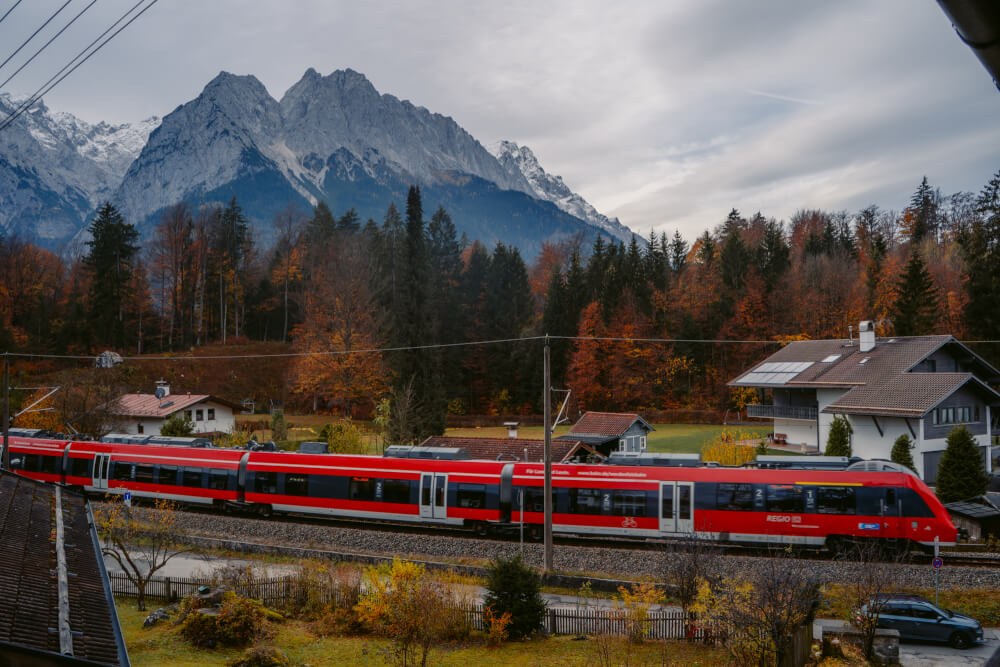
Another train operator you can consider in Germany is FlixTrain.
I’ve personally never taken them because in the time I lived in Germany, they were operating really limited routes and I still haven’t had a chance to try them. That said, their value proposition is super cheap fares starting at only 4.99 euro so definitely worth looking into if budget is a priority.
Flixtrain is fairly no frills – they only have one standard class and the buying process is straightforward so the rest of this post will focus on Deutsche Bahn trains and tickets.
NOTE: If you do book with Flixtrain though, be sure to double check that you are in fact booking a train, because this company also owns Flixbus, one of the biggest bus companies in Europe, and they’ll often show you buses alongside trains.
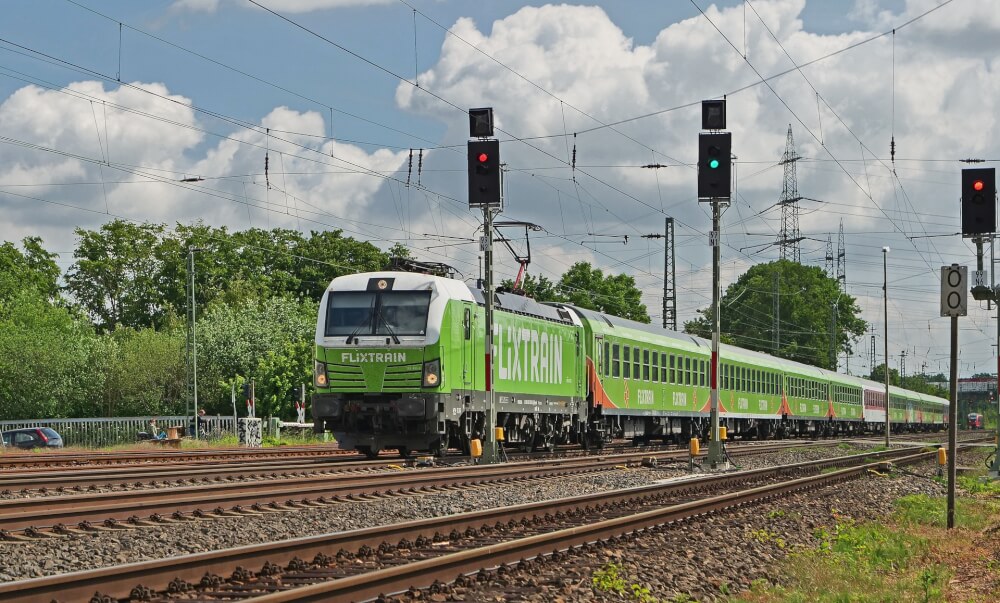
Now, let’s discuss…
Types of Trains
Broadly speaking, we can divide German trains into two three categories: long distance, regional, and local, such as S-Bahn or U-Bahn trains.
Understanding the difference between these is important, as they make a huge difference in journey time and cost, so I’m going to run through the most common ones, along with their abbreviations that typically show up in the train numbers and booking portals.
Long distance trains in Germany are used to connect larger cities and are therefore usually quicker, but typically require booking in advance, with reservations being a good idea in busy periods.
Under the German long distance train umbrella, we have…
- ICE: InterCityExpress trains, which are the fancy, high speed trains that get you between major cities, and can go up to 300km an hour. Especially quick are the ICE Sprinter trains which make even fewer stops than normal.
- IC: Intercity trains, which also travel between cities in Germany but are sometimes a bit slower than the ICE ones (maxing out at about 200km an hour) and often not as new or nice.
- EC: Eurocity trains, which travel between cities in Germany and elsewhere in Europe. These can look different than usual Deutsche Bahn trains because depending on the route, they may be operated by another country’s rail provider.
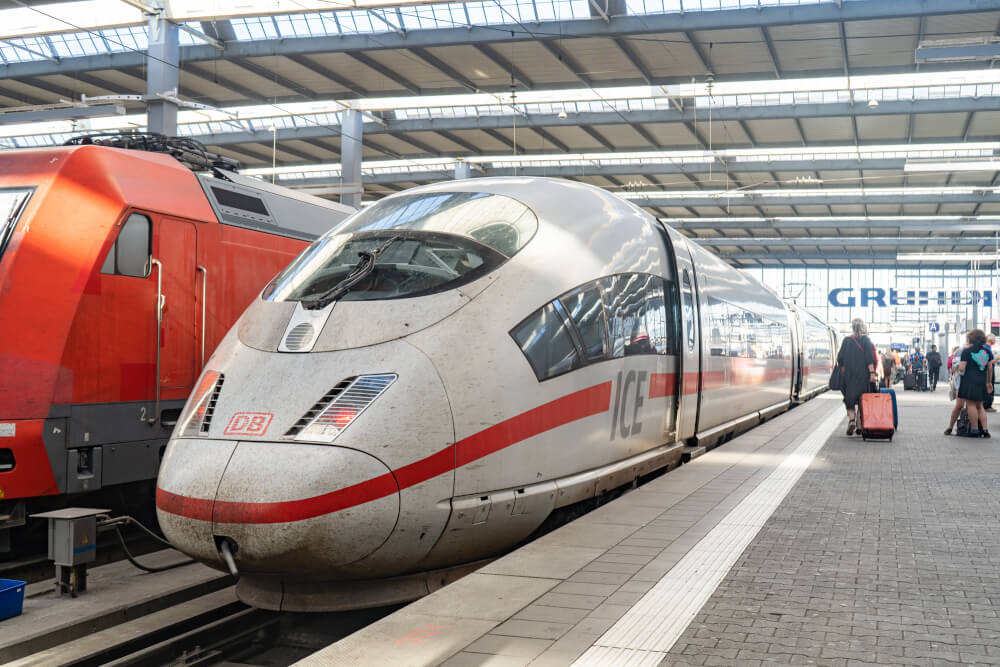
In contrast, regional trains cover shorter distances, typically within one state or region.
Reservations and assigned seats are not possible for these trains, their prices are fixed so buying in advance isn’t necessary, and they’re covered by a range of special deals which I’ll go over later.
Under this regional train umbrella, we have…
- IRE: Interregio-Express trains, which travel longer distances between regions but usually at much slower pace than the long-distance trains (and are therefore classified as a regional train as far as special deals are concerned)
- RE: Regional Express trains, which connect destinations in one region, but don’t stop at every stop on the route which can be faster than the…
- RB: Regional Bahn trains, which connect destinations in one region and do stop at every stop along a particular route
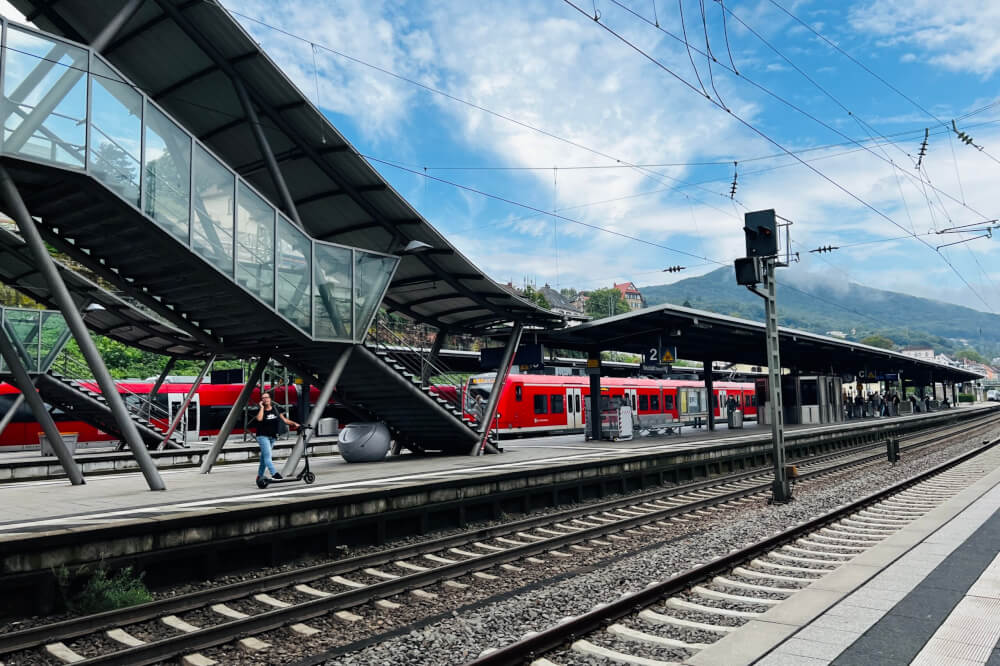
Lastly, on the local train front, we have options like…
- S-Bahn, which are trains that connect stops within cities and out to nearby suburbs, as well as…
- U-Bahn (in some cities) which are underground trains that connect stops within the city itself like the Subway or Metro
These are also typically covered by the special deals we’ll be discussing below.
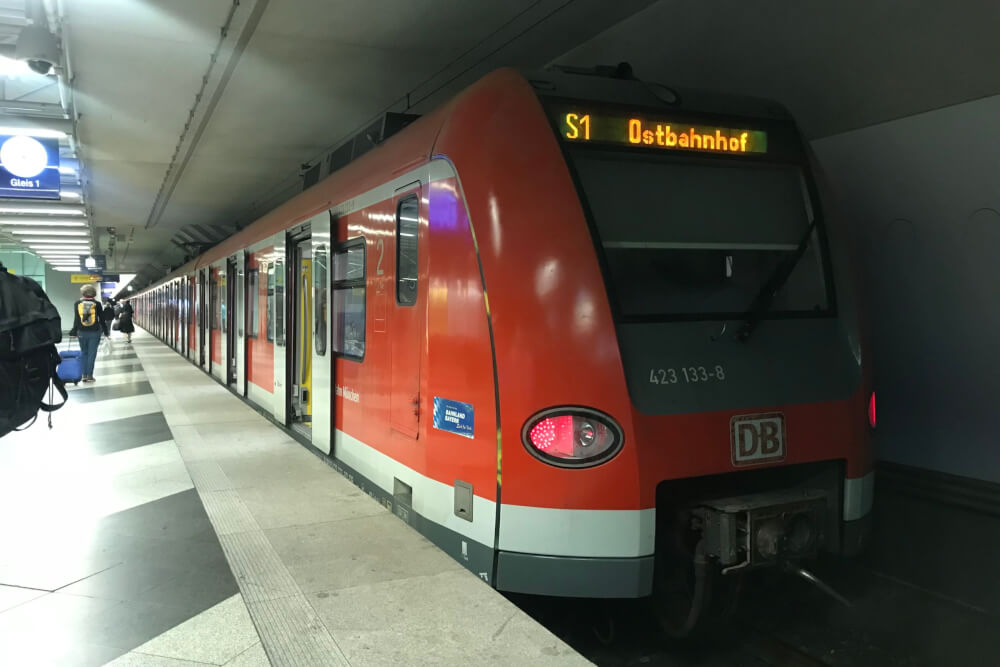
Now, with the basics covered, let’s go through step by step how to plan a train trip in Germany.
Step One: Decide if Train Travel in Germany is Right for You
First – let’s talk alternatives to train travel in Germany.
I’m a huge fan of German train travel, but there are other options for getting around that may be better suited to your specific trip and priorities.
Overall, I think taking the train in Germany is great if you’re looking for convenience, comfort and scenery.
The downside is however it can be quite expensive, especially if you don’t book in advance. It’s also not super convenient if you’re travelling with a lot of luggage (more than one big suitcase per person).
A more budget-friendly alternative may be taking buses, booking a ride share on services like BlaBlaCar or sometimes even flights if you’re booking with budget airlines like Ryanair , easyJet and Wizz Air .
Or, if your priority is freedom and getting off the beaten path, it may be worthwhile to rent a car.
Overall, if you’re torn and want to compare all your options at a glance, Omio is a great app that shows you planes, trains, and buses from Point A to Point B. From there, you can gauge whether train travel suits your needs.
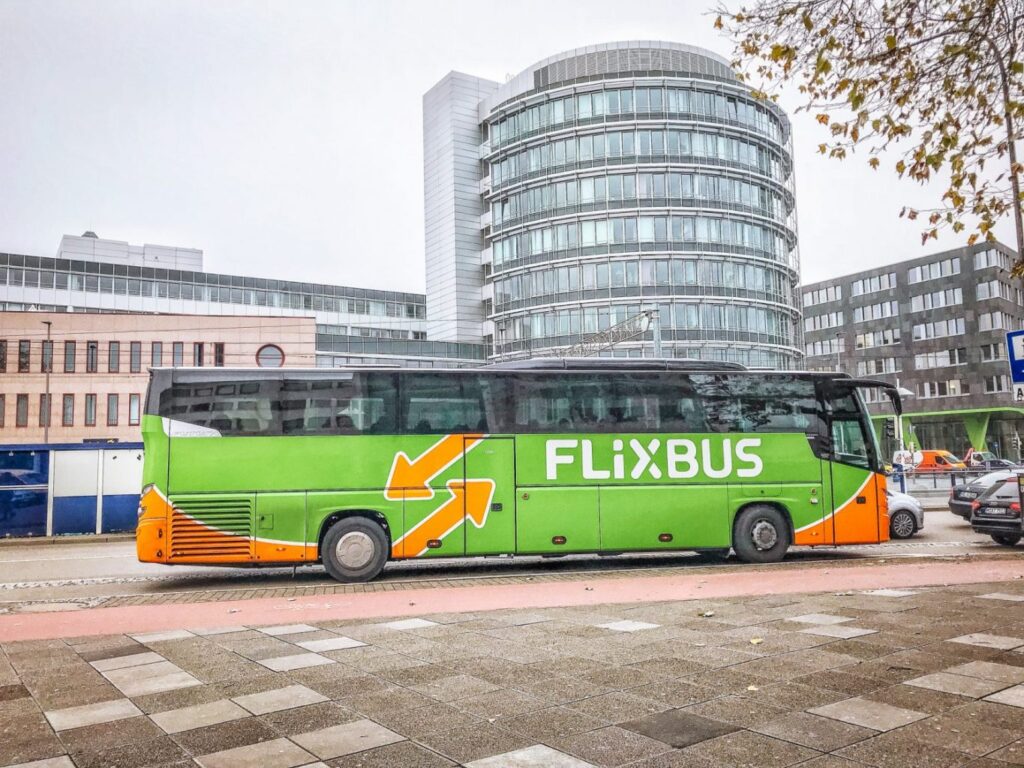
If/when you’ve decided you do indeed want to take the train, then we move onto…
Step Two: Buy Your Germany Train Tickets
The pricing of trains in Germany is dynamic, meaning the cost changes depending on when you buy it and what demand is like.
It is totally bananas to me that a ticket, when booked early, can be 20 euros but if you wait until the day before/day of it can go up to 180 euros.
But alas, I do not make the rules. If I did, everyone would get a free on-board puppy.
In any case, I’d advise booking tickets in advance online, because buying them on board isn’t usually possible, and buying in person from the information desk at the station does incur an extra service fee.
You can also buy tickets on machines at the station but I feel like this adds an extra element of stress, so be sure to book in advance whenever possible.
Now, there are a lot of considerations to be made when you go to buy train tickets in Germany. I’ll outline them all now.
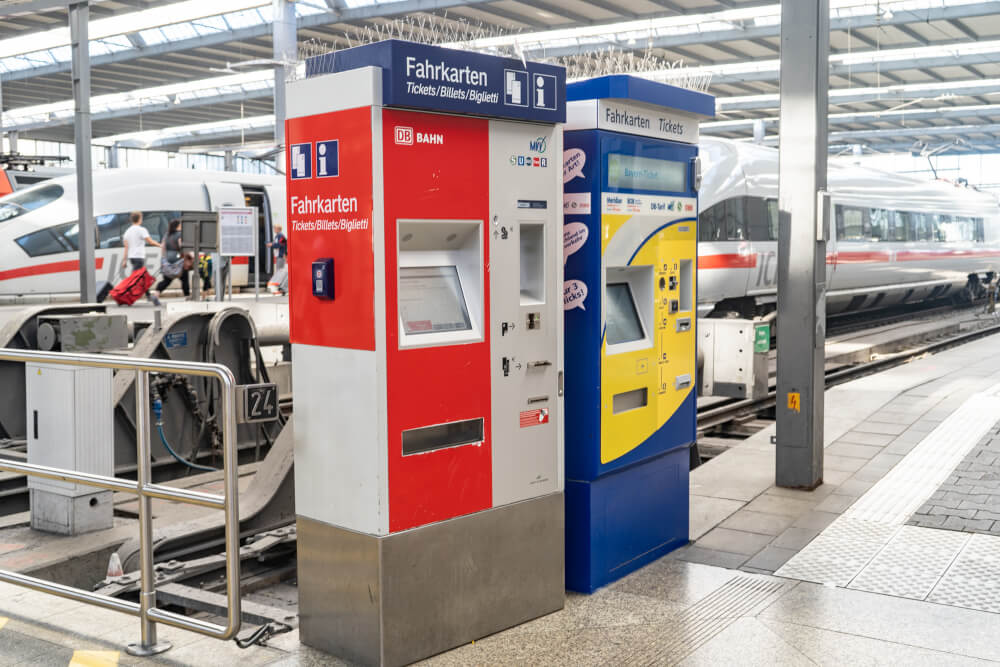
First off…
BahnCard vs No BahnCard
If you plan to stay a while and take a lot of trains in Germany, it may be worthwhile to purchase something known as a BahnCard.
These are cards that you purchase for a set fee that then give you discounts on most train journeys, either 25% or 50% depending on which one you buy.
While these cards are definitely more geared towards locals than tourists, sometimes the discounts can be so significant that you can make the cost up in just a few journeys, so it’s worth crunching the numbers.
Especially interesting for short term visitors are the Probe Bahncards, or Trial cards which allow you to buy a cheaper membership that’s essentially a trial for 3 months, rather than for a whole year.
These start at just 17.90 for the three months, an amount you can easily make up if you’re buying an expensive long-distance or last minute ticket. Just don’t forget to cancel your subscription 6 weeks before the expiry date, or it auto-converts to an annual one that of course costs more.
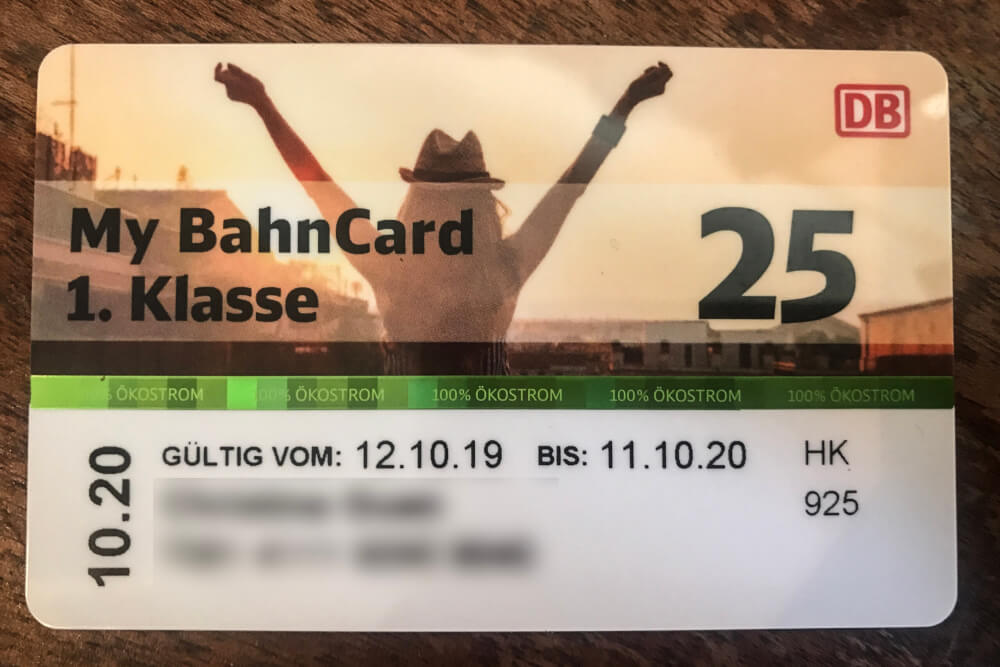
Honestly though, for most tourists visiting for a short time, there are better ways to save money on German train tickets.
So let’s move onto our next consideration which is…
Standard Tickets vs. Special Tickets or Rail Passes
If you are only booking a few train journeys during your time in Germany, the best option is most likely to just buy tickets for the journeys you’re taking, meaning hopping on the Deutsche Bahn app or website, entering Point A to Point B and buying tickets for each trip you plan to take.
Sometimes though this won’t be the way to get the best deal. So, I’m going to outline some options that may save you money depending on your circumstances.
First off – do know that there are age based discounts on Deutsche Bahn for the following groups:
- (FREE!) Children 6 & under
- (FREE with parents or grandparents) Children aged 6-14
- Youth (aged 15-26)
- Senior (age 65+)
So, to activate these discounts, be sure to specify your age and the age of those travelling with you when you go to search routes.
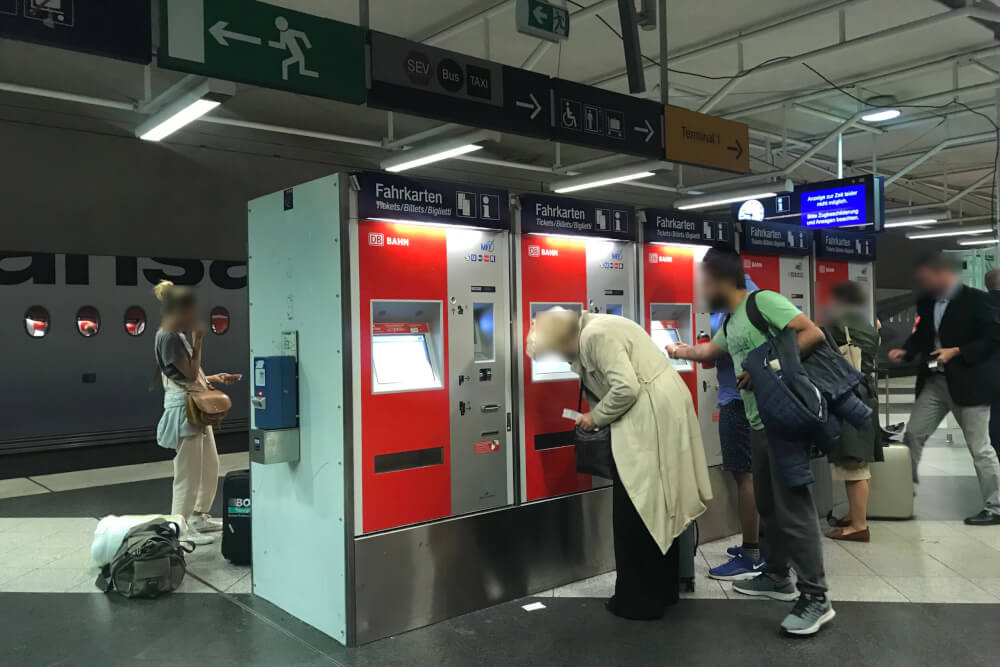
Now, if you are looking to save money on regional and local trains in Germany, there are few excellent options that are almost guaranteed to save you money, especially for day trips.
With one of these, you can genuinely save hundreds of euros over buying individual tickets the day-of.
If your travels are restricted to one German state, then look into buying a regional day ticket (known in German as Länder-Tickets ). These give you unlimited travel on regional trains for one day, with options up to five adults on one ticket.
The savings with these are also better the more people you bring, with a base fee, then a small additional fee for every extra person, so definitely worth considering if you’re travelling in a group.
Here are the different regional tickets you can buy:
- Baden-Württemberg-Ticket
- Bayern-Ticket
- Brandenburg-Berlin-Ticket
- Hessen-Ticket
- Mecklenburg-Vorpommern-Ticket
- Niedersachsen-Ticket
- Rheinland-Pfalz-Ticket
- Saarland-Ticket
- Sachsen-Anhalt-Ticket
- Schleswig-Holstein-Ticket
- SchönerTagTicket NRW
- Thüringen-Ticket
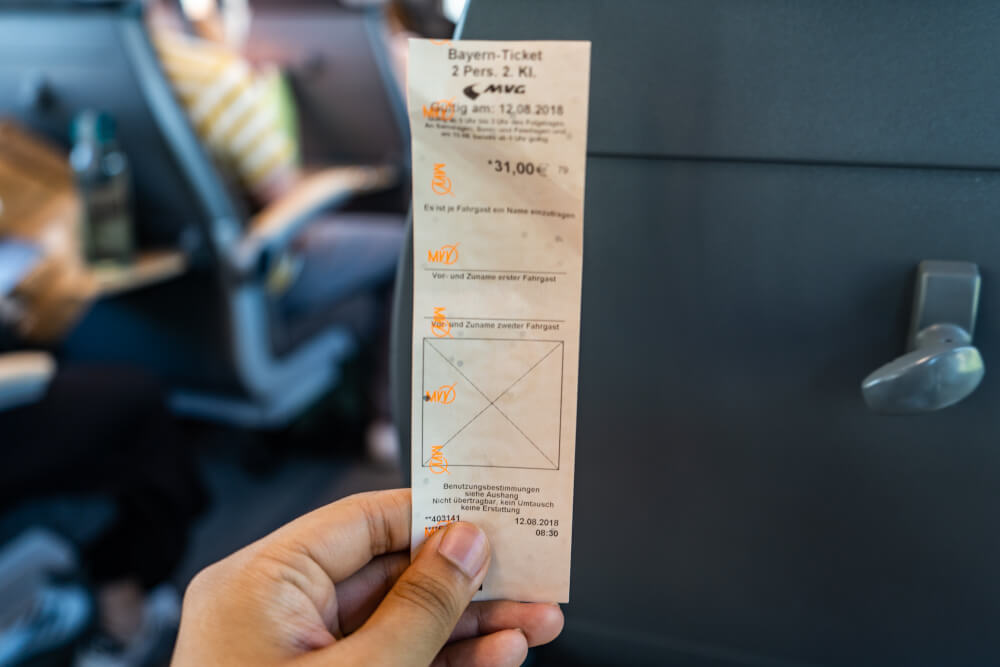
They also have a Germany-wide version of this ticket if you plan to travel across states, known as the Quer-durchs-Land-Ticket.
BUT, an even better deal if you plan to use regional trains exclusively across Germany is a relatively new offering known as the Deutschland ticket.
This golden ticket is only 49 euro a month and gets you unlimited travel on regional trains for that whole month. Considering a one-day Quer-durchs-Land Ticket is already 44 euro, getting the Deutschland Ticket is pretty much a no-brainer if you’ll be taking regional trains for more than one day.
BUT the catch is, this ticket is more geared towards locals, and therefore is offered on a subscription basis. So long as you cancel your subscription in time though, then you can easily just use it for one month or as you need.
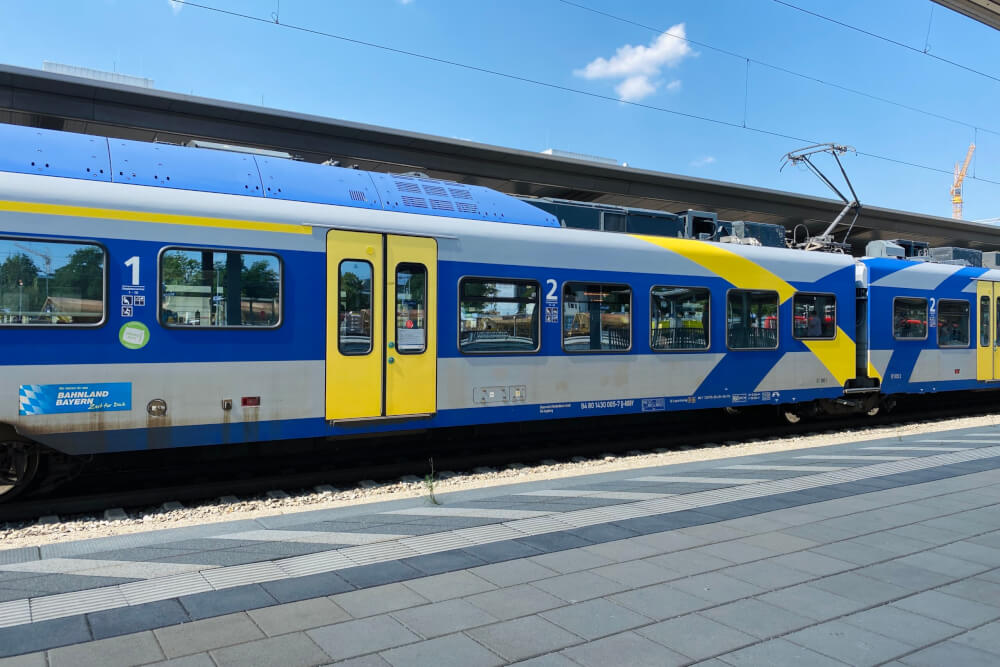
Unfortunately, saving money on long distance trains is less simple. Generally, your best bet is just booking early. The earlier you book, the cheaper it’ll be.
If you can’t book in advance though, a potential cost saver could be a rail pass.
If you are just travelling within Germany, there is a German rail pass you can buy for unlimited journeys either on a flex basis, meaning for a few days within a set period or on a consecutive basis, meaning a set number of days in a row.
If you are travelling to other countries in Europe, it may be worth getting a Eurail pass , also known as an Interrail Pass when you’re a resident of Europe.
Used properly, these passes can save you a lot of money, but only in certain situations so for more information on that, be sure to read my full Eurail review.
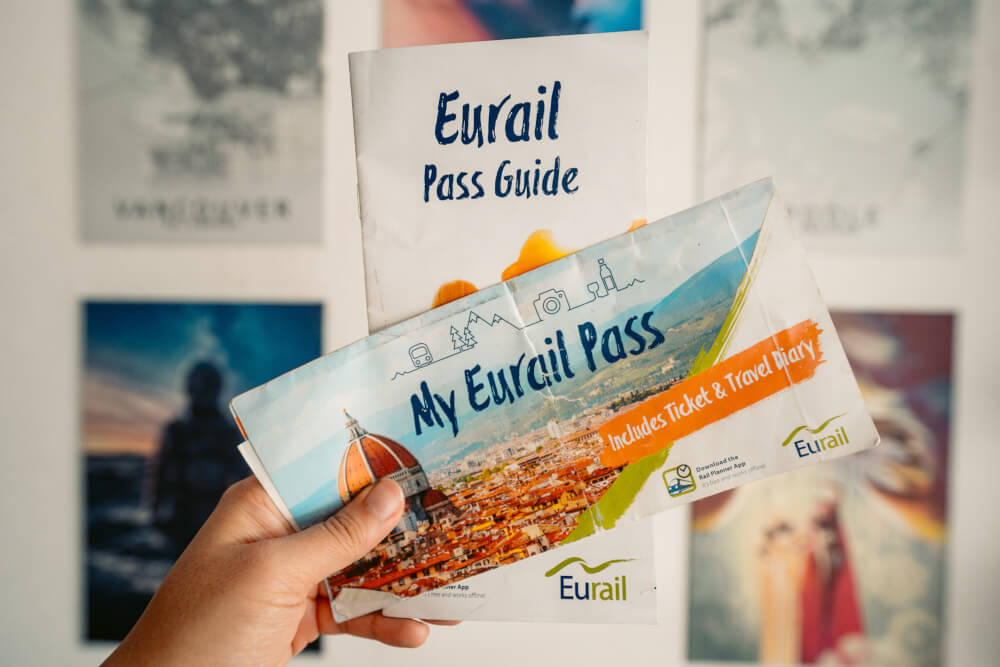
Now, when you go to buy tickets, you can either do so in person or online.
Online, you can either buy tickets directly through Deutsche Bahn (website or DB Navigator app) or through a third party website.
Booking direct with Deutsche Bahn will pretty much always be the cheapest option, but if you’re planning a big trip with lots of trains or buses in other countries, then a 3rd party like Omio or Trainline might be worth it just to keep all your tickets in one place.
NOTE: When choosing your journey, always prioritize direct connections or routes that make fewer stops. These will usually cost more, but trust me, it’s worth every penny! Transfers are simple enough when trains run on time, but as soon as you’re hit with a delay, that can disrupt your entire journey and make things 100x more stressful.
Whether you buy from Deutsche Bahn or from a third party though, there are several considerations to make, so I’ll run through them now.
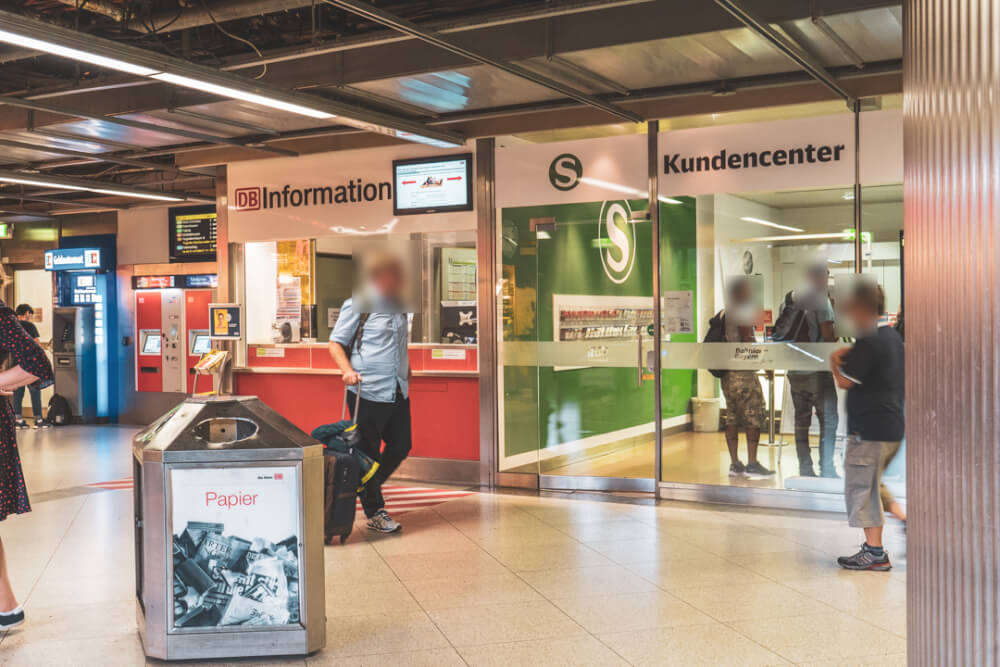
1st vs 2nd class on German Trains
The first time I got to sit on a 1st class German train, I had extremely high expectations.
Part of my brain flashed to a sepia-toned flashback of glamour train travel in the 60s, with fizzy champagne flowing and a steak dinner served right to my seat. I knew this wasn’t going to happen, so I dialled it down. I once took a first class train in Italy and they gave us coffee and snacks. I therefore looked forward to said coffee and snack.
German trains? You get pretty much nothing. So no, the difference isn’t stark, but there are some instances where I think splurging on first class is worth it.
On regional trains, there isn’t a dramatic difference between first and second class seats.
The main perk is it’s generally quieter and sometimes the seats are slightly comfier. So, I would go for first class in regional trains if a) the price difference isn’t much/doesn’t matter, b) you want extra privacy or c) it’s a busy time and you want to secure your chances at having a seat (and space for your stuff).

On long distance trains however, there’s definitely a bigger difference between first and second class, especially on ICE trains.
In first class, the seats are more comfortable, a reservation is included, you can get food/drinks ordered to your seat, and for introverts like me, there are even single seats you can reserve so you don’t have to sit next to anyone.
If any of these perks sound appealing to you, then I’d say it’s worth the extra cost (which is sometimes minimal if you book early enough).
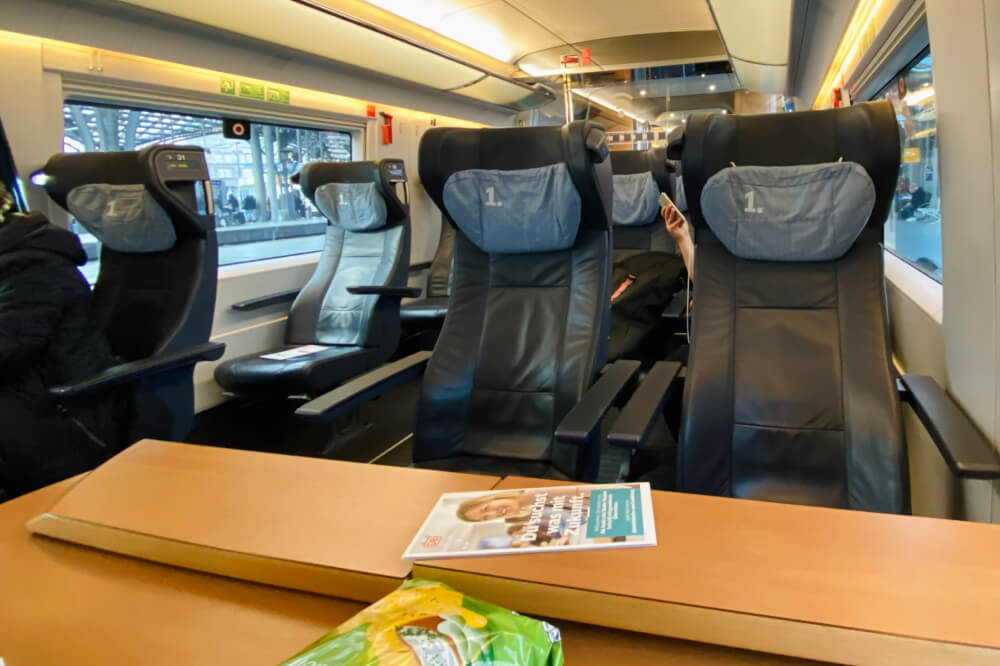
The next consideration is…
Reserved vs. Unreserved seats
Reservations are pretty much never mandatory on German long distance trains, and aren’t even possible on regional trains, S-Bahn or U-Bahn.
That said, I would highly advise making a reservation if you’re at all an anxious traveller, or if you’ll be travelling during a busy period.
The cost is only about 5 euro and having that peace of mind for me is more than worth it.
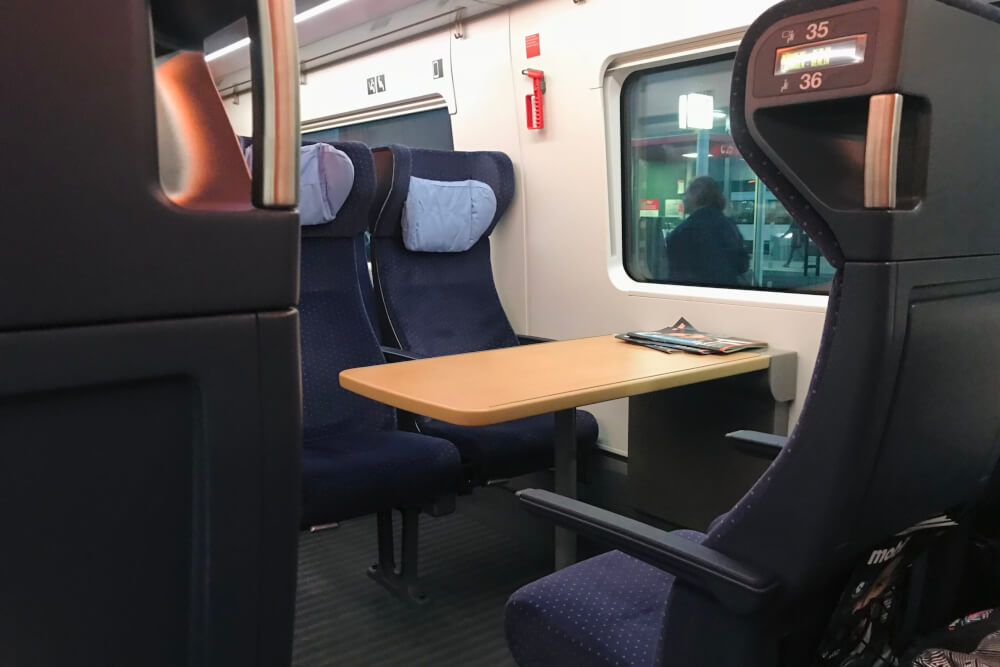
If you do end up reserving a seat, another consideration is…
Carriage and Seat Types
Some trains in Germany have different carriages intended for different purposes, such as…
- Silent/quiet carriages
- Cellphone carriages (where you can freely make calls)
- Family areas
- Bike zones (with additional space)
- Accessible zones
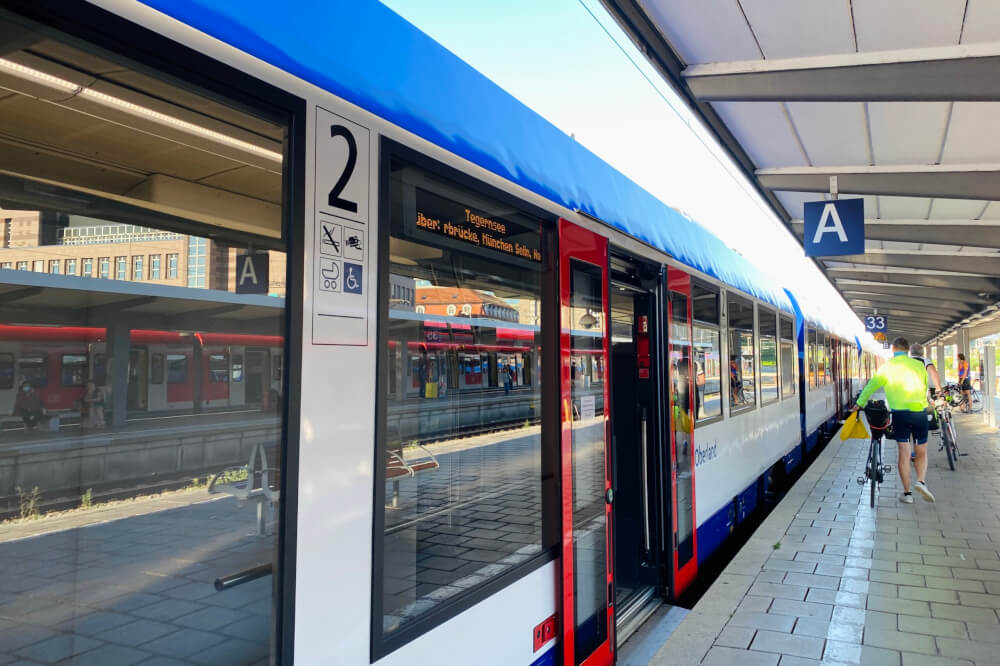
There are also different seating configurations for many long distance trains, with the two main choices being:
- Open saloon seating, which is your standard train set-up with seats in a carriage, sometimes with a table around which 4 people can sit facing each other OR
- Compartment seating, which are more old school closed compartments with seats facing each other. These are fun if you get them to yourself, or with your own group but can be a bit intimate if you’re sharing with strangers
You’re usually given an interactive map when you book a reservation, so you can also make other considerations like window vs aisle or how close you are to amenities like the bathroom, luggage racks or the on board restaurant.
Be sure to take some time to consider which seat you might want to reserve – not all seats are made equal!! With seats at the end of cars for instance, people will be coming in and out constantly to go to the bathroom, which isn’t ideal if you’re looking for a peaceful journey.
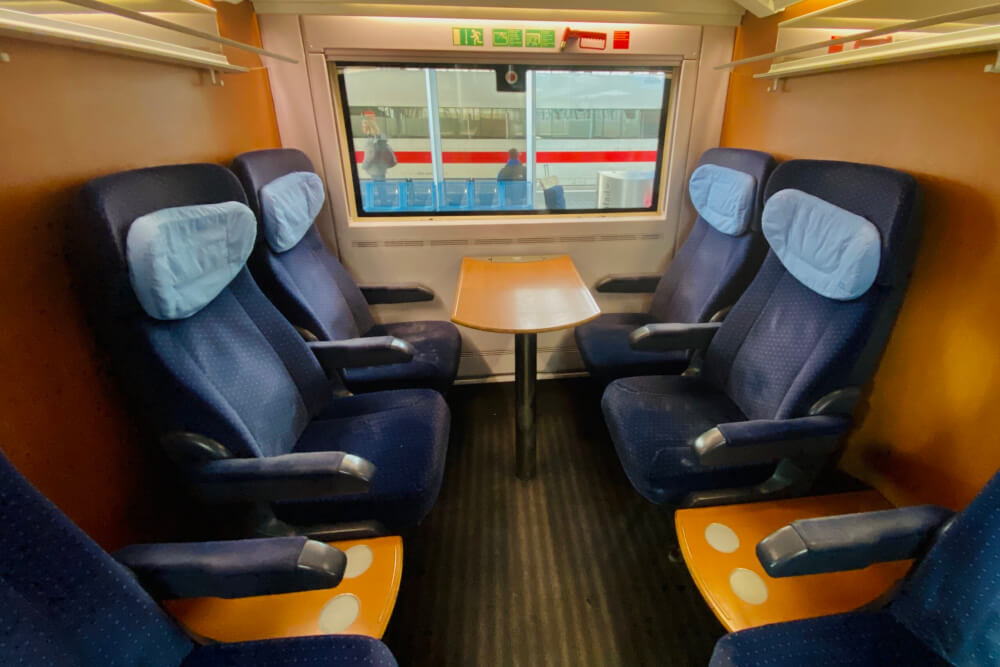
Another choice you’re given when buying tickets is…
Flexpreis vs Sparpreis
Essentially these are different versions of the same ticket, and make no impact on the destination/route, but do impact how flexible the terms of your ticket are.
The Sparpreis is essentially a ticket that is only valid for that one train and time you’re booking. In exchange for this lack of flexibility, the fare is much cheaper, especially with the Super Sparpreis (which is most limited in flexibility).
In contrast, the Flexpreis ticket gives you a lot more flexibility, usually allowing you to travel on any train that day for your chosen route, or with the Flexpreis Plus, even trains the day before or two days after.
Overall, I feel like the price difference is rarely justified for these Flexpreis tickets (sometimes it’s more than 5x!), but do what’s right for your own trip and priorities.

Lastly, there’s…
Bike/Pet Add-Ons
If you are travelling on German trains with a bike or with a pet, know that you’ll typically need to buy an additional ticket for them.
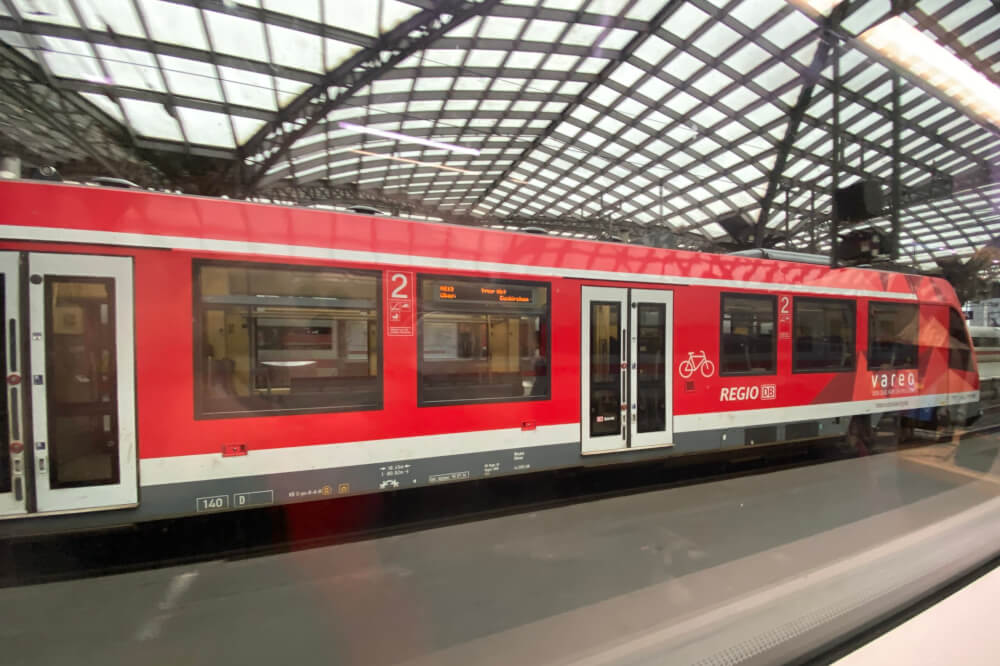
Alright with your tickets booked it’s time to move onto the day of your journey, with…
Step Three: Get Snacks
On the day of your journey, I highly recommend you get some food and drink to bring with you on the train (especially for longer trips). This is completely allowed on German trains!
While there are usually some food options on board with long distance trains, they tend to be fairly limited and pricey, so getting your own gives you more control. On regional/local trains, there is no food or drink sold on board at all.
So, at the very least, I’d get some water or something to drink. There’s often great options even at the train station itself.

Now let’s move onto…
Step Four: Arrive at the Station
First off, before leaving, double check that you are headed to the right station. Many major cities will have multiple stations like Munich, which has its Hauptbahnhof (Main Station) as well as Ostbahnhof (East Station) and other smaller ones.
If it’s your first time at this station, and if you’re in a big city, I recommend you arrive thirty minutes or more in advance of your departure time, because main stations in cities like Berlin, Munich & Hamburg can be very overwhelming, with multiple levels, shops and 20+ platforms.

Now, if you are taking public transport and arriving at the train station in a big city, you might find it tough to find where the trains actually are, because often these stations are multi level transport hubs servicing U-Bahn, trams and buses as well.
In any case, all you need to do is look for train symbols on signs like this which will point you in the direction of the platforms:
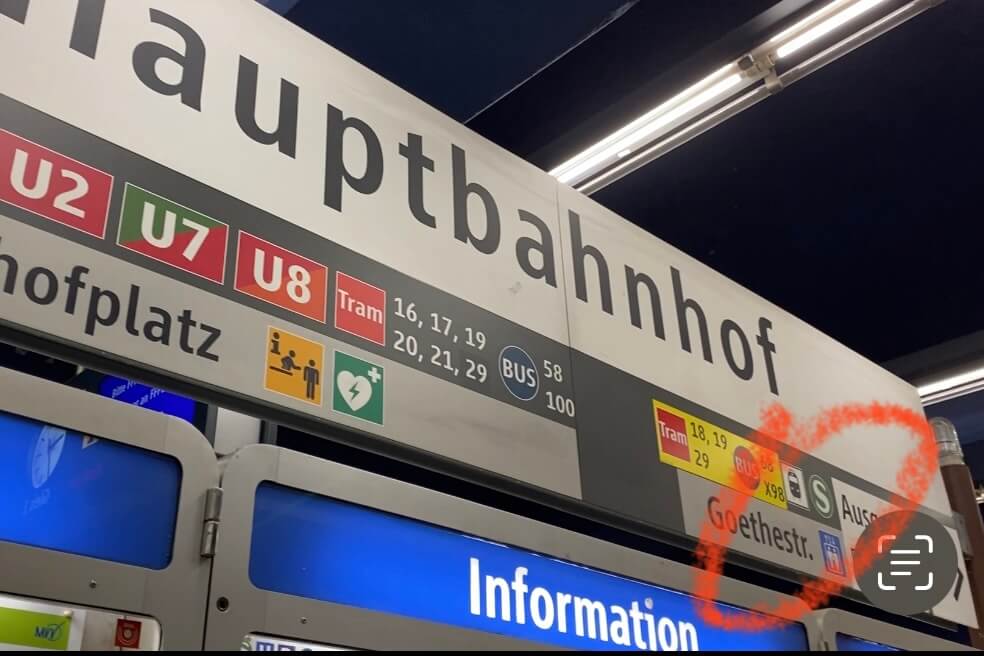
Now when you get to the station’s main concourse, your priority is finding out which platform your train is on. The Deutsche Bahn app will usually tell you in advance but I like to double check on the board just in case.
When looking at the board, remember that trains will not necessarily say your destination, but rather the final destination of the train, so if you don’t see the name of where YOU’RE travelling to, don’t panic.
Look for the time and train number, and (when available) the list of stops to see if your destination is listed, then figure it out from there. Beware that some cities like Munich and Cologne have a different name in German (München & Köln) and that’s likely the name that will show.
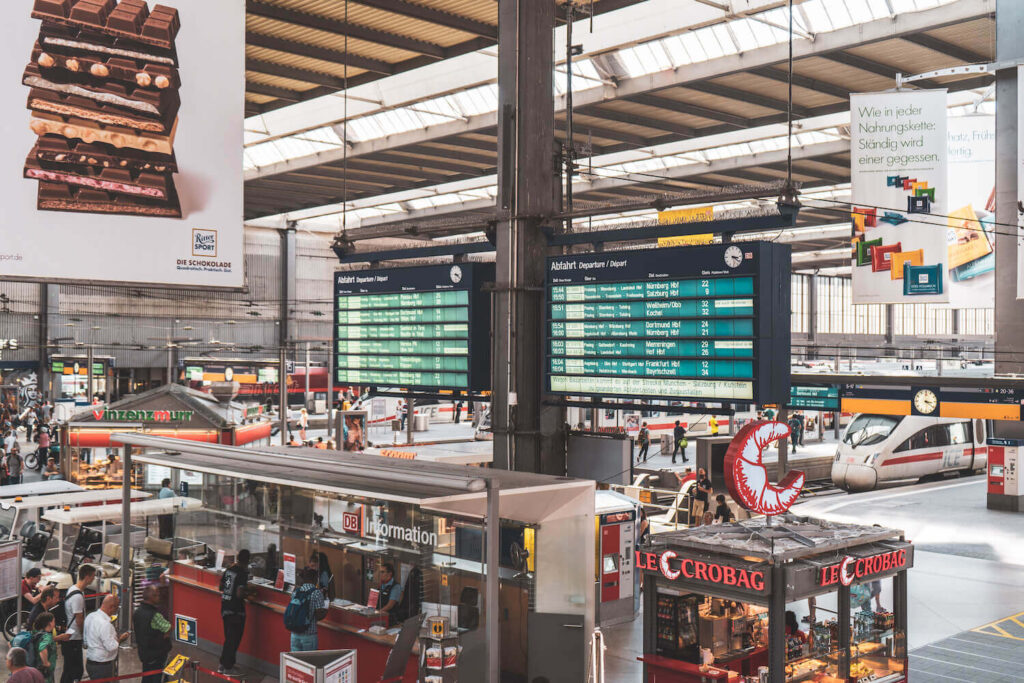
Next, it’s time to…
Step Five: Get to the Platform
Platform numbers will generally be very well marked so just look up for signs before making your way.
You will not need to have your ticket for this part, because there are no fare gates for German trains, and tickets are usually just checked on the train itself.
When you get onto your platform, double check it’s correct by confirming either on a platform screen or on the side of the train that you’re in the right place before proceeding to find your carriage.
NOTE: Some regional trains in Germany are divided trains that split at one point in the journey, which means only certain cars end up going to certain destinations. So, before you board, double check that the destination on your train carriage is actually where you want to go. In cases where the train splits, the sign will usually tell you which cars or which part of the platform to go to for your destination, so keep an eye out for that.
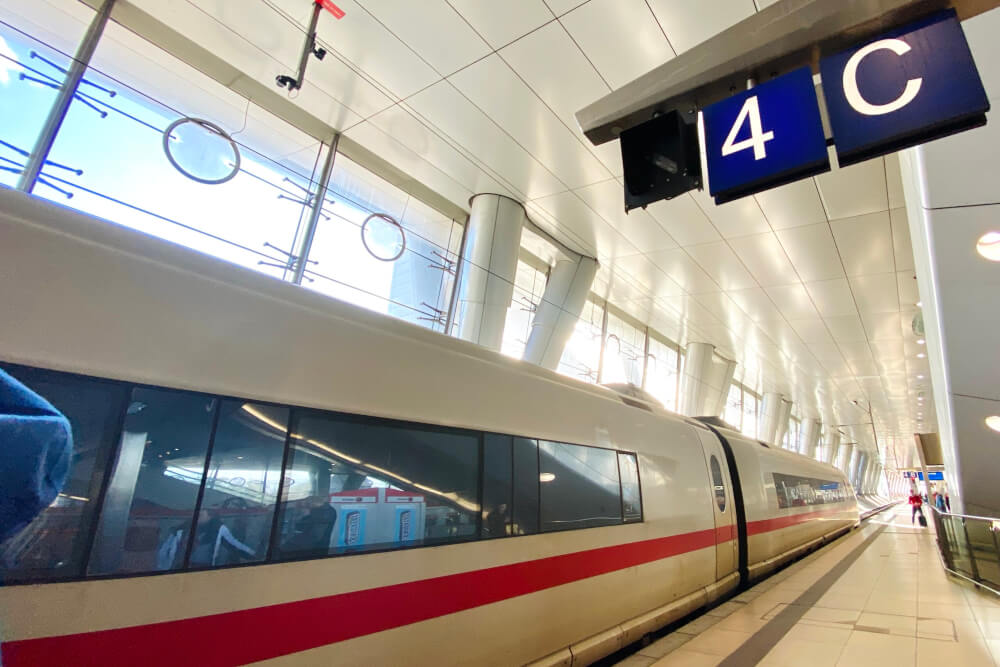
Next up, it’s time to…
Step Six: Find Your Carriage
If you have a reserved seat, then you’ll need to take some extra steps to make sure you get to the correct carriage once the train arrives.
German trains can be very long, so if you have a seat reservation, make sure you’re standing in the right part of the platform to get onto your carriage, otherwise you’ll have to awkwardly dodge and shuffle your way all throughout the length of the train.
With reserved seats, a handy thing to look out for are these charts that show you which part of the platform to stand on (marked by number/letter) depending on your carriage number.

If you do not have an assigned seat, then you simply need to board a carriage in the right class, then pick a free seat.
In these cases, look up at the platform sign and there should be a little diagram that explains which letter part of the platform to stand on for 1st class, 2nd class, and the meal car (depicted by a tiny knife and fork).
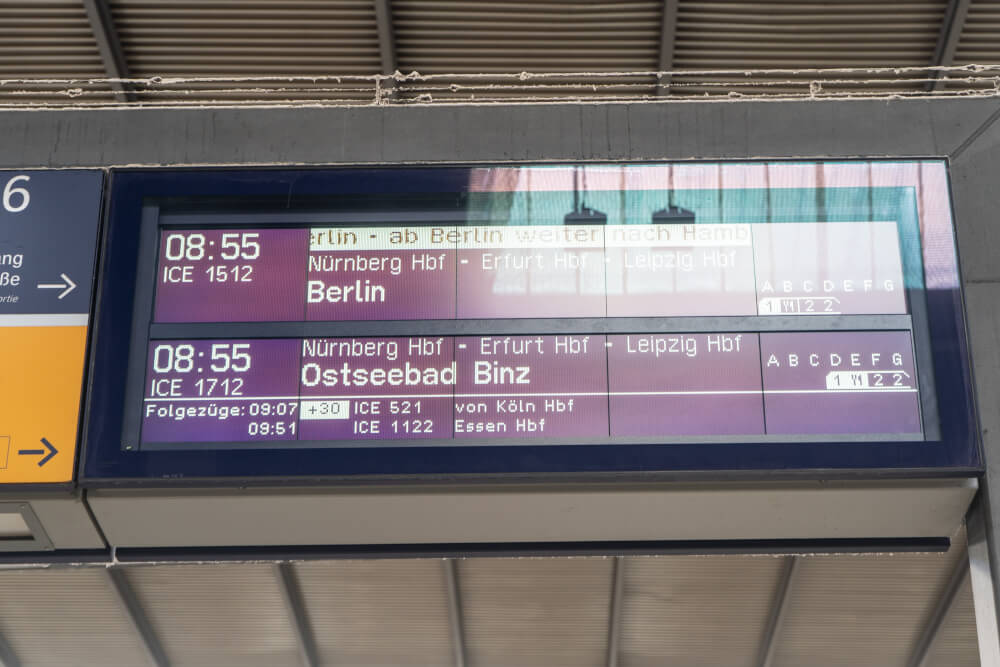
When picking a carriage to board, pay special attention to…
- The class number of the carriage (you may only board the class you’ve booked for)
- Whether they are special carriages meant for a certain purpose e.g quiet zone, bicycle zone
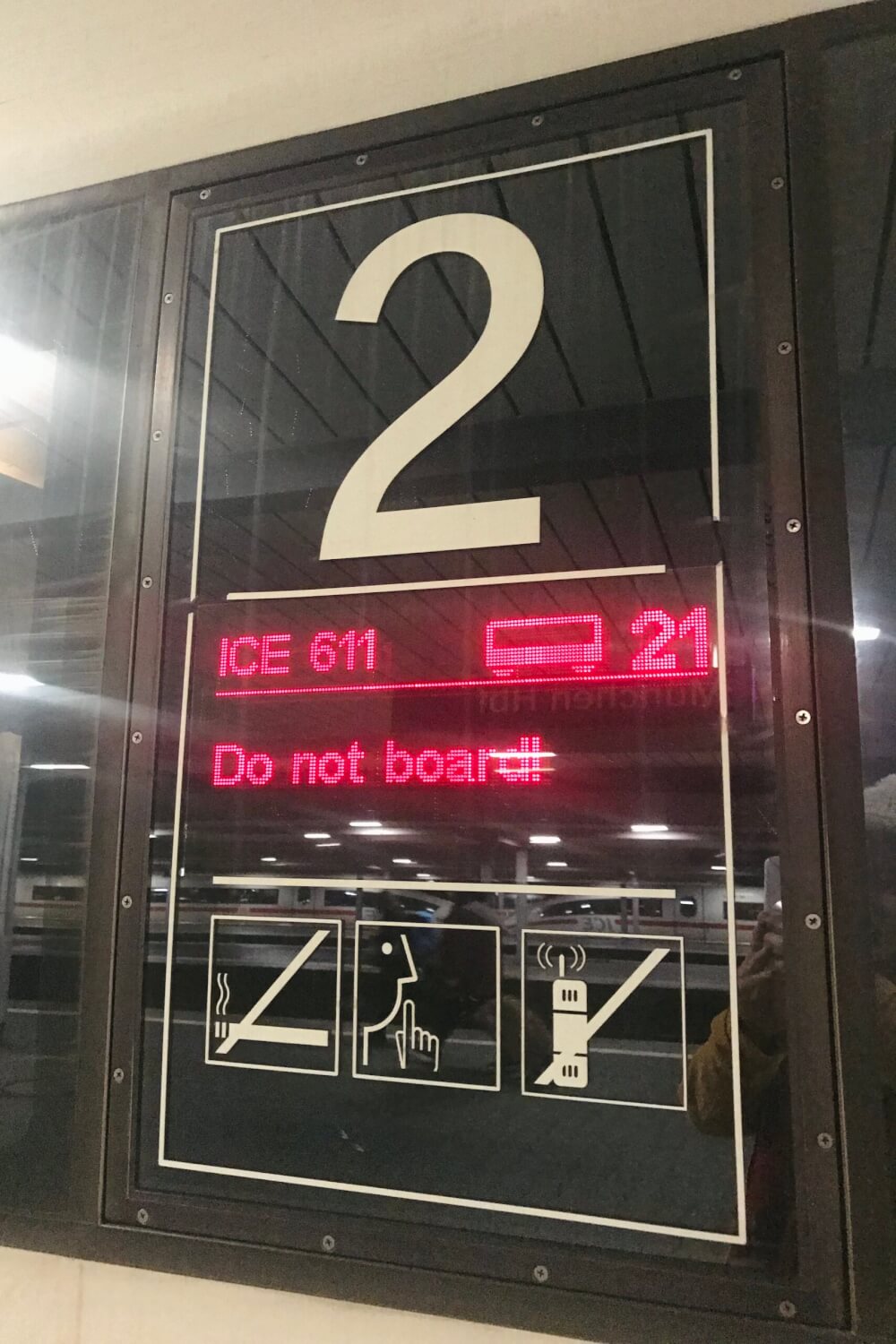
If you don’t have a reserved seat, then usually I find the farther you walk, the emptier the carriages will be.
Once you find or choose your carriage, then it’s time to hop on board.
If the door isn’t opening then look for a button like this <> and press it. This goes for the train doors as well as carriage doors.
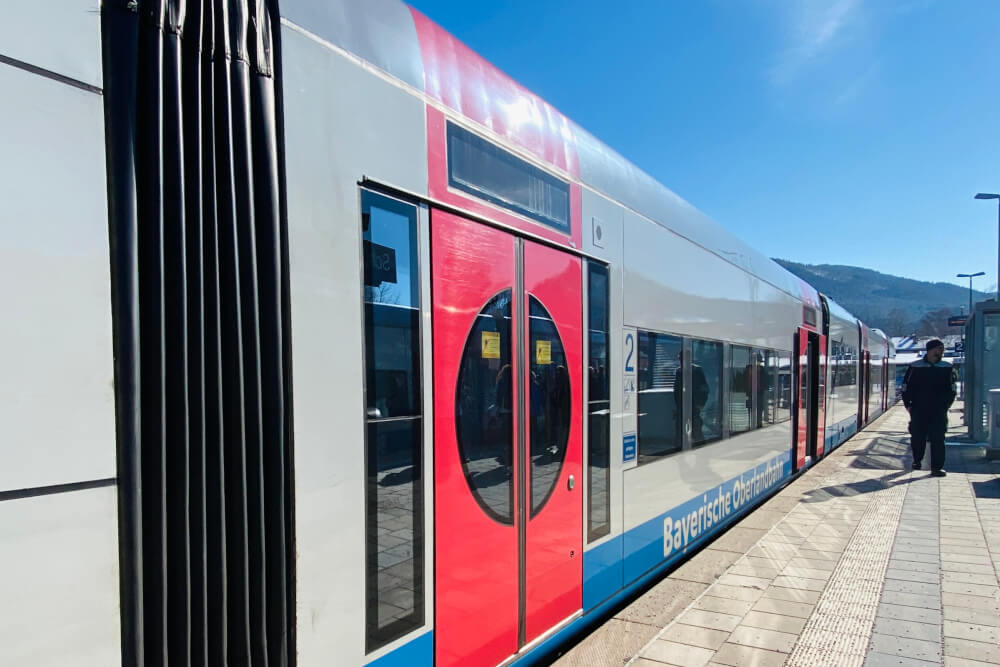
Now it’s time for…
Step Seven: Find Your Seat
First off, if your seat is assigned, try to make sure you go in through the correct door closest to your seat.
Long distance trains will usually write the seat numbers on the corresponding door, like so:
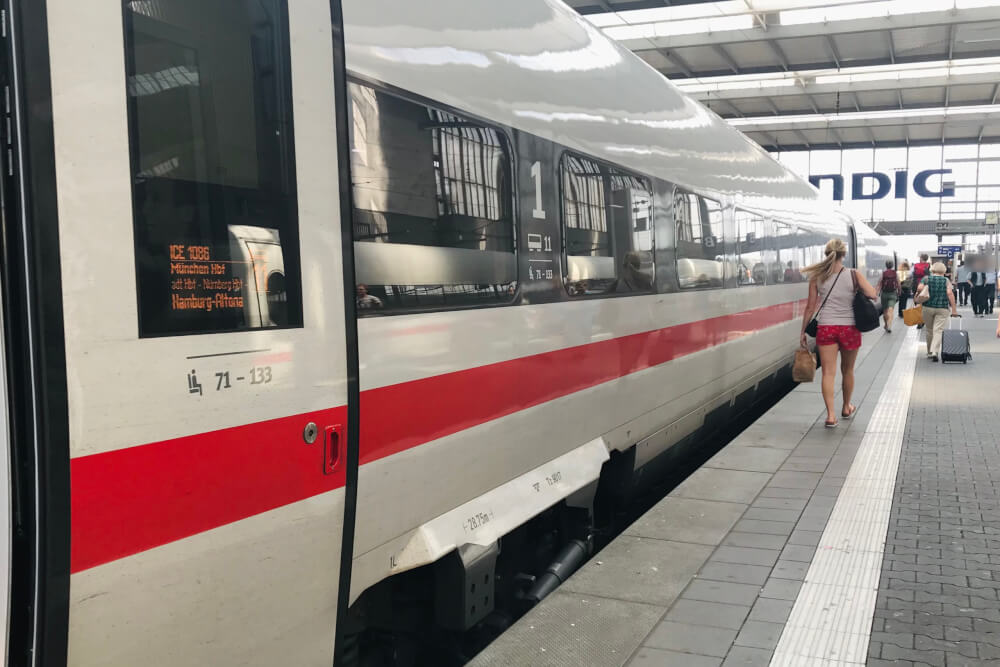
If you have large bags, keep an eye out for large luggage racks when you enter. These will usually be found on the ends of the carriages.
With smaller bags/suitcases, there is usually space above your seat for it, or sometimes under and between seats, as marked.
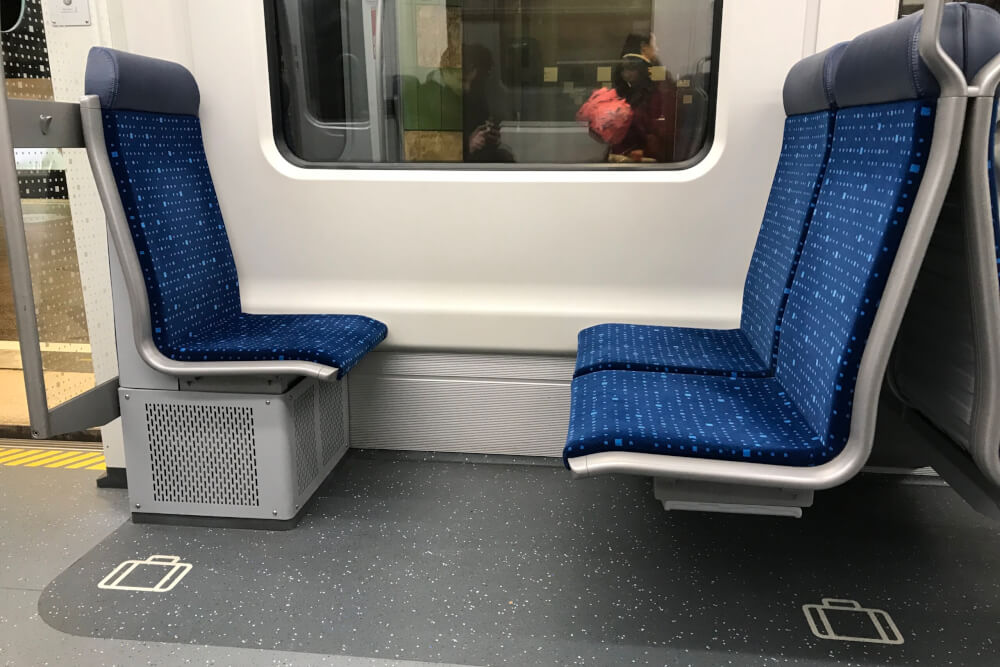
If you don’t have a reservation, before sitting down, make sure your seat isn’t reserved and make sure you’re not taking up a priority space if the train is looking full.
Seats that are reserved on long-distance trains will usually be marked on an electronic screen that shows you which part of the journey the seat is reserved for.
So let’s imagine you’re going from Munich to Berlin. The screen may show the seat is reserved for the whole journey, or for just a portion. If your journey doesn’t overlap with the reservation, then that sat is technically free.
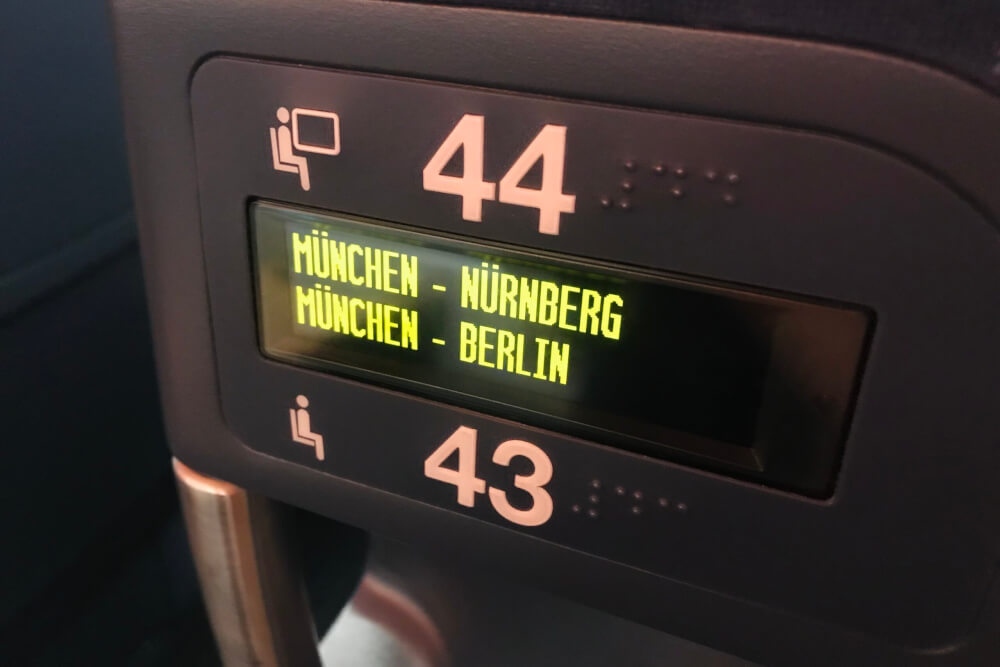
But do note however that the screen may sometimes say something else like..
- ggf. reserviert (possibly reserved)
- ggf. freigeben (possibly to release)
Both of these annoyingly mean that the seat might be reserved, or it might not, but either way you have to vacate it if the person with a reservation comes, so you kind of just have to sit there and hope for the best.
It is honestly the silliest system. To avoid this Russian Roulette of seating charts, be sure to just reserve yourself a seat. It’s worth it.
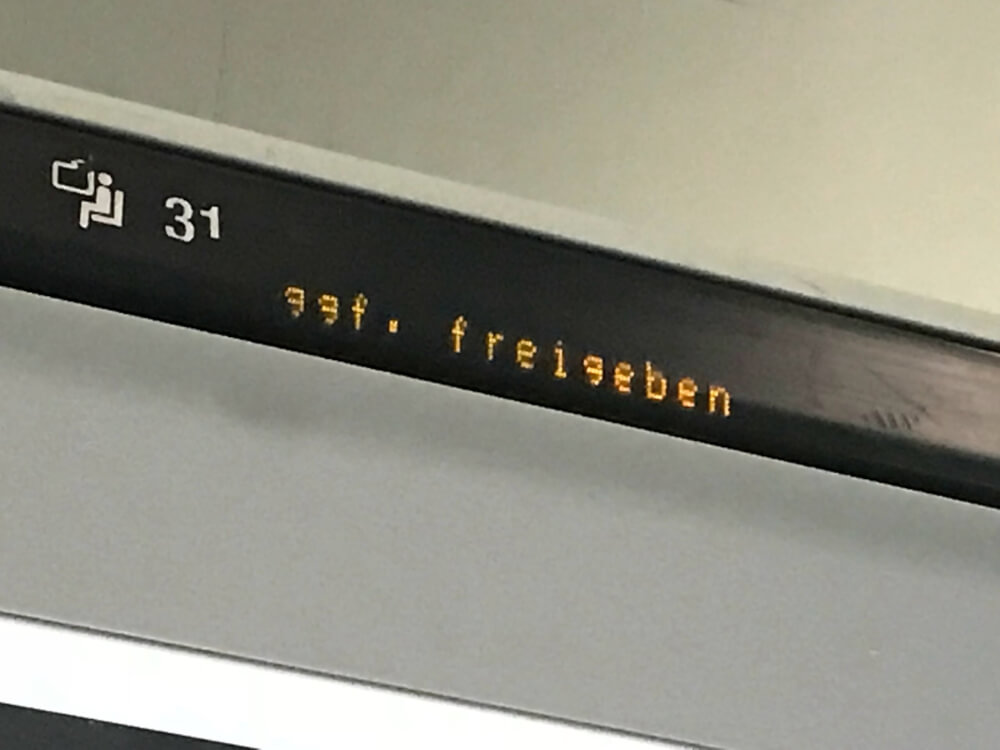
There are also some seats that are reserved for Bahn Comfort customers, i.e. VIP frequent travellers, so avoid those when you see them or an especially fancy-looking person might come kick you out of it.
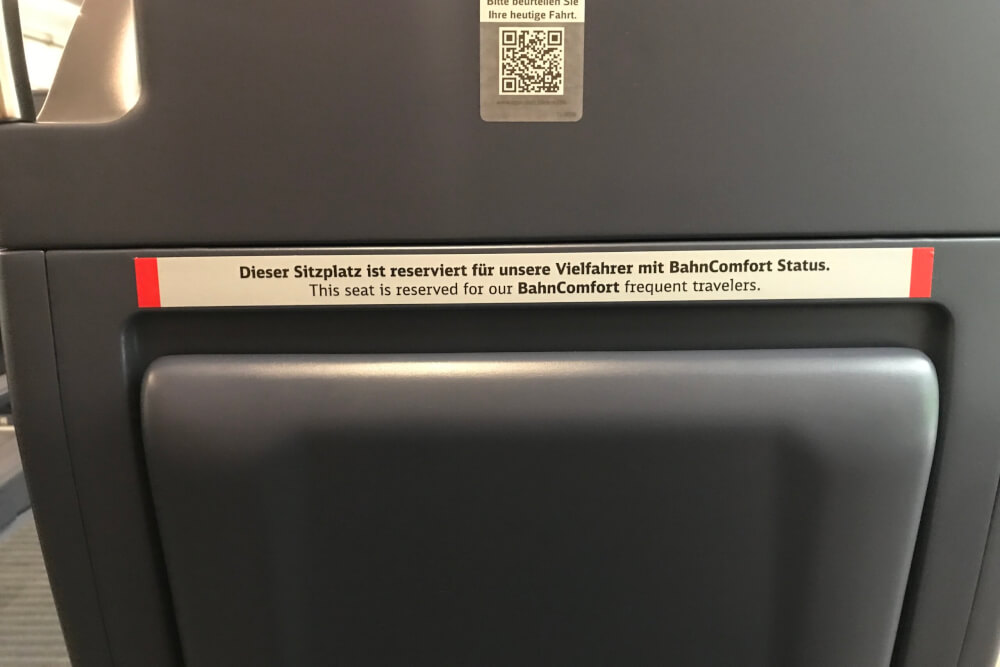
Now finally, onto…
Step Eight: Get Comfortable and Enjoy the Journey!
Once you’re all settled, you’re now in a good place to enjoy some of the hidden features and amenities of your train.
Okay, I say “hidden”, but what I mean is they’re easy to miss, especially if it’s your first time on board a German train.
So, be on the look out for…
Coat hooks: These can be found on the wall next to your seat – sometimes they may need to be pulled out. You can leave coats, scarves, etc. on those
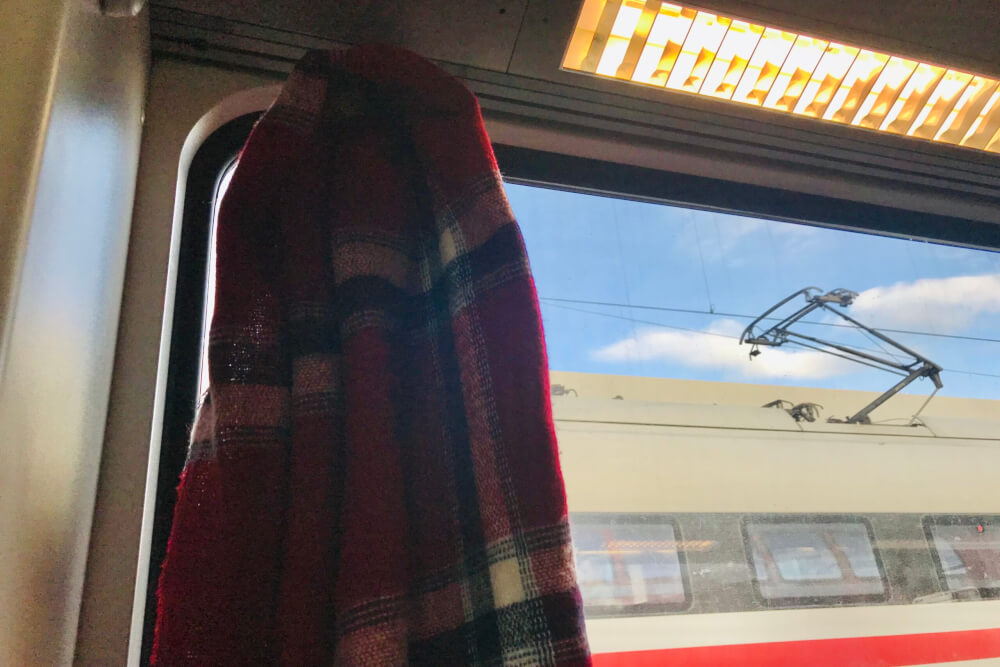
Plugs: Most trains will have an area to charge electronics. On ICE trains, usually the charging ports are in the middle part between two seats. On regional trains, the charging ports can often be found between seats or on the wall.
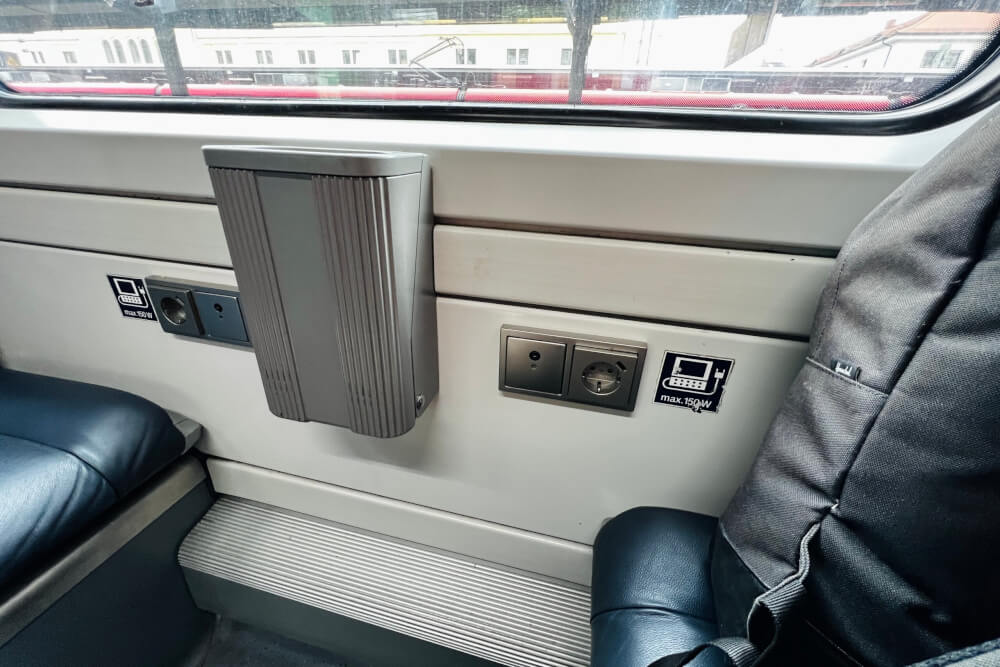
WiFi: Most long distance trains will say they have this but the quality is questionable depending on where you are. Many S-Bahn routes are starting to get WiFi too. Like with modern dating apps, be sure to try connecting, but don’t get your hopes up.

On-board restaurant or bistro: You’ll find these on long distance trains, and if you sit in first class, there’s often even table service straight to your seat.

Bathrooms: And of course, don’t forget to look for the on-board bathrooms (which are free). They’re typically marked by signs saying “WC”.
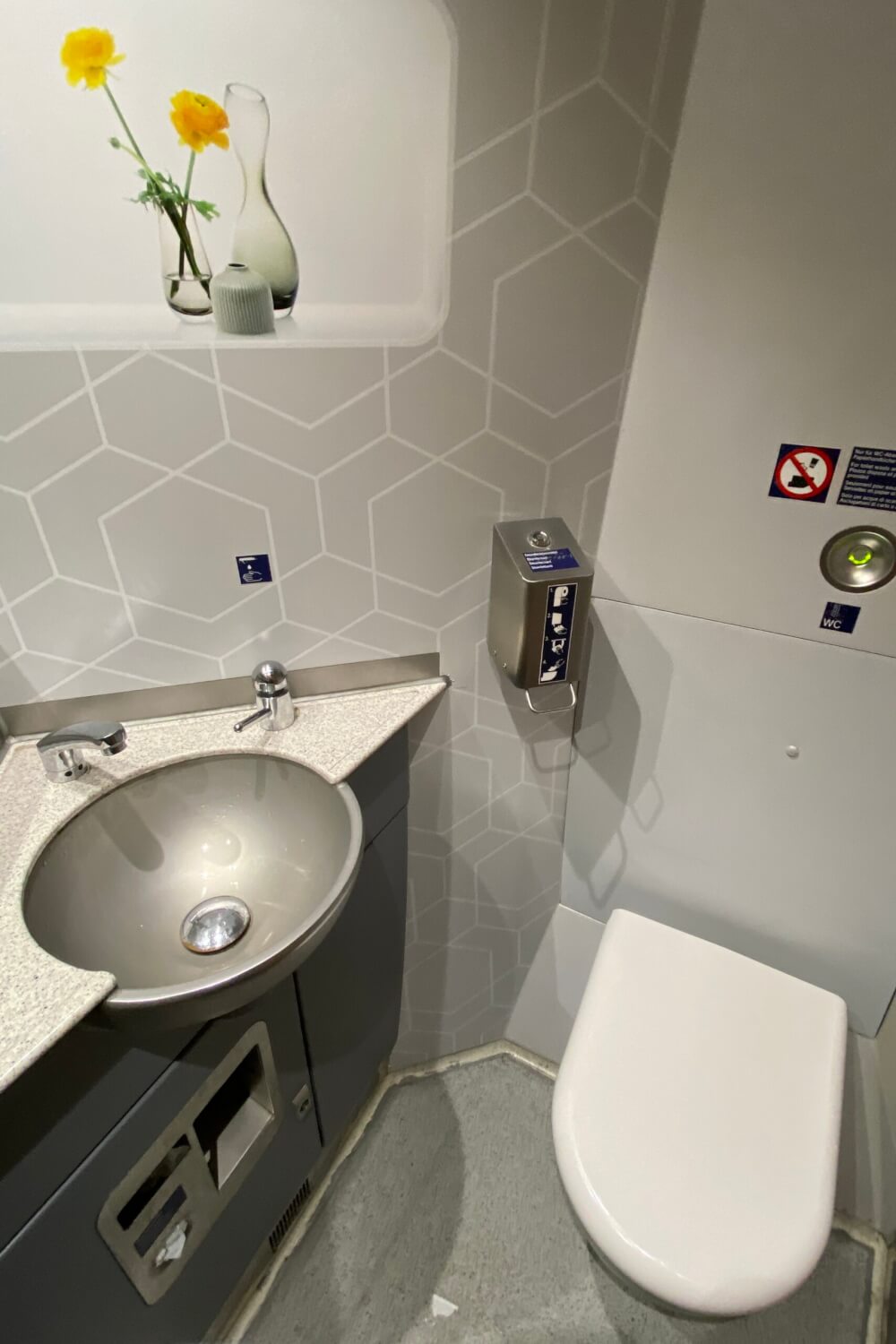
Now, as you get comfy, keep your ticket and ID handy in case controllers come on board. With long distance trains, you’re often able to check yourself in on the app so you don’t have to worry.
Otherwise, you just wait for a controller to come, at which point you show your ticket.
Getting your tickets checked by a controller tends to happen more often in high speed or long distance trains than the regional ones, but regardless just make sure you have your ticket and also some ID (preferably your passport) on you.
Sometimes they will want to verify your name if it’s a reserved ticket, and your age/residency as well depending on whether or not you’ve purchased a discounted fare.
I’ve had it before where they didn’t accept foreign IDs like driver’s licenses – only passports, so that’s why I’d recommend having that.
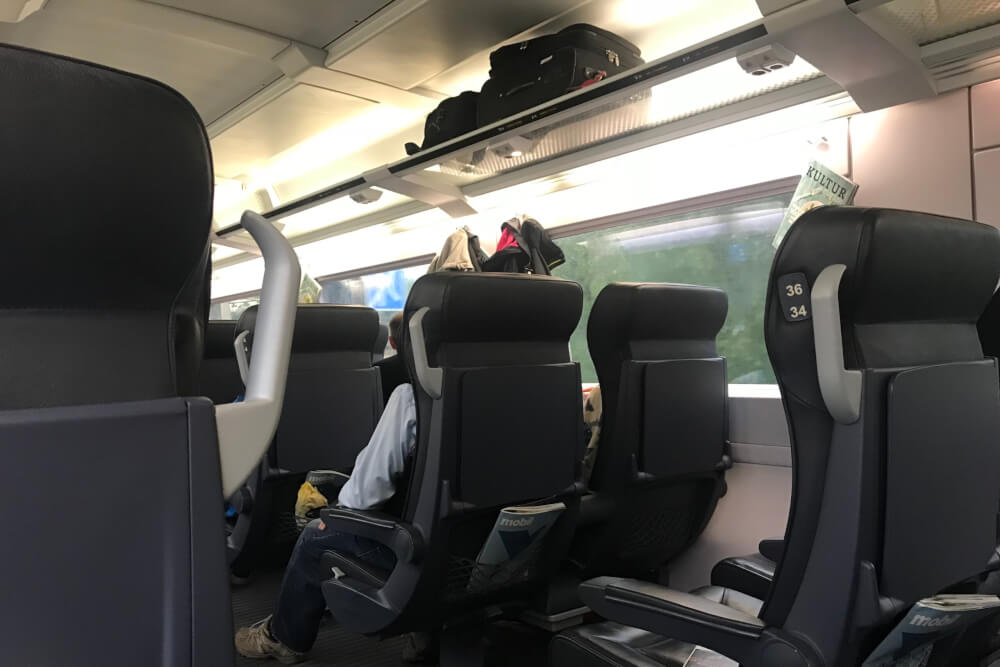
Now after your journey is complete, it’s onto…
Step Nine: Disembark
If you are not getting off at the end destination, then start prepping for disembarkation about 10 min before your arrival time. This gives you plenty of time to gather your belongings and bags in a rational, non-crazed manner.
To keep track of what time you’ll be arriving, keep an eye out for screens that show the scheduled arrival time/estimated arrival time.
Make sure you memorize the name of the stop you’re meant to get off at because most major German cities have multiple train stations and it gets a little confusing once you’re in the city. Like in Munich, you could accidentally get off at the East station instead of the Central Station, just because the names start the same.
And if you’re transferring onto another train, keep an eye out on signs/listen for announcements just before your arrive at your station because they will usually tell you which platforms to transfer on, and if there are any delays/disruptions for transfers.
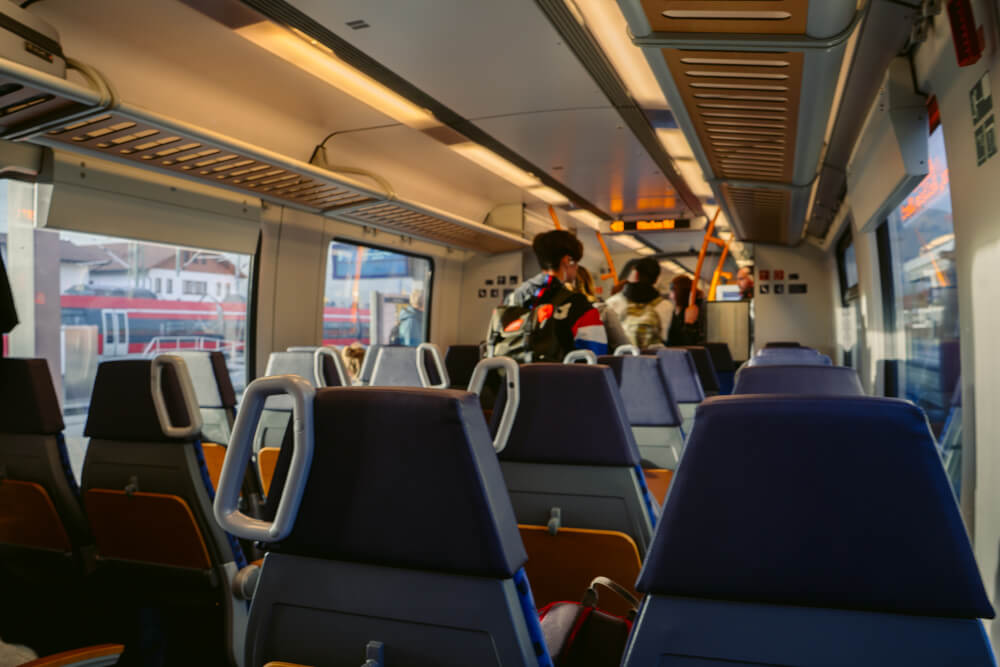
Upon arrival, if the door isn’t opening then again look for a button with the <> open symbol.
Once the doors are open, be careful getting off the train as there’s often a gap/step.
To navigate your way off the platform and onwards to wherever you need to go, keep an eye out for signs that will point you in the right direction.
If you are transferring onto another train, look around for big signs pointing to different platform numbers. If it’s a tight connection (10 min or less) you may want to speed walk or run, depending on how big the station is.
NOTE: Remember, you’re on a train platform, so to reach other platforms you need to either go via a tunnel underground or sometimes a bridge above ground. Keep an eye out for stairs/an elevator so you’re not panicking to find ways to reach your next platform.
If this is your final destination but you need a place to drop off your bags while you explore, most major train stations will have a paid left luggage area with lockers, which is great if you’re too early to check in to your accommodation, or just dropping in for the day.
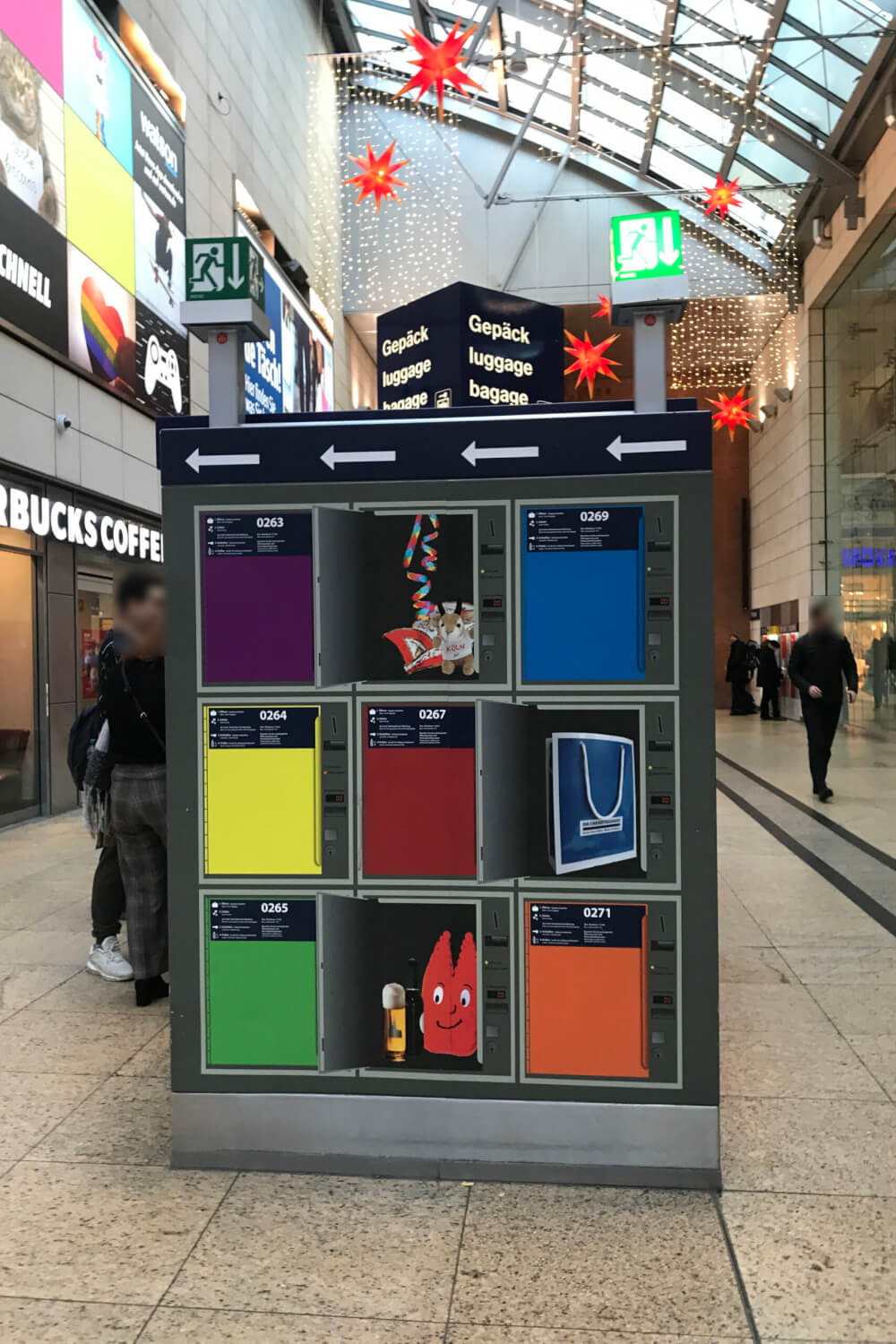
Remember that your train ticket is usually only valid for that specific train you boarded, so you won’t be able to use it for onward travel on the metro or bus unless you bought a special regional ticket or a City Ticket add-on.
Lastly, take note that in Germany, if the train is more than an hour delayed, you are entitled to compensation. Just make sure you get some proof of the delay, whether through an employee or through photos of signs showing the delay. You can then fill out a form or claim compensation through your DB app.

Final Tips for Taking the Train in Germany
Alright, we’ve gone through ALL the basics so now I’m going to simply leave you with some extra bonus tips on how to make the most of the German rail system!
Learn basic train-related vocabulary
The German rail system is very English-friendly for the most part, with many trains making announcements in English and most train attendants speaking at least some English as well.
That said, when you’re in a panicked state dealing with travel stress, sometimes it IS helpful to know some basic words, so here are a few to keep in mind that may be useful:
- Bahnhof: Train Station
- Hauptbahnhof (HBF): Central Train Station
- Gleis: Platform
- Abfaht: Departure
- Ziel: Destination
- Einsteigen : To board
- Aussteigen : To disembark
- Umsteigen : To change/transfer
- Zurückbleiben – To stand/stay back
- Endstation: Final stop
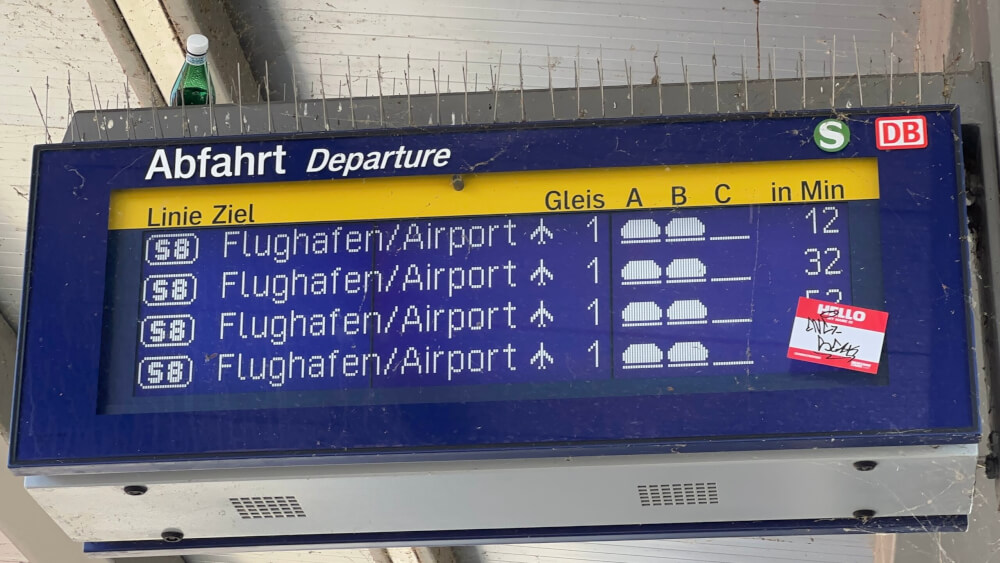
Download the DB Navigator App
I’ve said it so many times already, but the DB Navigator App is an amazing tool, and well worth downloading even if you’re only taking a few trips.
Google Maps does sync train info but it’s sometimes inaccurate or incomplete. The DB Navigator app is free and simple to use, plus it unlocks a bunch of bonus perks like self check-in. Highly recommend!
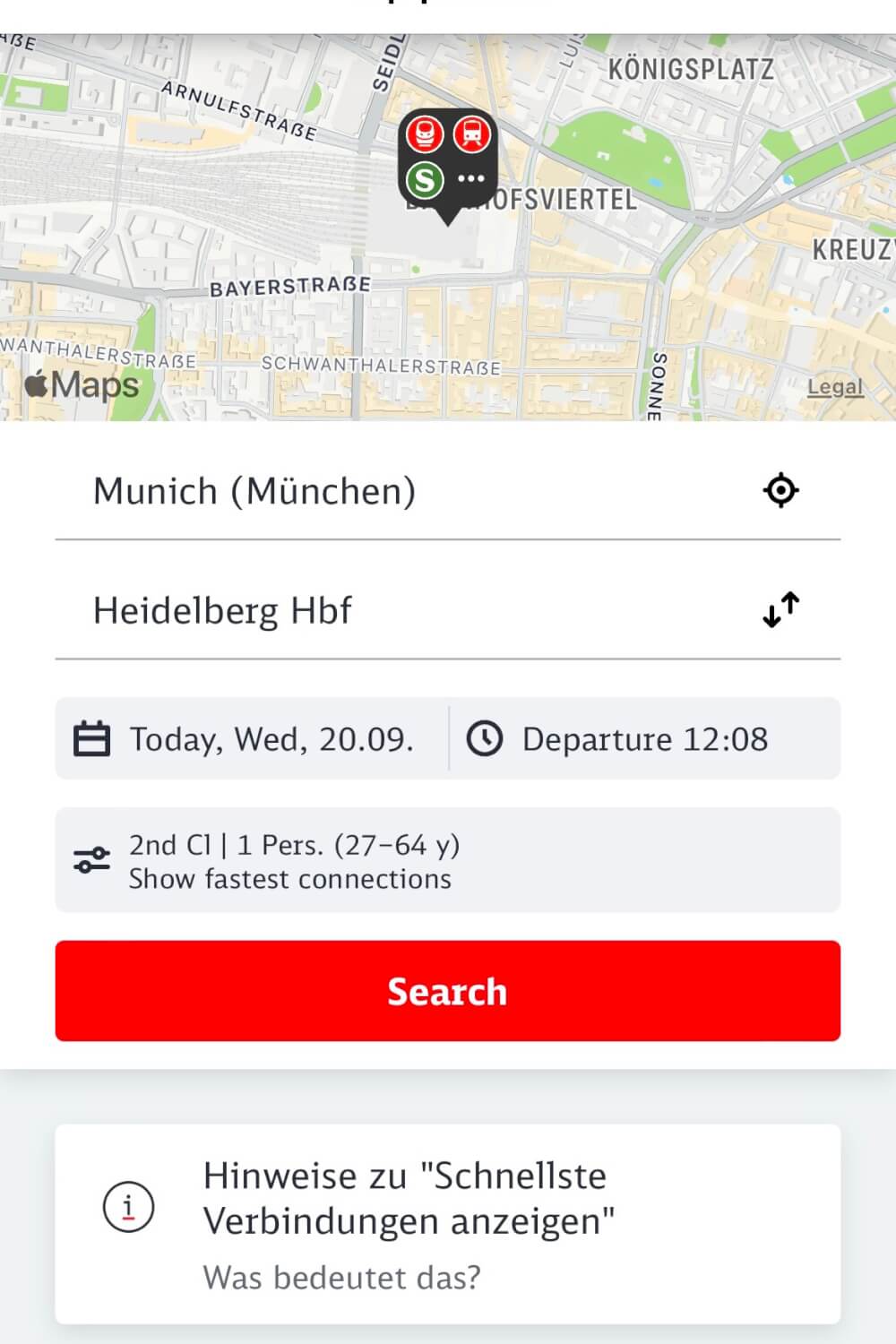
Make use of helpful search filters to find the right train
If you’re struggling to choose which trains to get, then the good news is there are many helpful tools built into the DB website/app.
If you’re travelling exclusively with a Regional Ticket or Deutschland-Ticket for instance, it may be helpful to click on “Mode of Transport” and then set it to “Local Transport Only” which will then filter out high speed trains and show you only the trains you can take with one of those tickets.
You can also ask them to only show the fastest connections, direct services only, trains with a minimum transfer time, or even specify what stopovers you want.
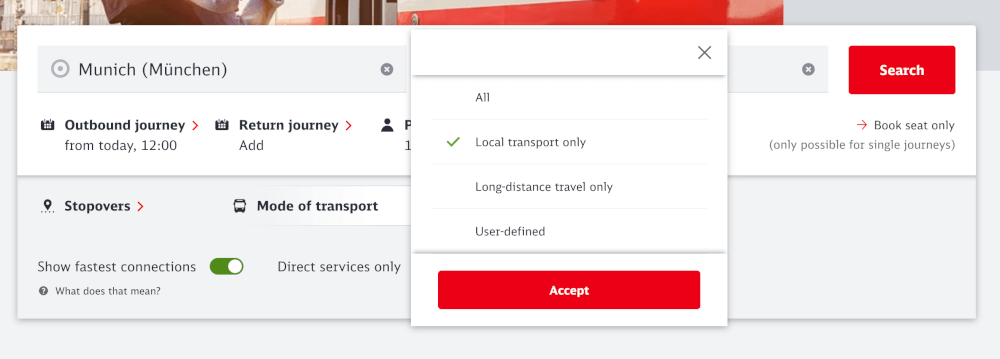
Avoid peak times
As a tourist, you have the luxury of flexibility, so try to plan your train trips around when other people aren’t travelling.
This will ensure the least stressful experience, and make sure you have room for you and your bags.
Some times to avoid include:
- Early morning (to avoid business travellers)
- 3-4pm during school days
- Early evenings just after work (again, to avoid business travellers)
- Weekends (Friday & Sunday evenings, plus Saturday & Sunday mornings especially)
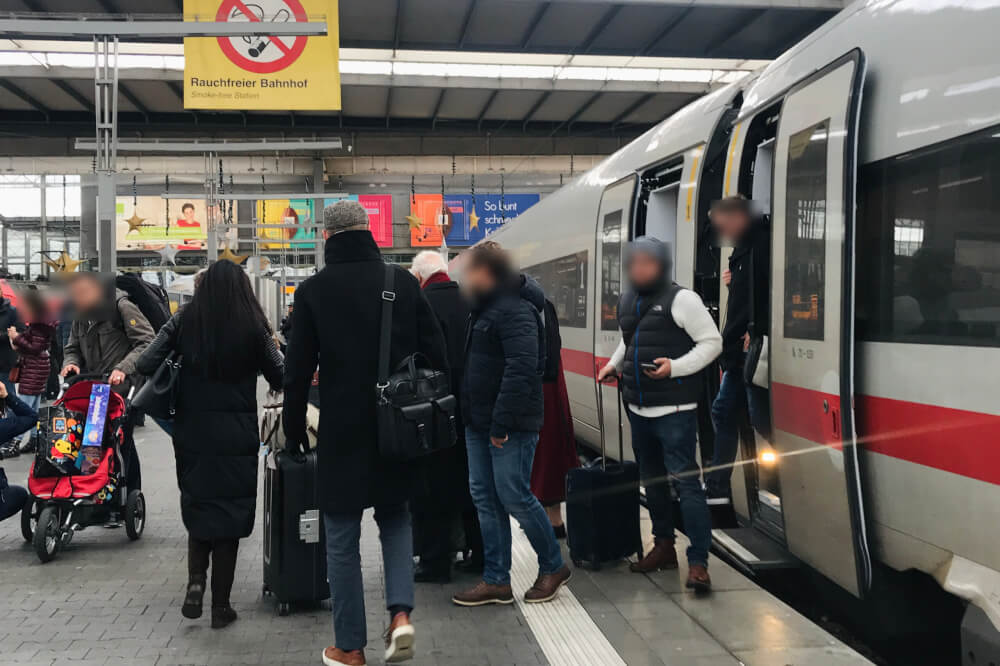
Use the bathroom on the train – bathrooms at the station cost money
As I mentioned in my Germany must-knows post, free public restrooms are quite rare in Germany, which means you’ll usually have to cough up 50 cents or more to pee at train stations.
NOTE: If you do end up using a paid train station toilet, usually the machine will print you a little coupon to use on a future purchase, so if you need to go, head to the toilet first before buying your train station snack.
Luckily, trains on board are free! So take care of business before disembarking.
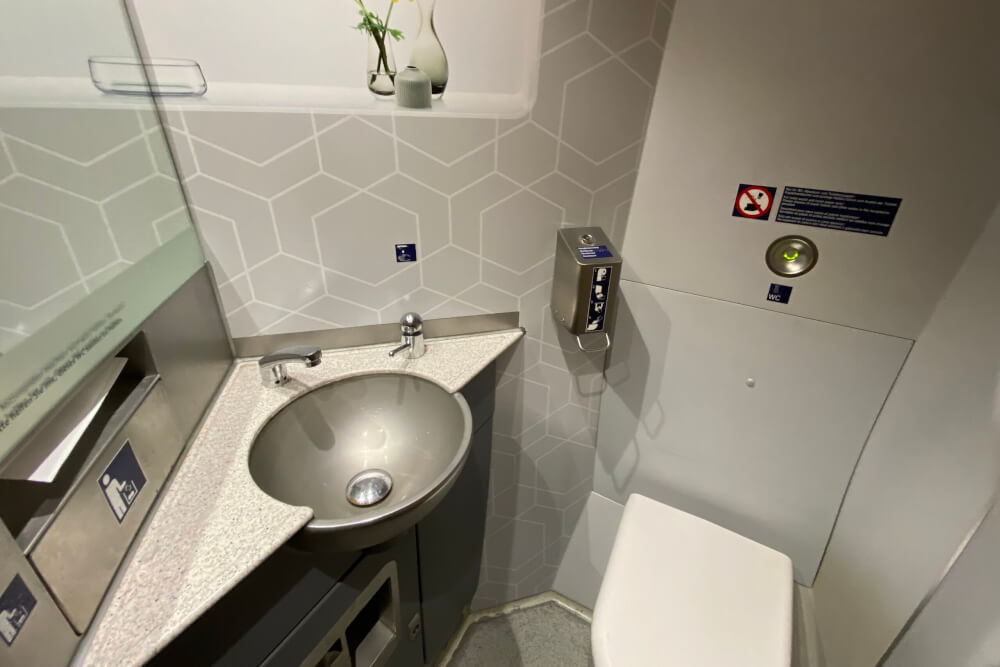
Don’t forget ID
Again, remember to have ID on you, even if it’s just a little day trip. Sometimes they will ask to see it.
NOTE: You might assume a driver’s license is okay, but I’ve had several instances where they’ve insisted on a passport because they don’t recognize foreign IDs.
It kind of depends on who checks you and how cranky they’re feeling that day, but if you’re from outside the EU, it’s a safer bet to just bring your passport… especially because it’s Germany, and your train might accidentally cross into Austria or something without you noticing.
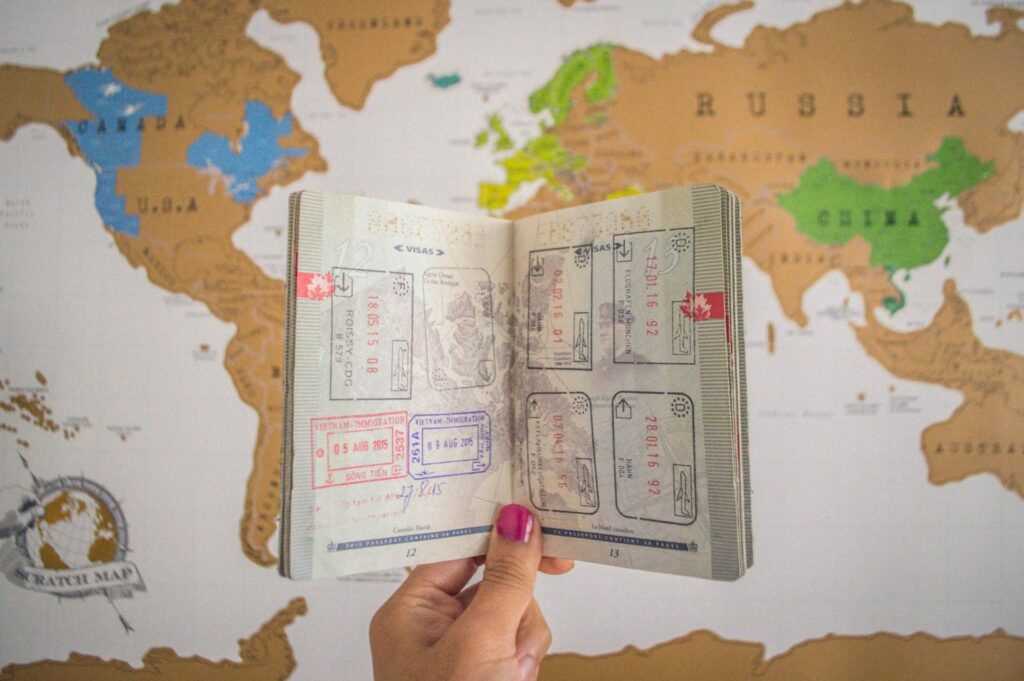
Beware of putting your bag in places you’re not supposed to
One time, I had a suitcase that was too huge and heavy to put in the overhead compartment, so I left it in the bike zone as no one was using it.
About an hour later, a cyclist got on and shouted at the top of his lungs “WHO IS THE HUMAN TRASHBUCKET THAT LEFT THIS SUITCASE HERE?” (Okay, just kidding – my German is bad and he probably didn’t phrase it like that but his tone did).
I was terrified, and was sitting pretty much right next to the suitcase. I had to meekly say it was mine and had the poor dude next to me try to hoist and cram it up in the overhead shelf.
I still have nightmares about it to this day.
So yes, don’t leave your bags where they’re not meant to be.

Learn the names of your destinations in German
Most places like Berlin or Frankfurt have the same name as in English, others like Munich (München) or Cologne (Köln) have a different name in German, so make sure you know the German name of your destination, and how to say it in German in case you need to ask for directions.
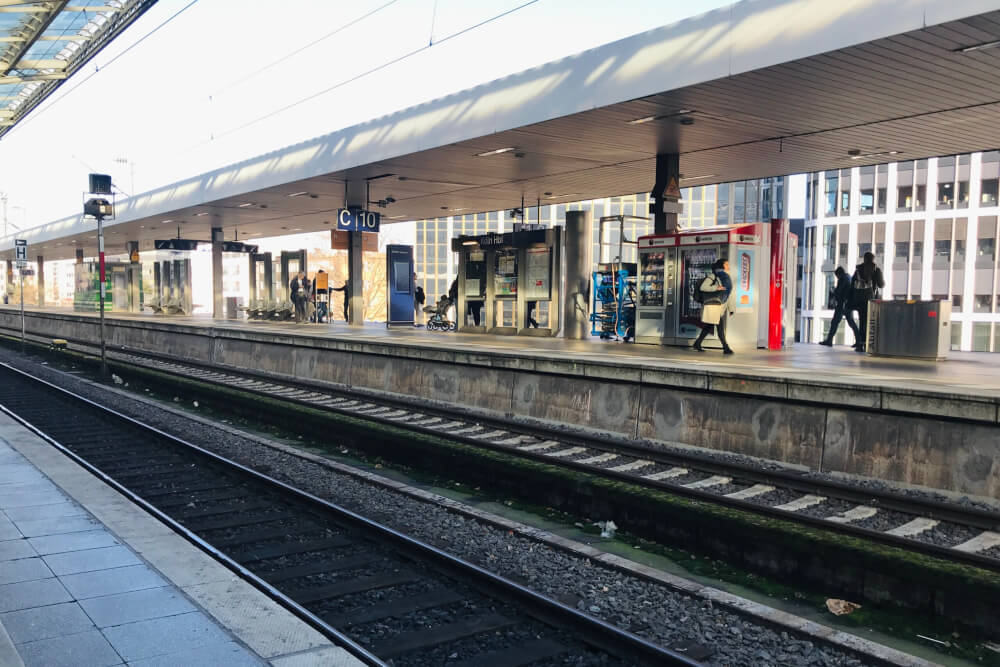
Similarly, learn how to say the names of trains the German way
For instance, ICE trains are not “ice” trains, but rather pronounced Ee Tsay Ay, like the German way of spelling it out.
Be sure to also ask for the U-Bahn, not the subway or Metro.
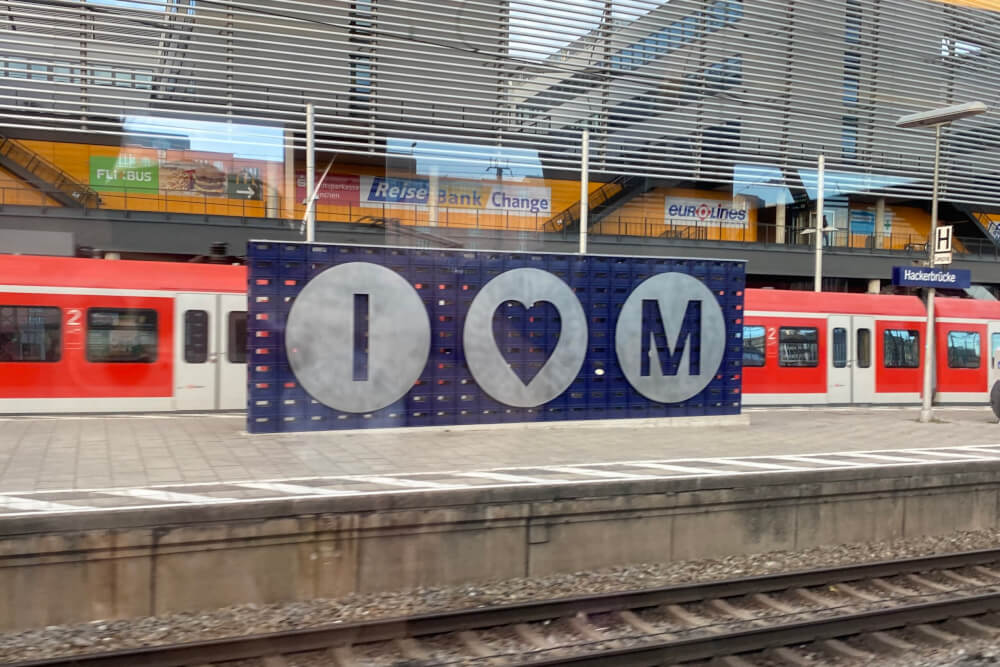
Don’t bank on the WiFi
The WiFi on German trains is hilariously bad considering how much you pay for those tickets… but yes, don’t rely on having WiFi (like setting aside a bunch of work to do on the train that requires it).
Cell service tends to be quite poor as well once you’re away from the big cities.
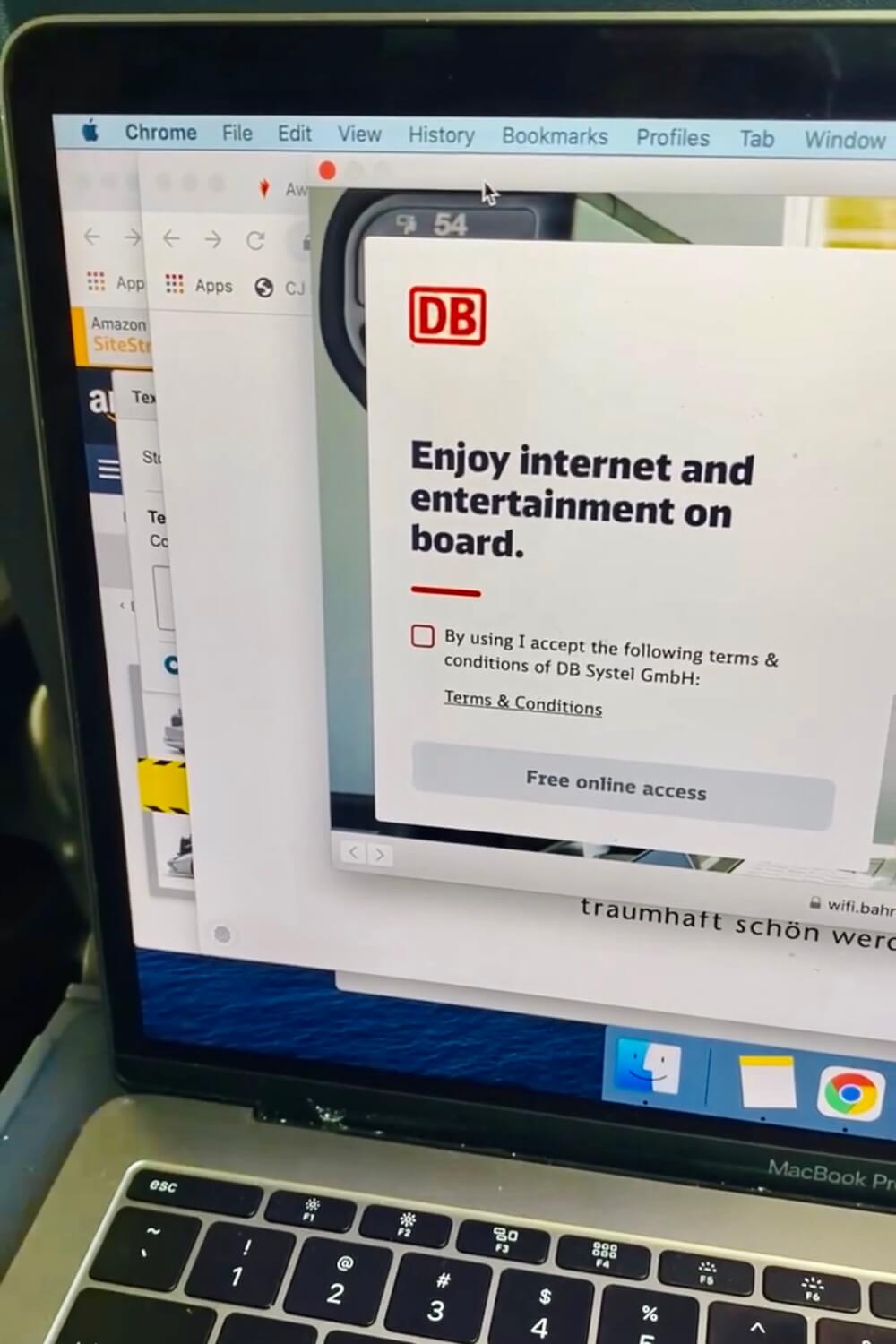
Know your route and stops
The last thing you want to do when travelling by train in Germany is relying solely on the announcements to know when to get off or what to do.
Seriously, mumbling seems to be a skill requirement for workers of DB. Mixed in with ambient train noise and the screeching of rails, I have had it far too many times where I’ve been unable to hear anything the conductor is saying.
They also seem to randomly translate in English when they feel like it, so a translation isn’t guaranteed if you don’t speak German. So, make sure you know your route and approximately when you’ll need to get off, transfer, etc.

Beware of “on demand stops” where you must press a button for the train to make your stop
Very rarely, you may come across stops that only stop when someone requests it. These are known as Bedarfshaltestellen .
This shouldn’t be a concern unless you’re travelling to very small, quiet stations, so I wouldn’t worry too much, but if you notice anything on your ticket that mentions the word “Bedarfshalt” or any signs that say “”Der Zug hält nur bei bedarf” (the train only stops on demand) then be prepared to press a special button before your stop, kind of like on a bus.
If you are boarding at one of these Bedarfshaltestelle , then don’t worry – the train will stop so long as they see you on the platform.
I had this (stressful) experience when I travelled to Untergrainau:
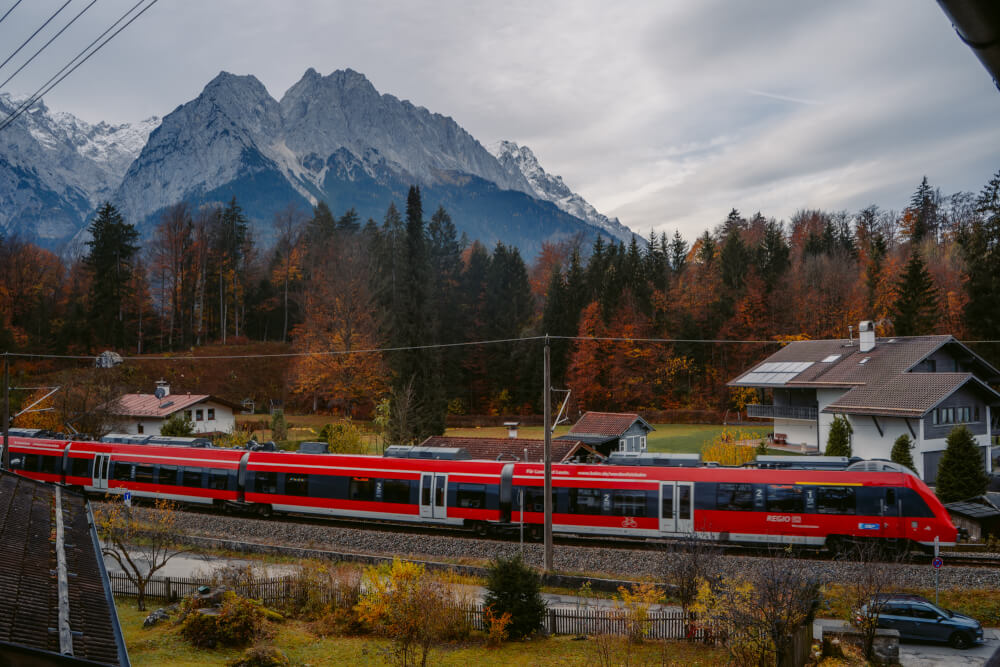
Always read the fine print
Lastly, especially when buying discounted offers for German trains, be sure to read the fine print!
With regional tickets for instance, it’s very common for there to be time restrictions on when the ticket is valid, or when it expires.
Likewise, there’s often restrictions on which types of trains you can take with your ticket, so be sure to read up on these or you may be fined as your ticket will be considered invalid.
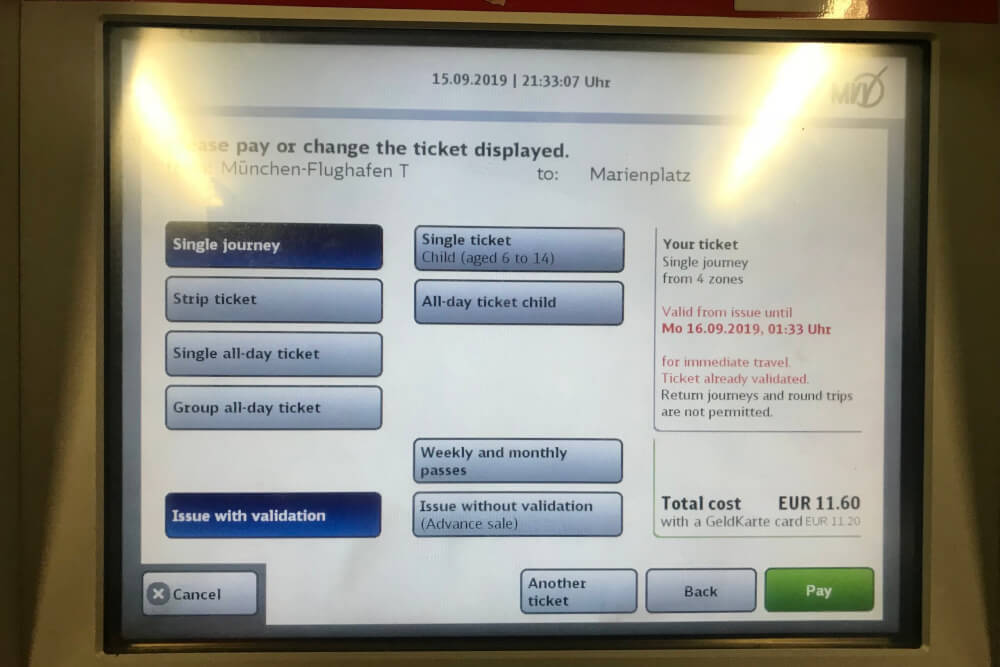
I Hope This Step by Step Guide on Taking Trains in Germany was Helpful!
Let me know in the comments if you have any more questions.
My Go-To Travel Favourites:
🧳 Eagle Creek: My favourite packing cubes
💳 Wise: For FREE travel friendly credit cards
🍯 Airalo: My go-to eSIM
🏨 Booking.com: For searching hotels
📷 Sony A7IV: My (amazing) camera
✈️ Google Flights : For finding flight deals
🌎 WorldNomads: For travel insurance
🎉 GetYourGuide: For booking activities
2 thoughts on “How to Take the Train in Germany: A Step by Step Guide!”
Thank you so much for putting this post together. This was extremely helpful for planning some train travel in Germany. The information is really clear and the pictures are super helpful.
So glad you found it helpful!! Safe travels 🙂
Leave a Comment Cancel reply
By using this form you agree with the storage and handling of your data by this website. *
Privacy settings
Here you will find an overview of the types of cookies used on the website. You can set your consent for each category individually. Further information can be found in the privacy policy .
- Essential Cookies For the use of the website with all functions (e.g. user settings, watch lists, etc.)
- Statistics Statistics Cookies collect information anonymously. This information helps us to understand how our visitors use our website.
- Marketing In order to provide you with the best possible offer in cooperation with our partners, we use marketing tools. For example, in order to use our chatbot, you must activate this setting.
- External contents Required for viewing external media and third-party content. The provider may set cookies for its part. The respective data protection regulations of the provider apply.
Inspiring Germany
- Cities & Culture
- Nature & Outdoor Activities
- Royal Palaces & Castles
- Experience & Enjoy
- Current highlights
- Sustainable travel
- Barrier-free travel
- Easy language
- Federal states
Slow travel by train: 9 gorgeous rail routes
There are many compelling reasons for a holiday by train: travel in climate-friendly and comfortable style, all while enjoying breathtaking landscapes—completely stress-free!
A train journey has many advantages and is more entertaining: you can sit together with family or friends in your compartment and chat, play games, eat and drink. And what's more, you can sit back and savour the moment, as the scenery unfolds outside your window. Also important, travelling by train is a very environmentally-friendly way to discover a country. We have curated some exceptionally beautiful rail routes for you.
Renowned for its beauty: the Moselle route from Koblenz to Trier

You can expect magnificent views of the Rhine's second-longest tributary: as the tracks wind through a beautiful landscape from the Moselle's confluence with the Rhine near Koblenz all the way to Trier , the train tracks curve gracefully through a stunning landscape. The train travels breathtakingly close to the steep mountain slopes right alongside the track. On this journey you can enjoy a spectacular panorama of stunning views and also pass through the Kaiser Wilhelm Tunnel: an impressive structure which, at 4,250 metres, was the longest railway tunnel in Germany before the Landrücken tunnel in Osthessen opened. Another attraction is the double-decker bridge near Bullay before you crossing the Moselle loop, where the river takes a 180-degree turn: a sightseeing tour by train!
Experience one of Germany's UNESCO World Heritage Sites by train

On the journey from Bingen to Koblenz, you won't be able to take your eyes off the view: after all, the journey leads you through the UNESCO World Heritage Site "Upper Middle Rhine Valley" and the landscape through your window is like something out of a fairy tale. Over a distance of 70 kilometres, this railway route winds its way past steep vineyards, impressive rock formations, romantic Old Towns and imposing castles on both sides of the Rhine. You'll also catch sight of the Lorelei, the famous symbol of the Rhine, from the train. Even though this train journey itself is gorgeous, it's also worth disembarking every so often to discover the towns along the way.
A delight for sea lovers and water enthusiasts: from Hamburg to Sylt by train

From the bright lights of the city directly to the sea: it takes less than two hours to get from Hamburg to the coastal town of Husum, and from there on to Sylt . This unique train journey never ceases to amaze: soon after leaving the station in Hamburg, the route leads through the quintessential North German marshland landscapes and, shortly after, crosses the North-Ostsee Canal on the Hochdonn High Bridge, at a height of 42 metres! On a clear day, you can gaze all the way to the port facilities of Brunsbüttel on the North Sea. After the stop in Husum, we headed towards the island: the highlight of this leg of the journey is definitely the eleven-kilometre long Hindenburg Dam, which runs through the Wadden Sea National Park and connects the North Frisian mainland with Sylt.
From Offenburg to Singen on Lake Constance with the Black Forest Railway

Sit back and marvel: on this route from Offenburg in Baden to the Swabian Sea – as Lake Constance is also known – you travel 150 kilometres through the dense pine forests, deep valleys and impressive mountain scenery of the Black Forest. During this journey, the train glides over the Hornberg Viaduct and travels through two exciting double loops that span several kilometres near Triberg. The train constantly changes direction, making little forward progress but rapidly gaining altitude. Take the opportunity to visit the impressive waterfalls in Triberg or the source of the Danube in Donaueschingen, the source and starting point of this unique river. If you choose not to make any of these stops, you can also take the Black Forest Railway to the town of Singen near Lake Constance in just under two hours.
Lake Constance Belt: from Radolfzell to Lindau
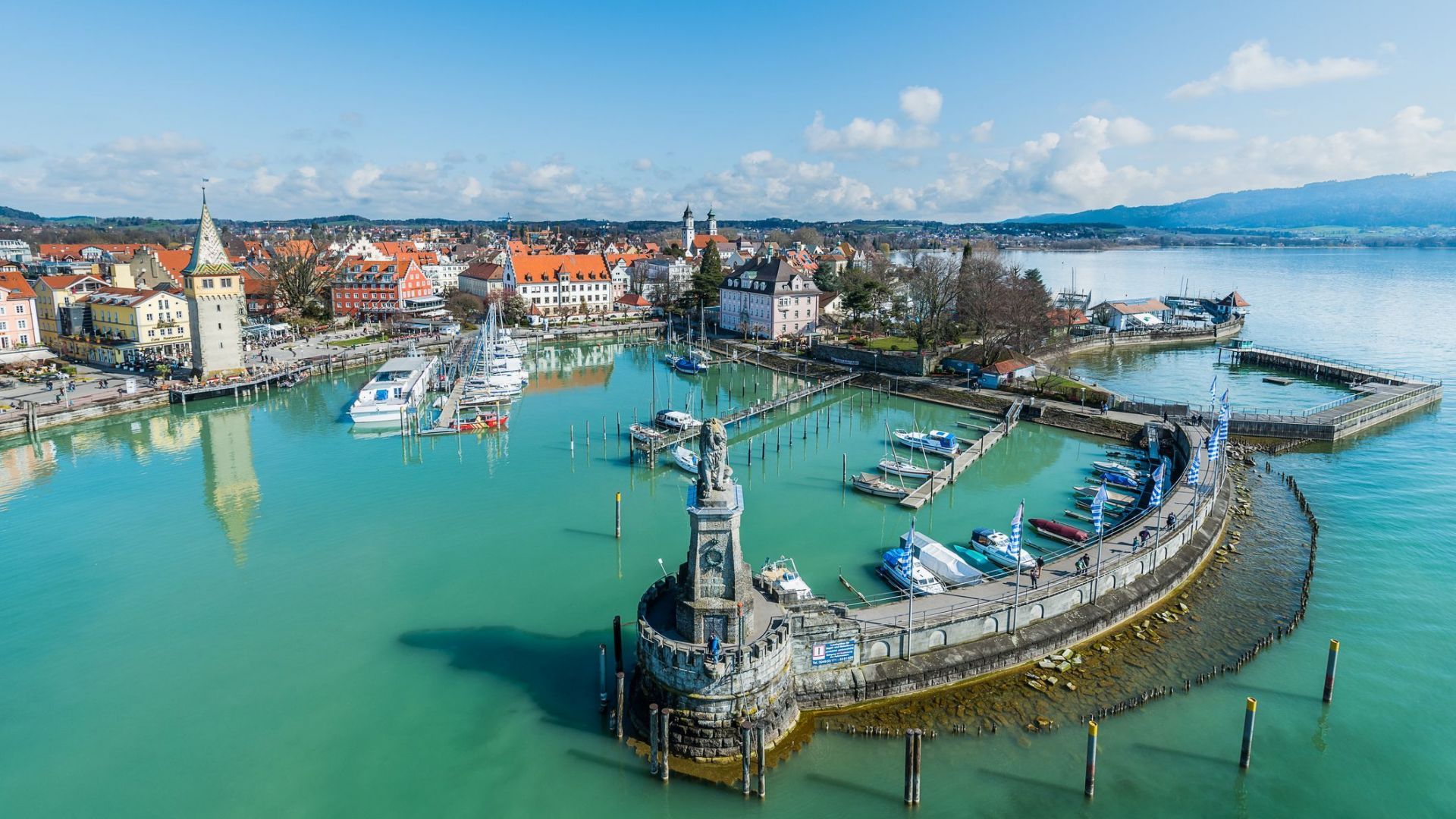
The route covers 74 kilometres and leads from Radolfzell via Friedrichshafen to Lindau along the northern shore of Lake Constance. If you manage to tear your gaze away from the water to watch the countryside go by, you will discover vineyards, meadows filled with flowers, apple orchards, the baroque pilgrimage church of Birnau or Salem Castle. Further in the distance, on a clear day you can even see the snow-covered peaks of the Alps: a truly outstanding backdrop! And when the white sails of the boats on the blue lake glow in the sun, or a Zeppelin glides through the sky, you'd want to travel this route all over again!
Do you dare to take a ride on the Höllentalbahn?
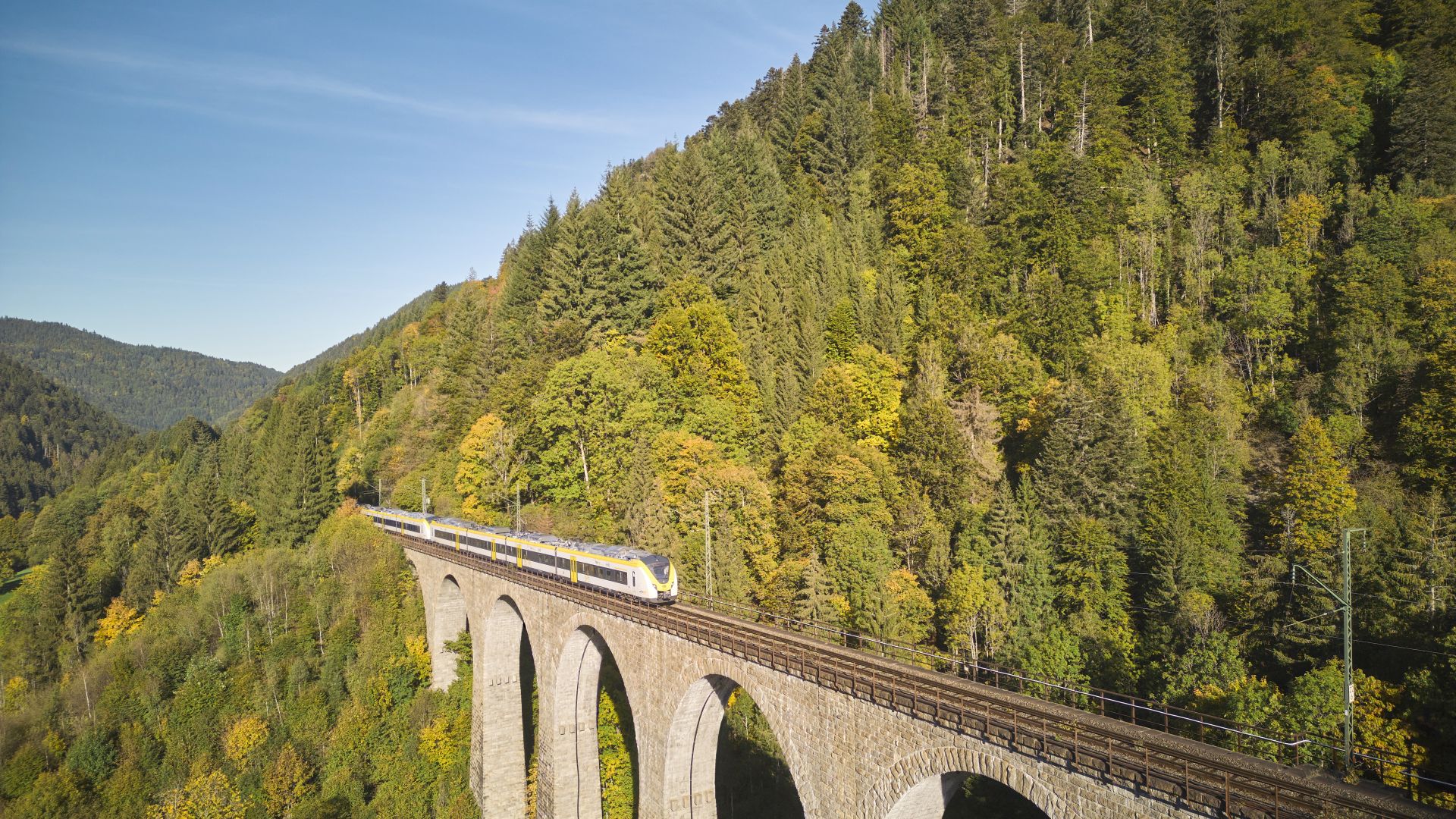
This route is definitely a special experience for the whole family: the Höllentalbahn runs between Freiburg im Breisgau and Donaueschingen , and is considered the steepest railway in Germany. On the section between Himmelreich and Hinterzarten, it climbs a total of 400 metres covering twelve kilometres. The remainder of the 76-kilometre journey is equally spectacular. It passes through nine tunnels and over numerous bridges, including the 224-metre-long Ravenna Viaduct, which spans the gorge of the same name. Along the way, you can gaze out at particularly beautiful views of the Black Forest, expansive valleys and Lake Titisee. This route can be a doubly gorgeous experience in the wintertime, when the forests are covered in snow.
Through two national park regions with the Fichtelbergbahn

The "official" start of this journey is in Bad Schandau – a state-recognised Kneipp spa and health resort in the Eastern Ore Mountains. If you would like to extend your journey along this panoramic route on the German side, hop on the National Park Railway U28 in Schöna in the Elbe Valley, which connects Saxony and Bohemian Switzerland in the neighbouring Czech Republic. Gazing out of the window constantly rewards the eye, as unique rock formations, dense forests and spectacular valleys rush by. On the German section alone, the railway gains around 200 metres in altitude over a distance of 15.5 kilometres. The route climbs steeply, and the view is famously beautiful! The National Park Railway runs nine times a day in the Saxon Switzerland region, with many stops from which you can start your hikes.
From Stralsund to the "Rasender Roland" Rügen narrow-gauge railway

Is it possible to travel to Germany's largest island by train? Yes, it absolutely is. Your journey to the sea begins in the Hanseatic city of Stralsund , where you cross the "Strelasund" estuary via the Rügen Causeway: a scenic journey with a clear view of the boats coming and going, and a panorama of Straslund with its large shipyard. If you stay on the train as far as Sassnitz, you will pass the edge of the Jasmund National Park and see the famous chalk cliffs on Rügen : a highlight not only for nature lovers. To further explore the beautiful island in the Baltic Sea, consider taking a trip on the "Rasender Roland", the narrow-gauge railway with a nostalgic flair that travels along a 24-kilometre route to the island's famous seaside resorts at a steady 30 kilometres per hour. Starting from Putbus, it rattles and steams through gentle hilly landscapes, deciduous forests, and uphill to Jagdschloss Granitz, a popular excursion destination in Mecklenburg-Vorpommern. The Rügensche BäderBahn , as the "Rasende Roland" is officially known, ends in Göhren.
A nostalgic trip through the snowy landscape of the Harz Mountains: the Brocken Railway

Ideally, you can plan to enjoy this train ride through the Upper Harz Mountains in the wintertime, when thick snow covers the fir trees, the landscape sleeps under a white blanket, and the crisp, clear mountain air on the Brocken fills your lungs. With the Brocken Railway , you ascend to the highest peak of the Harz National Park all the while enjoying the impressive panoramic views reaching far into the foothills. The Brocken Railway is a so-called "adhesion railway": this means that it travels to a height of 1,125 metres with around 700 horsepower without gears or similar aids. This makes the Brocken station the highest station of all German narrow-gauge adhesion railways. The starting point of this tour is the station in the village of Drei Annen Hohne, which belongs to Wernigerode in the Saxony-Anhalt district of Harz. From there, you can reach the summit in around 50 minutes on the Brocken Railway.
Discover more
History museums: looking back, looking forward, top spots for astronomy fans: starry skies, summer of football: germany 2024, geological time travel: land of volcanoes, exceptionally green cities: so many parks, such beautiful gardens, must-see museums.

Get our Rail Planner app
Plan your trip, get extra discounts, and show your Pass as you go.

Our favorite spring routes
Celebrate spring with these 7 off-the-beaten-path train routes

All about seat reservations
Everything you need to know about booking your seats

Alternatives to Busy Routes
Travel between popular European cities without seat reservations

Through our Chatbot in the bottom right corner.

Ask the Community
Browse questions from fellow Eurail travellers, or ask your own!
- Plan your trip
- Suggested Itineraries
1 week in Germany
- Order overview
- Reservations overview
- My Trips & Travelers
- {{translatedTraveler}} {{#promotional}} {{currencySign}} {{standardPrice}} {{/promotional}} {{quantity}}x {{currencySign}} {{finalPrice}}
- Child {{childPasses}}x FREE
- {{translatedPassType}}
- {{translatedValidityPeriodDescription}}
- {{translatedClass}}
- Remove Pass(es)
- {{variant.localizedTravelPackDescription}} {{quantity}}x Free
- {{variant.localizedPassUpgradeDescription}} {{quantity}}x {{currency}} {{price}}
- Your order will arrive by {{expectedDeliveryDate}} 1 x {{currency}} {{price}}
Your cart is empty
Thanks to a stellar rail network, 1 week in Germany will give you enough time to explore some beautiful regions and fascinating cities throughout the country. Here’s one way to spend your time if you only have 7 days in Germany.
Itinerary highlights
Beer, castles, and Bavarian culture in Munich; castles and the Rhine Valley Scenic Line; the famous Cologne cathedral; fascinating culture and maritime history in Hamburg; somber history, trendy food, and vibrant nightlife in Berlin.
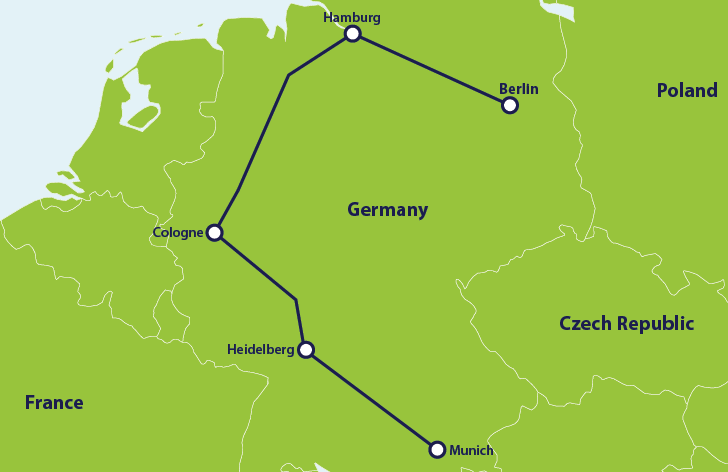
Day 1: Munich

Take a walking tour of Munich Old Town , then drink beer and eat eisbein (pork knuckle) in a traditional beer garden.
Track down the still surfing wave and relax in the Englischer Garten . The park is even bigger than Central Park in NYC!
Got more time? Take a day trip to Füssen to see the famous Neuschwanstein castle , which inspired Disney's Sleeping Beauty castle.
Day 2: Heidelberg

Walk and window shop the vibrant old town . The main street, Hauptstrasse, will take you past many interesting places.
Explore the ruins of the Heidelberg Castle on the hill, one of the most important Renaissance structures in the area.
Relax with the swans on the riverfront, or take a boat cruise along the Neckar River .
Day 3: Cologne
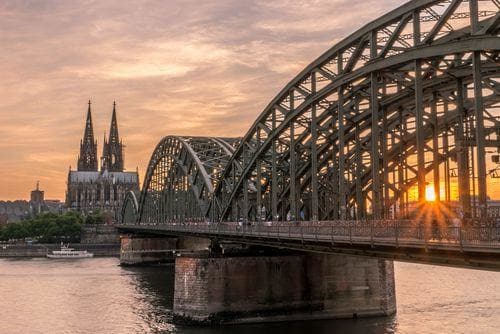
Take in the sight of the Cologne Cathedral . At 157.25 meters high, it’s the second largest in Germany.
Satisfy your sweet tooth at the Imhoff-Schokoladenmuseum - a massive chocolate museum in the heart of Cologne.
Relax in nature at the Cologne Zoological Garden . The zoo has over 7000 animals, as well as an aquarium.
Days 4 - 5: Hamburg
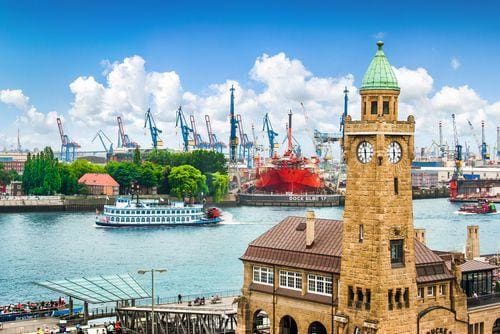
Walk the Port of Hamburg and Warehouse district to experience the city’s maritime history.
Check out Miniatur Wunderland , an entire museum dedicated to a phenomenal model railway.
Discover Hamburg’s entertainment district, the Reeperbahn . It's where the Beatles cut their teeth.
Days 6 - 7: Berlin
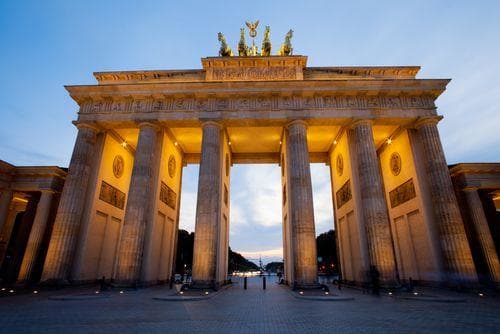
Visit the East Side Gallery , an open-air gallery on the largest remaining stretch of the Berlin Wall.
Take a walking tour from Brandenburg Gate to historically significant sights, then venture to the top of the Reichstag for views over Berlin.
Drink a coffee in a third wave café, have a burger and a craft beer in Kreuzberg , and party till dawn at one of Berlin’s famous nightclubs.
Is 1 week in Germany enough for me?
If you’re looking to get a broad overview of some of Germany’s famous cities, then 1 week in Germany by rail should have you covered. The dense railway network and rapid trains that often don’t require reservations mean you’ll still get amazing value if you only have seven days to spare.
Our German Rail Pass offers you full access to the rail network in Germany. Of course you can also travel the whole of Europe, including Germany, with a Eurail Global Pass (up to 33 European countries).
Change of currency
You cannot change the currency once you have a Pass in your cart. Remove the Pass, and then change the currency on the website header.
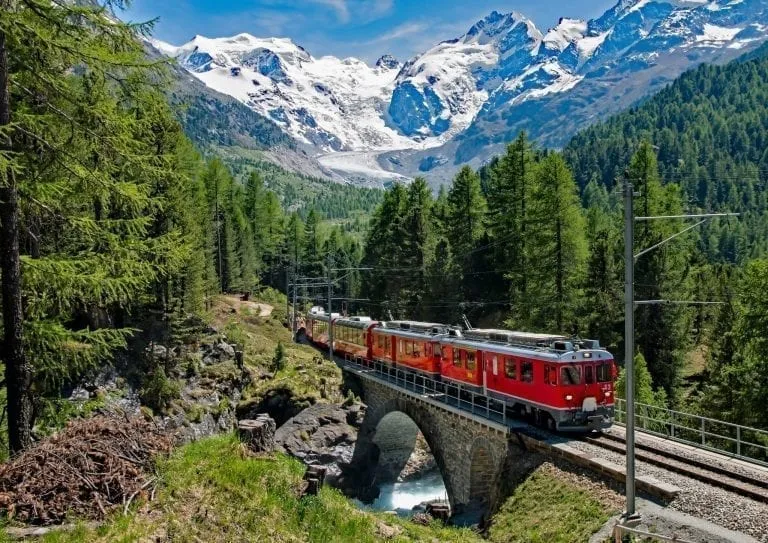
How to Travel Europe By Train: The Ultimate Guide (+ Tips!)
Beautiful views, comfortable train cars, the bustle of busy platforms, and the thrill of a new adventure: there are a lot of good reasons to travel Europe by train!
But, for those of us who grew up in a place where traveling by train isn’t common, the prospect of train travel in Europe can be as intimidating as it is exciting.
Thanks to traveling Europe extensively for years (including with our dog!) and spending more than a year living in Portugal, we’ve had a chance to appreciate countless train rides through and across Europe.
From the mind-boggling efficiency of Swiss trains to overnight train rides through Eastern Europe (Sofia to Istanbul was a particularly memorable ride) to simple jaunts across Italy, we’ve experienced just about every form of train travel in Europe.
And along the way, we amassed a huge number of European train travel tips !
This train travel guide is a culmination of everything we wish we would have known before we started traveling Europe by train , plus why we think it’s worth a try.
Table of Contents
Who is This Guide to Train Travel in Europe For?
Is train travel in europe right for you, different kinds of train travel in europe, different kinds of european train tickets, how to buy train tickets in europe, how to receive your tickets to travel europe by train, how to travel europe by train: step-by-step trip guide, useful tips for train travel in europe.

Some links in this post may be affiliate links. If you make a purchase through one of these links, we may earn a small commission at no extra cost to you. Please see our disclosure policy for more detail.
If you’re planning an epic, multi-destination trip and are hoping to travel by train through Europe but aren’t already comfortable with train travel on the continent, then this guide to traveling by train across Europe is for you!
We grew up in suburbs in the USA, and until we started traveling internationally in adulthood (4+ years of full-time travel , more than a year living in Lisbon, many trips across Europe, and counting!), we had virtually never taken a train.
W hile that’s certainly not the case for many people around the world, it is for thousands of our readers who grew up in similar environments to us!
If you’re excited to travel Europe by train but are learning the whole process from scratch like we once did, you’re exactly who we wrote this guide for.
While train travel in Europe isn’t exactly the same everywhere–with over 50 countries and therefore over 50 train systems, there are plenty of quirks based on location–this guide to train travel in Europe will give a solid overview that will help you start your travels with confidence.

Planes, trains, buses, rental cars, river cruises–with plenty of transportation options for getting around Europe, how do you know if train travel is for you?
In this section, we’ll break down the pros and cons of traveling Europe by train to help you decide if it’s the right transportation option for you.
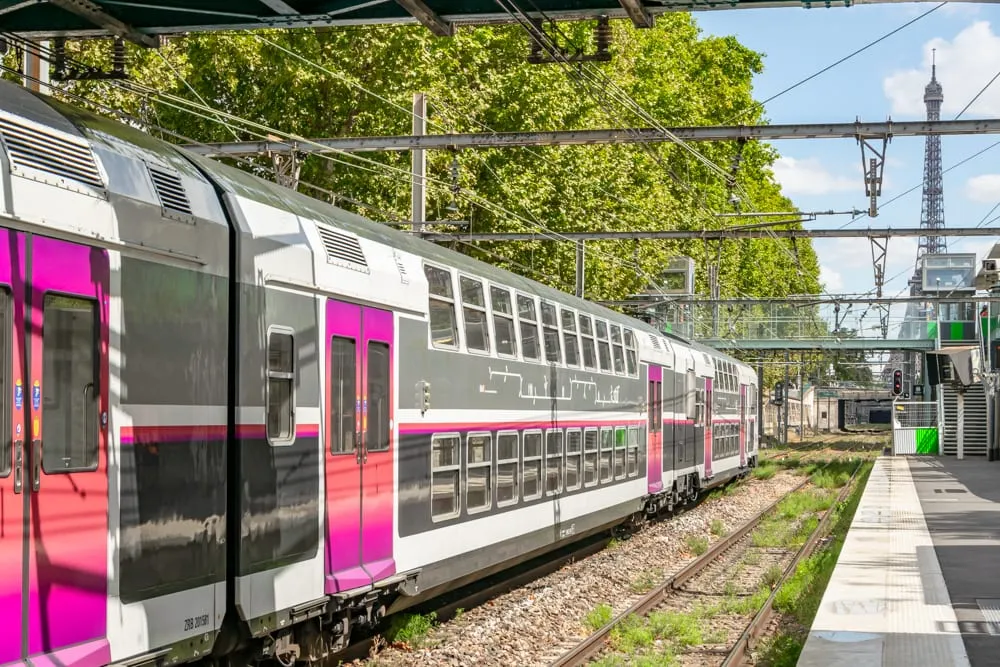
Pros of Traveling Europe By Train
Taking a train across europe is a bucket-list-worthy experience..
For most of us who hail from other places, this is the number one reason to book that first train in Europe, right?
Traveling by train through Europe tops plenty of bucket lists around the world, and for good reason: it’s an incredibly fun way to explore the continent.
On some routes, the train ride is a travel destination in its own right–and even when it’s not, it’s a cultural experience to remember.
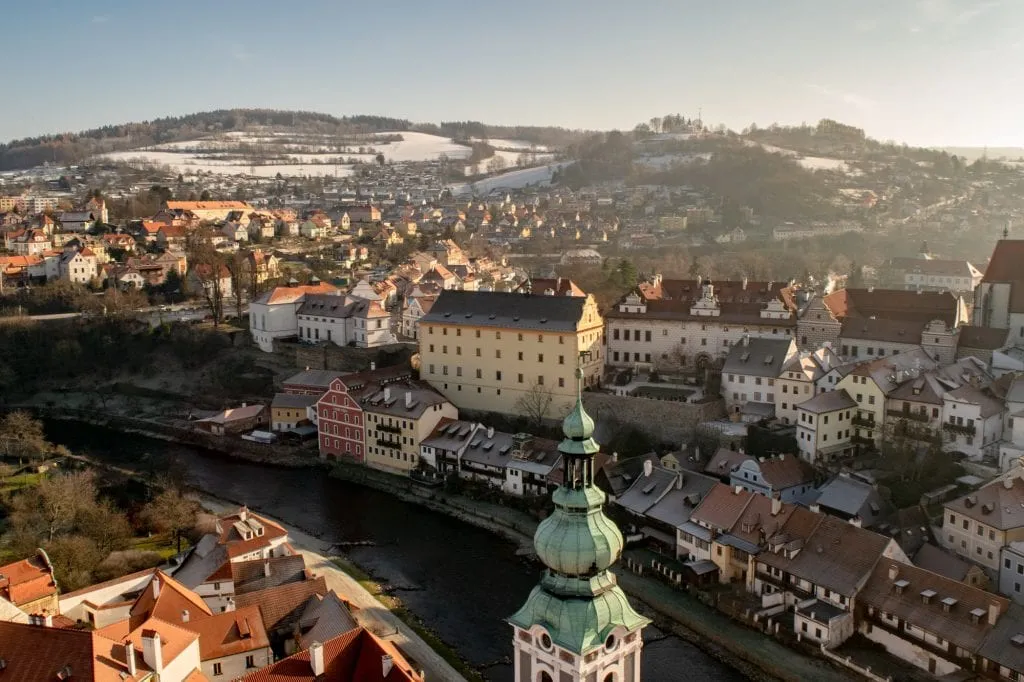
… and can allow for spontaneity.
For some routes, especially those with fixed ticket prices (more on that in another section of this Europe train guide), traveling by train allows you to be spontaneous, coming and going from destinations with much less foresight than is required when taking planes.
Depending on where you are, it can be very scenic.
If you have daydreamed about staring out train windows in Europe as you watch mountains, streams, seas, villages, castles, and vineyards go by, let me tell you… that’s pretty much exactly what it’s like a lot of the time!
Obviously not everywhere on the continent is scenic, but if you travel Europe by train, you’re likely to experience some truly incredible views along the way.
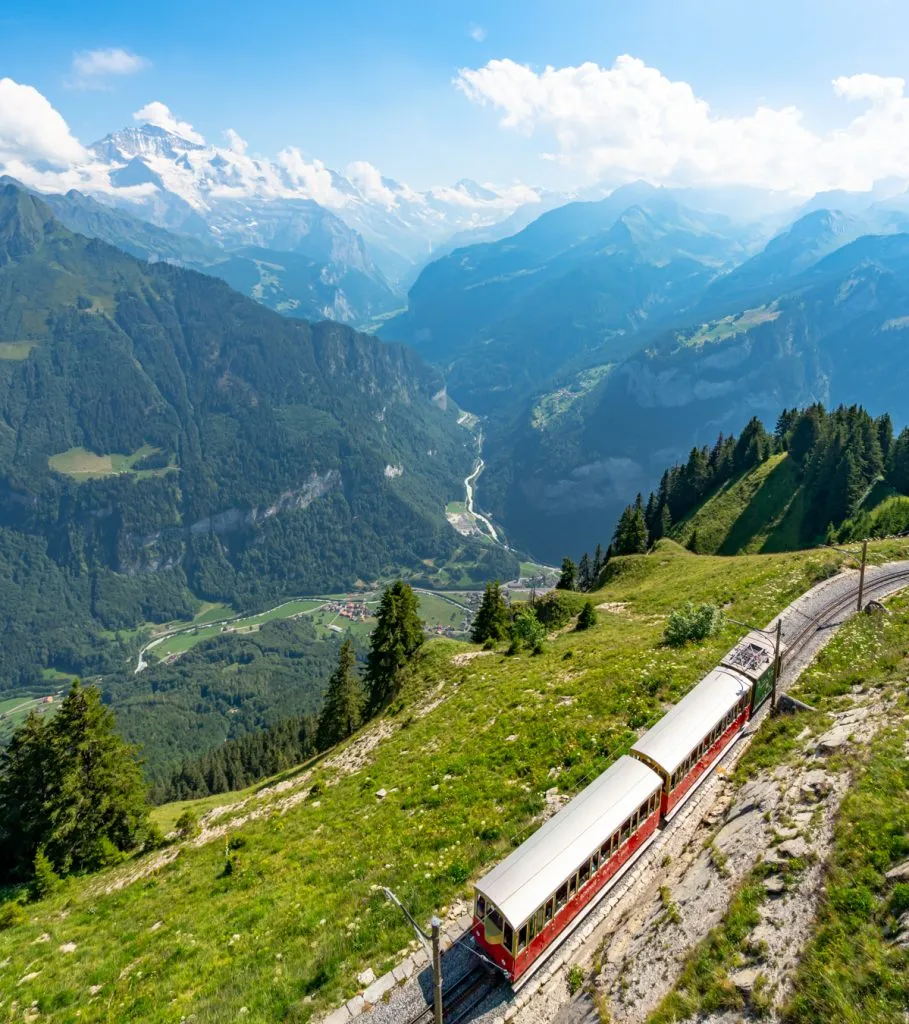
Most train stations are in the center of the city.
In our opinion, this is one of the biggest benefits to train travel in Europe!
W hile most airports (especially airports servicing budget flights) are located far outside the city centers, train stations are generally located right in the heart of the action.
Step outside the train station in Cologne, for example, and you’ll be looking at the cathedral.
In Florence , you’ll arrive less than a 10-minute walk from the Duomo .
In some places, like in Milan, Antwerp, Porto , and Paris’ Gare de Lyon, the opulent central train station is practically a tourist destination in its own right, so you’ll be exploring the minute you arrive, rather than spending hours getting into the city center from the airport.

No luggage limitations!
No one is going to weigh your luggage or make sure it is only a certain size on a train, so you can bring whatever you like (sports equipment and generally pets included).
Train travel in Europe is generally far more comfortable than flying.
At the end of the day, traveling Europe by train is immensely more comfortable than flying.
There’s less hassle, more comfortable seats, more ease of moving around, often better views, and more control over your environment.
If all else (price, time, etc.) were equal, we’d personally choose to take a train across Europe over a plane any day of the week.
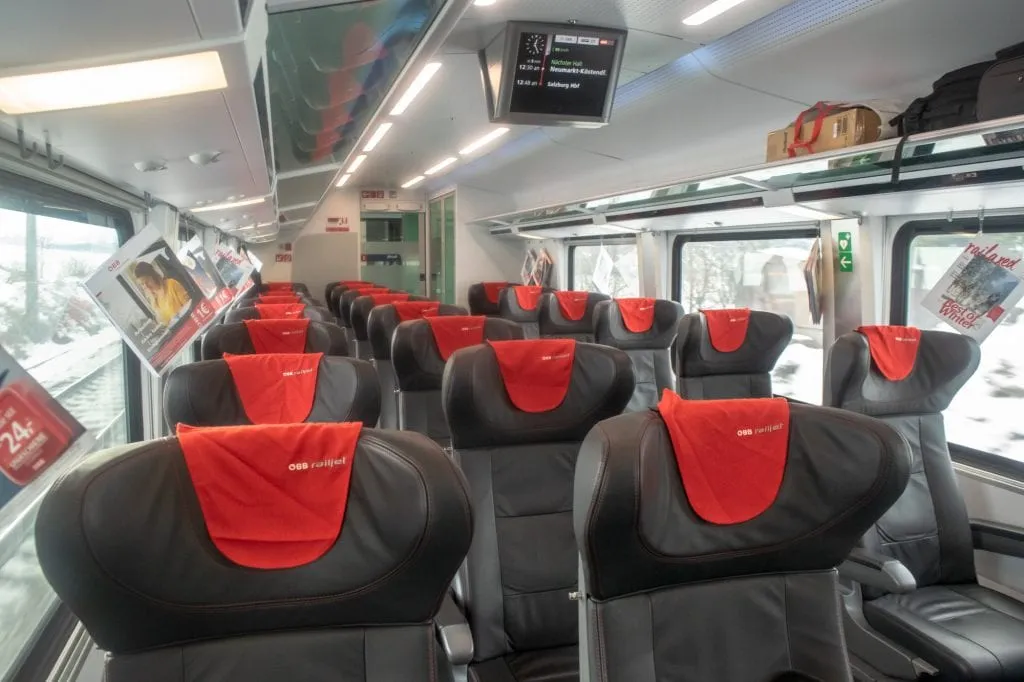
Cons of Traveling by Train Through Europe
It can get pricey..
When you first set out to travel Europe by train, you may assume that it is more affordable than flying–but thanks to a combination of several factors, including incredibly inexpensive budget flight carriers in Europe, that’s actually not the case.
Typically, it’s cheaper to hop on a budget flight between two major European cities than take a train.
The severity of the difference, though, can vary dramatically, and there are lots of tips you can apply to your train travel in Europe to mitigate the cost, which we’ll cover in this blog post.
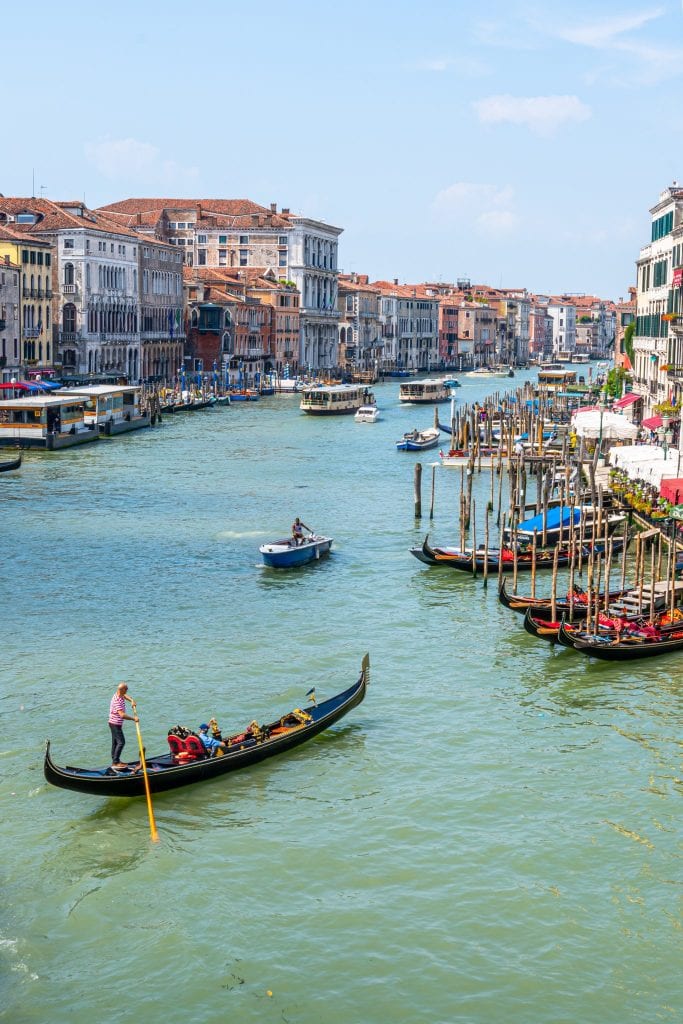
If you’re traveling long distances, train routes can take a prohibitively long time.
For example, when traveling from Paris to Venice , a route we’ve traveled by train, the train can easily take upwards of 10 hours, while the flight time is under 2 hours.
Now, that doesn’t account for getting to and from the airport, checking luggage, or going through security, all of which increase the amount of time a flight actually takes, but it’s still a large difference.
Train travel in Europe isn’t available everywhere.
As you move further into eastern Europe and the Balkans, train travel becomes much less prevalent (even popular Dubrovnik isn’t connected to the rest of Europe by rail).
A nd, when it does exist, can take longer and be less comfortable than planes or even buses depending on the destination.

Rail strikes can derail plans to travel Europe by train.
Generally, these are planned in advance, so you’ll know what you’re getting into before arriving, but they can be a bit of a hassle.
W e’ve had trips to both Italy and France impacted by rail strikes in the past.
If you have mobility issues, train travel can be difficult.
Lifting and storing luggage, navigating small staircases and bathrooms, and making your way through crowded train stations can be difficult if you struggle with mobility, so keep that in mind when deciding whether to travel Europe by train.
This is especially true with a short connection–we once had to literally sprint through the station to make a connecting train on time in Germany!

Traveling Europe by train can be a bit intimidating.
This isn’t a con, exactly, but there’s no doubt that the confusion surrounding train travel in Europe can prevent new visitors to the continent from trying it out, especially if they’re concerned about language barriers or navigating multiple countries.
If that’s your only hesitation, though, we urge you to set those concerns aside.
T raveling Europe by train is an incredibly rewarding experience, and well worth stepping a bit outside of your comfort zone for !

When discussing train travel in Europe, it’s important to remember that not all trains are created equal, or exist for the same purpose.
Here are a few general train categories to keep in mind as you plan your trip.
Metro/Intra-City Transport
Metros, aka subways (though some do run above ground) are public transportation used by a certain city.
While they are technically trains, metros are their own category entirely and this Europe train guide doesn’t cover them any further.

Commuter Rails/Regional Trains
Commuter rails and regional trains aren’t exactly synonymous, but for the purposes of this guide, they’re similar.
T hese are slower-moving trains used to connect surrounding villages to a major city (for example, Versailles to Paris) or trains that go within a certain country or region (for example, from Siena to Florence in Tuscany).
Most of the tips in this guide to train travel in Europe apply to these trains, but they sometimes have fewer amenities (like snacks/drinks available for purchase, for example) than high-speed or long-distance trains.
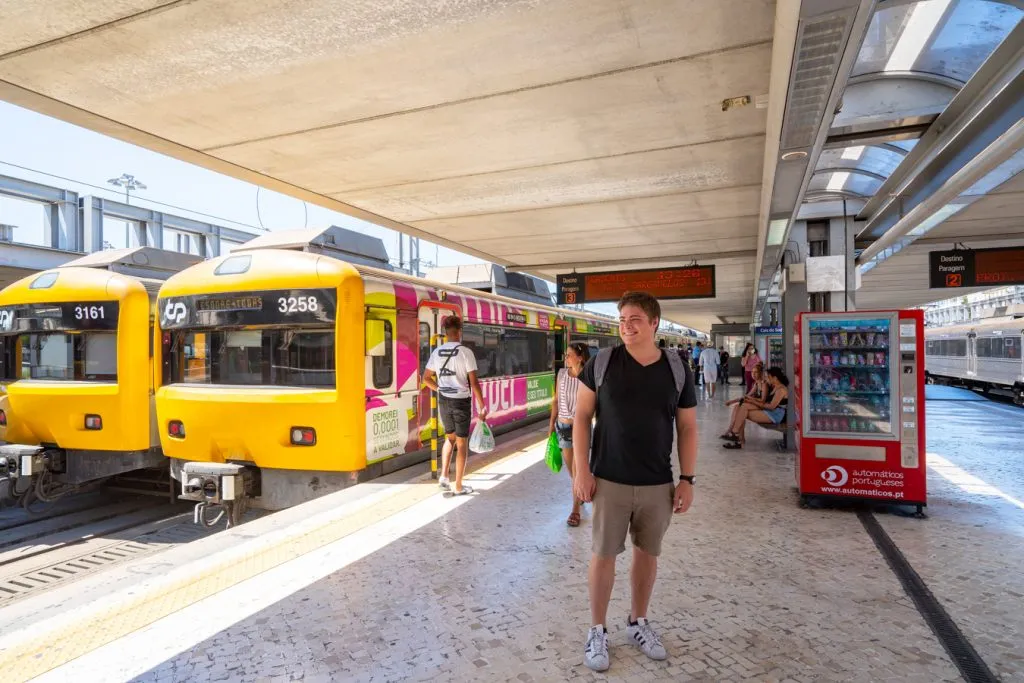
High-Speed Trains/Long-Distance Trains
These are trains that cover long distances within a country (for example, from Florence to Venice ) or cross borders (for example, from Paris to Amsterdam).
Since each country runs its own train system (often with a national carrier option and private carrier(s) mixed in), booking a ticket between countries may mean changing train companies at a city near the border.
For example, when we traveled from Paris to Venice by train, we took a French SNCF train from Paris to Turin, Italy, and then boarded an Italian Italo-branded train to travel from Turin to Venice–all booked on the same ticket.
These high-speed and long-distance journeys are the primary focus of this guide on how to travel Europe by train.

Tourist Trains
These are trains that, while technically public transportation, are typically used as tourist attractions for sightseeing purposes, and are priced accordingly.
Examples include the Glacier Express or Schniyge Platte in Switzerland, or the Jacobite Steam Train (aka Harry Potter train) in Scotland.

Sleeper Trains
Technically, sleeper trains aren’t their own category–they’re just long-distance trains with sleeper carriages in them–but they’re worth calling out separately in this guide to train travel in Europe because they’re particularly interesting for travelers.
Not only are sleeper trains a great way to save on hotel costs for a night of your trip, but they can also be quite the travel adventure in their own right!

Before you start looking into buying train tickets, there are a couple of terms to be familiar with:
First vs. Second Class Tickets
When traveling via train in Europe, you’ll generally have a choice between first and second-class tickets.
Buying a first-class ticket generally comes with slightly larger seats, sometimes the ability to reserve your exact seats when you can’t in second class (both of those facts vary based on the company you travel with), and possibly a small snack like a water bottle and a pack of cookies.
In our earlier travel years, we never used to consider these perks worth the money–but I’ll admit, as we started traveling with more luggage and most importantly, our dog Ranger, we started splurging on first-class more frequently.
The extra space can definitely come in handy if you have more than a suitcase with you!
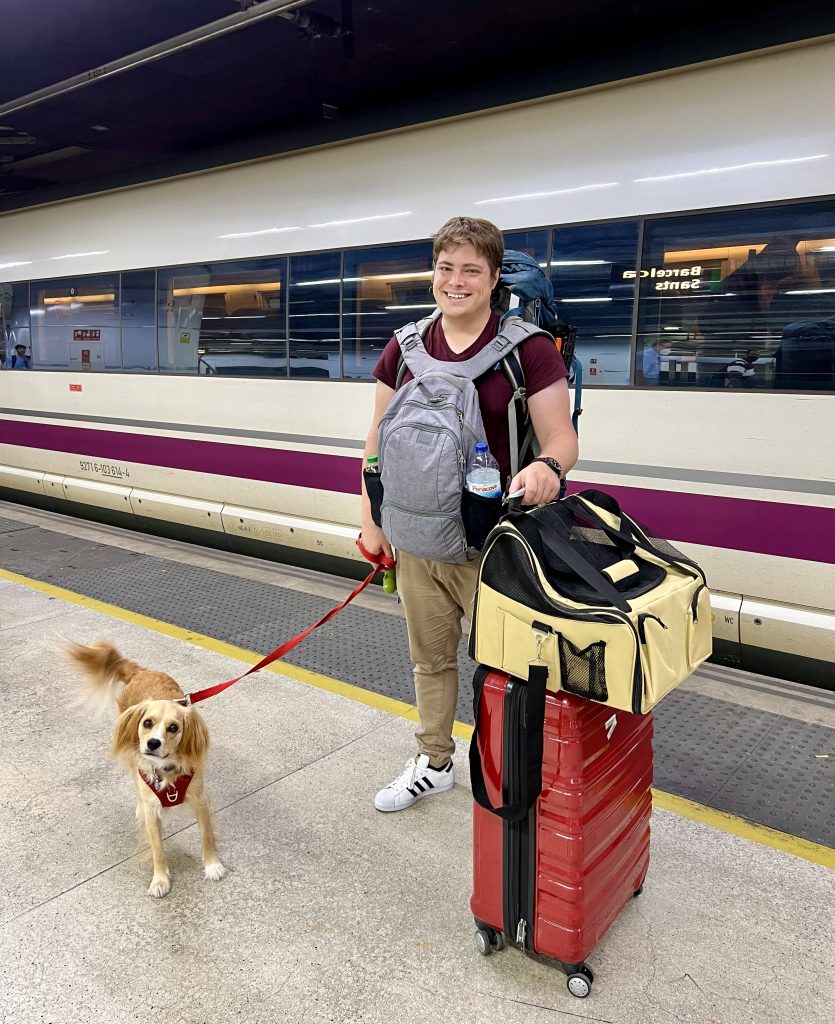
Variable vs. Fixed Price Tickets
Variable-price tickets, as the name implies, tend to increase in price the closer your date of travel gets.
T hese tickets are generally used for high-speed trains and long-distance journeys and will be the most common form of ticket you see when traveling between countries by train in Europe.
Fixed-price tickets are more typical for regional (aka “slow”) trains and can be booked at any time–so you can just show up at the station and buy them from a kiosk without issue.
For example: if you travel from Florence to Bologna on a high-speed train, it will take around 30 minutes and that ticket has a variable price.
If you travel on the regional train that takes around an hour, the price is fixed and you can book it at any time.

When you travel Europe by train, one of the first things you’ll need to get the hang of is exactly how and where to buy European train tickets–and you have plenty of options!
Here are different ways to obtain train tickets in Europe.
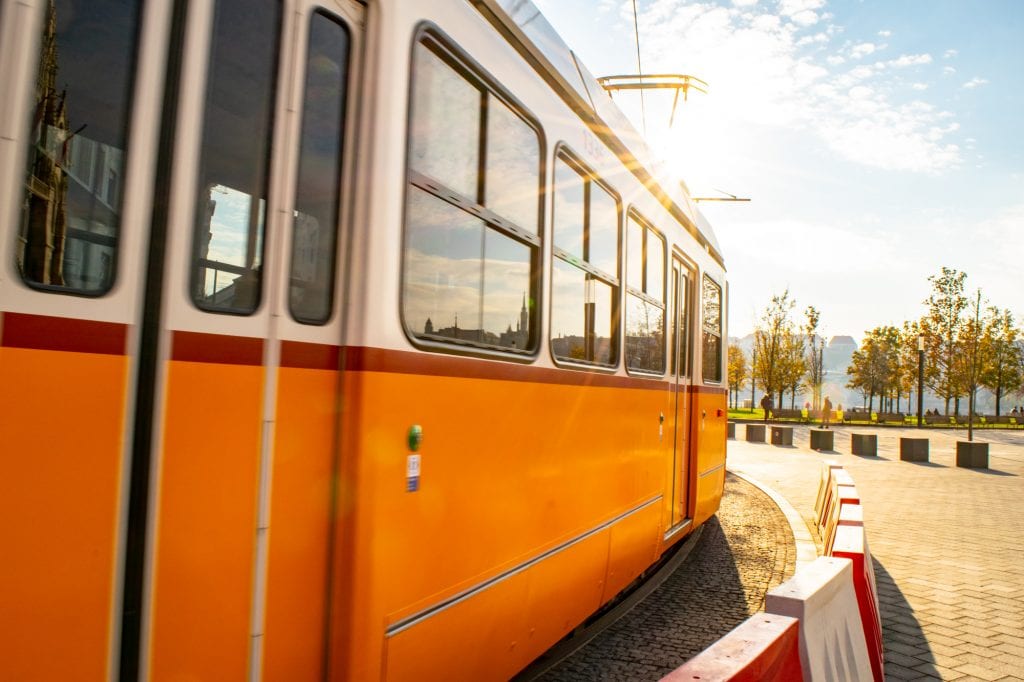
Online (Via a Third-Party Site)
Third-party booking sites are incredibly useful when preparing to travel Europe by train, especially when you’re planning to travel between countries.
We use and recommend Omio , which will allow you to easily compare prices between different routes, show you the most efficient path, and allow you to book trains across Europe with no concerns about language barriers, iffy online translations of national websites, or issues with payment (some company websites struggle to process foreign credit cards).
Omio is a ticket aggregate, and searches multiple companies and routes at once, which makes it very handy for checking train timetables and possible routes as well as for booking tickets!
Search train routes and tickets prices in Europe today!

Online (Via the Company Directly)
Alternatively, if you’re looking for the best possible deal, you can book tickets online through direct websites for most countries in Europe.
For example, here are the national train company websites for Italy , France , and Germany .
We tend to book directly whenever we’re traveling domestically in a place we’re very familiar with, like Italy.

At the Train Station
If you’re traveling a short distance on a regional or commuter rail (like to take a day trip, for example), you can also buy tickets directly at the train station.
If you’re buying train tickets in person, we recommend using the kiosks available whenever possible.
Not only do they tend to have language options that make things much easier, but they also tend to take a fraction of the time of waiting in line to be helped by a person directly.

With a Train Pass
The final option for booking tickets to travel Europe by train is to do it in one fell swoop with a Eurail pass (for non-European residents) or Interrail pass (essentially the same thing, but for European residents).
Essentially, a Eurail pass will allow you to buy a certain number of train rides (or an unlimited number) in advance, allowing you to be more spontaneous in your travels.
However, there are limitations–for example, some routes still require advance reservations and charge additional fees.
G enerally speaking, the average user will end up spending more on train travel in Europe with a pass than without one.
There are cases where a train pass makes sense, though, so if you’re planning lots of European train travel, especially in Western and parts of Central Europe , be sure to run the numbers to see if a European train pass is right for you!
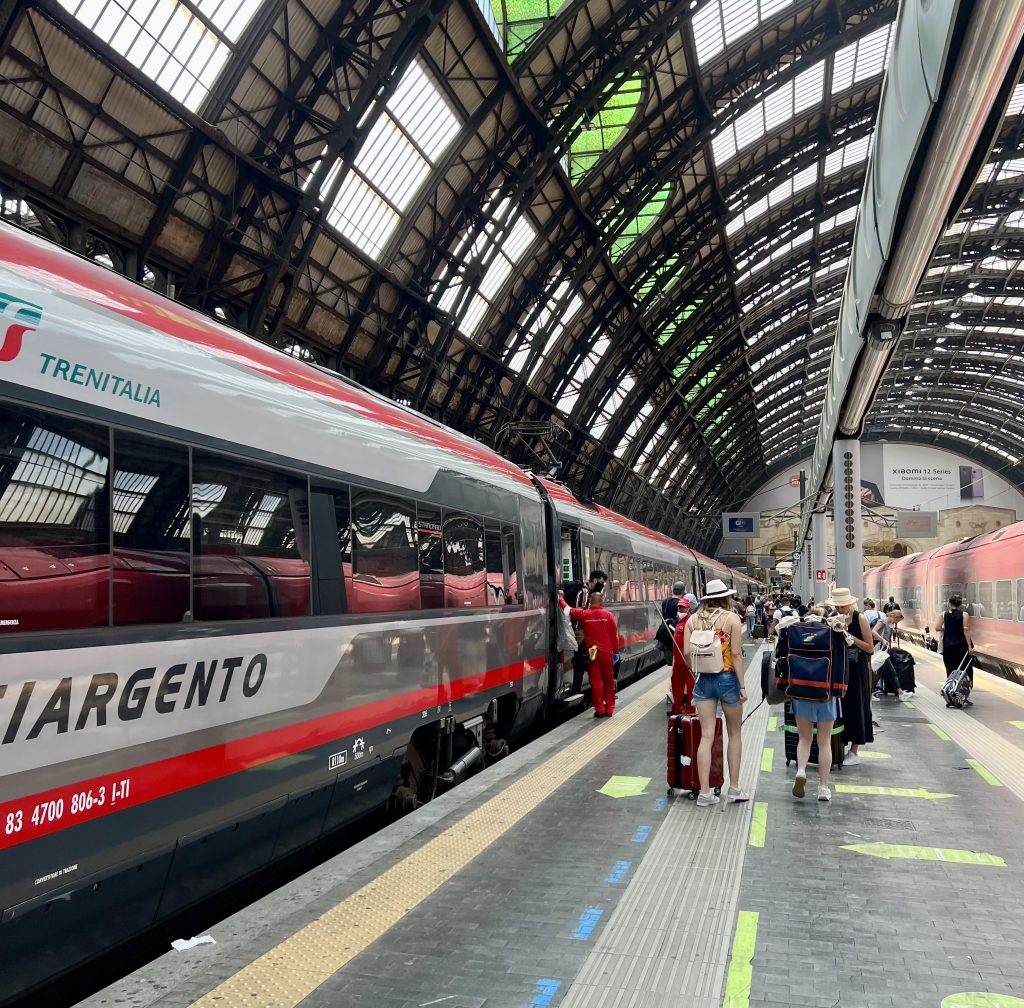
Once you buy your tickets, the next step is to actually receive them!
Here are the three main options.
Most European train tickets these days can be received online and downloaded to your phone.
When available, this is by far the easiest and quickest way to receive your tickets.
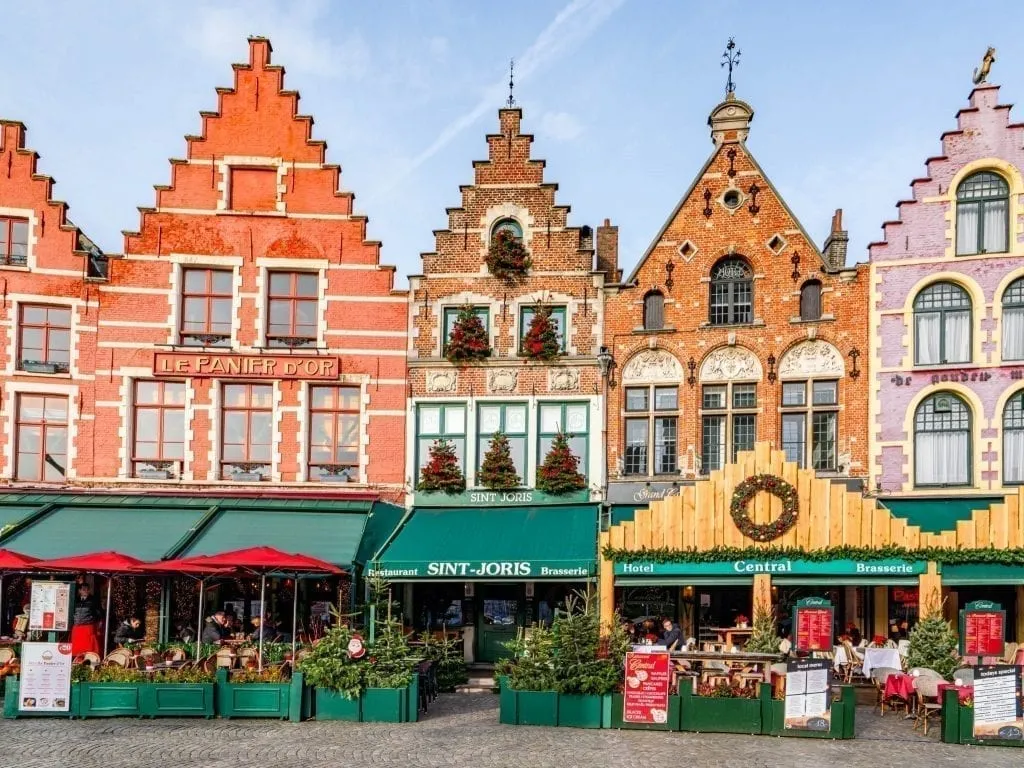
At the Station
You can also choose to receive your (paper) tickets at the station you’re departing from, either by purchasing them there as mentioned above, or by picking up tickets you bought online.
In most cases, there’s no real reason to pick up paper tickets you bought online as opposed to simply downloading them, but most countries do still have the option.

If you book tickets to travel Europe by train well in advance of your trip, many countries do also have a home delivery option where they can be mailed to you before you travel.
We took advantage of this for our very first multi-country trip to Europe and had our train tickets for our overnight route from Krakow to Budapest mailed to our then-home in San Antonio.
Honestly, it was complete overkill, even as the novice travelers we were then, and we don’t necessarily recommend doing this–but some places do have the option available.
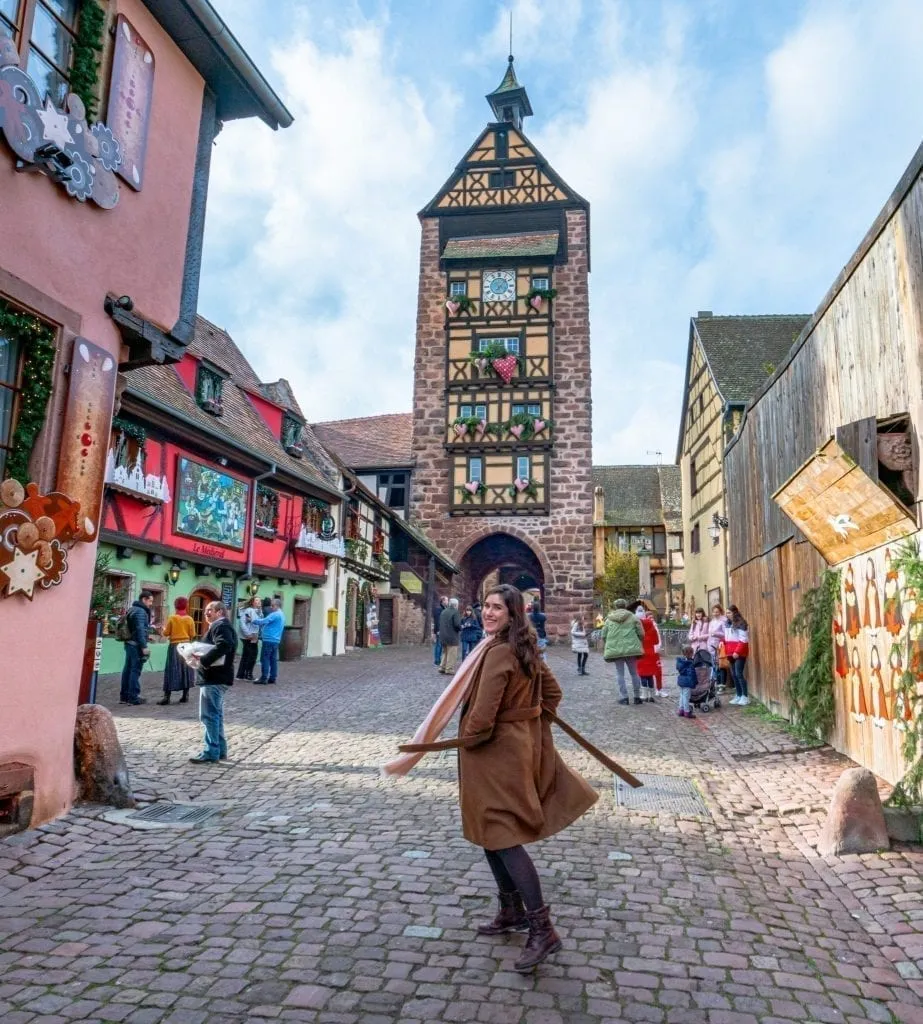
If you’re confused, concerned, or just slightly intimidated by train travel in Europe but are ready to book your first journey, this section is for you!
Follow these instructions step-by-step, and you’ll travel Europe by train with ease.
Book your ticket.
Generally, for long or inter-country journeys, booking online is the easiest option as we outlined above.
We use and recommend Omio for booking train tickets in Europe.
Shop train tickets across Europe today!

Make sure your ticket is in hand.
This can mean downloaded onto your phone or printed onto a piece of paper in your hand.
E ither option works in most places, but whichever you choose, make sure you have your ticket handy when you board.
Head to the (correct) train station.
Most major European cities are home to more than one train station, so be sure to double and triple-check that you’re going to the right one before you set off.

Find your platform.
Much like in an airport, your first step to finding your train platform will be to check the (often large, sometimes confusing) boards bearing destinations and times.
It’s best to search for your train based on a combination of the train number, company, and departing time– not the destination.
If your train is continuing past your stop, for example, searching by destination can get very confusing, very quickly.
European trains (and Europe in general) also use the 24-hour clock (so 3:00 PM will be displayed as 15:00, etc), so keep that in mind when looking for your train on the departures board.
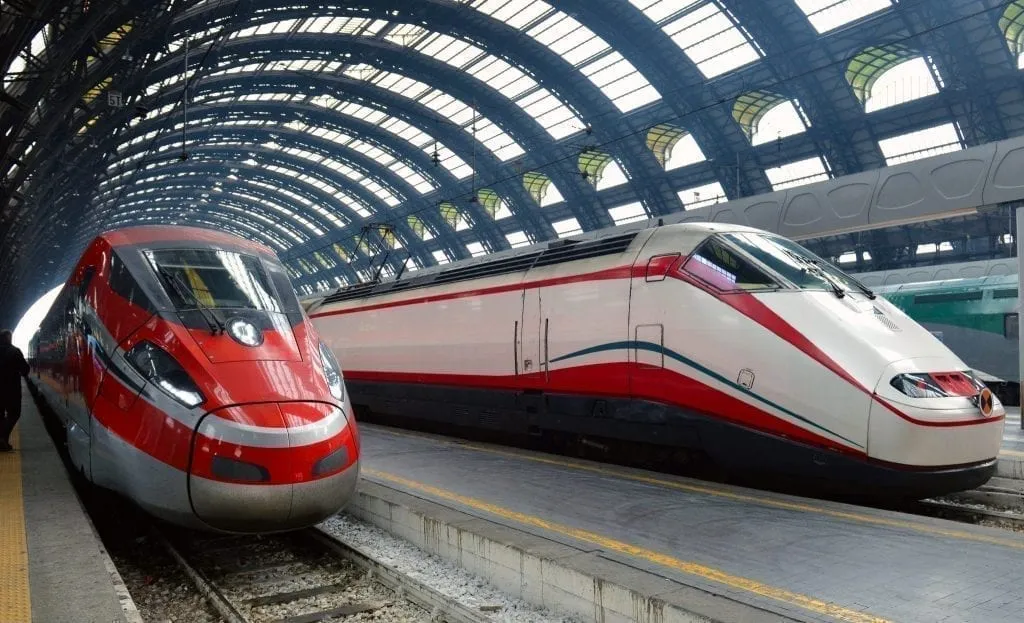
Validate your ticket.
If you have a paper ticket, you’ll need to validate it before you board.
T he kiosks to validate your ticket are generally placed just before you reach the platform, but can sometimes be easy to miss if you’re not looking for them.
(As far as we’re concerned, this hassle is another point in favor of online/downloaded tickets.)
If applicable, find your train car and seat number.
If your train has reserved seats, you’ll need to find the exact train car number and seat number to sit in.
T his is most common on long-distance, high-speed trains.
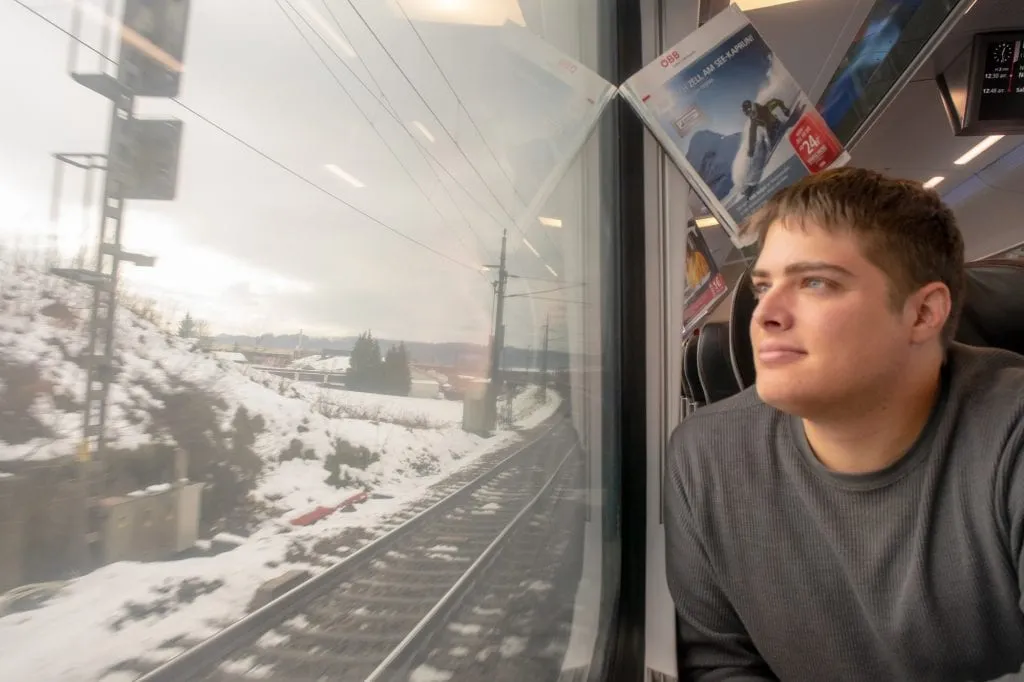
… Or just look for the appropriate class.
If your train has open seating, the only seating concerns will be whether you sit in the 1st or 2nd class.
The “1” or “2” denoting whether it’s a first or second-class train car is generally marked obviously on the side of the train, near or on the door itself, so it’s fairly easy to make sure you’re in the correct place.
Stow your luggage.
In some trains, this will mean storing your luggage in the racks provided at the ends of each train car, in others, it will mean in the racks above the seats, and in still others, there are even places to store bags between the seats.
Keep an eye on what others are doing, but keep in mind that as long as your luggage isn’t in anyone else’s way, there’s generally some flexibility to the process.

Settle in and enjoy the views.
Once you’ve found your seat and stored your luggage, it’s finally time for the best part of train travel in Europe: kicking back and enjoying watching the world go by.
No matter how many times we ride trains through Europe, we never stop getting a little thrill during this part of the process!
Keep your ticket handy for when the conductor comes by.
At some point, as you travel Europe by train–and it could be 5 minutes into your ride, 5 hours into your ride, or both–a conductor will come by to check your ticket.
Be sure to have your ticket in a convenient place so that you’re ready when this happens!

Listen carefully as you get close to your destination.
As you begin to get close to your destination, it’s time to pay very close attention to the announcements.
Many European cities have train stations that sound very similar to each other, especially to those not familiar with them (for example Roma Tiburtina and Roma Termini), and you’ll want to be certain to exit the train at the correct stop.
O therwise, you might accidentally find yourself deep in the suburbs instead of in the center of the city!
In many places, especially along routes popular with tourists, arrival announcements for each station will be repeated in English, but that’s not a guarantee.

Exit the train quickly and smoothly.
When you reach your stop, be ready to exit immediately–that means luggage in hand and waiting at the end of the train car to exit.
You’ll generally see people start to queue up a few minutes before arrival.
The train stops long enough for everyone to exit comfortably, so you don’t need to push past other people or even hurry if you’re prepared.
However, if you wait until the train stops before even getting your luggage together, well–if your station isn’t the final stop, you might find the train moves on before you have time to get off.

If you have your heart set on traveling Europe by train, plan ahead.
As you plan your Europe itinerary , you’ll likely find that some destinations are better suited for traveling Europe by train than others, and it definitely pays to know which destinations require a train, plane, or bus before arriving in Europe.
Train travel in Europe is generally best suited for certain Western and Central European countries–the further you move into the Balkans and Eastern Europe, the more limited (and, shall we say, adventurous) it becomes.
And, despite being situated essentially as far to the west of Europe as you can get, Spain and Portugal are surprisingly isolated from the perspective of train travel (this is due to having a different size of railroad gauge than other countries in Western Europe).

Distance also plays a key role.
Traveling from Paris to Venice by train is a long but completely doable day, but Paris to Zagreb , not so much–that route is better suited to a plane.
Add in the fact that you’ll want to book your variable-price tickets in advance, and the bottom line is that you should definitely bank on planning at least the most important routes in advance.

Definitely book complex routes for train travel in Europe in advance.
If you’re traveling from Rome to Florence or Madrid to Barcelona, especially if you don’t mind taking a regional/slow train, you can book your train tickets once you already arrive in Europe.
For more complex or longer routes, though, you’ll make things much easier on yourself if you book before you start your trip abroad.
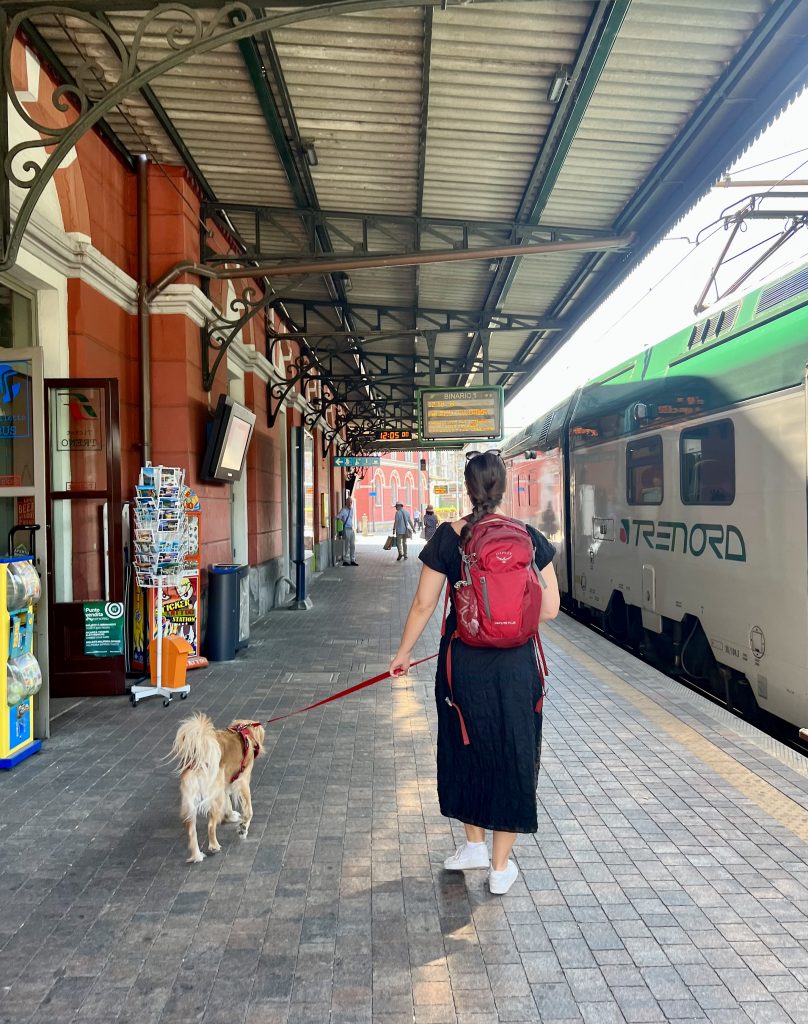
Bring snacks and drinks along for the ride.
While most long-distance routes will sell simple food on board like sandwiches, drinks, and pre-packaged snacks, the selection is generally about on par with airplane food, in other words, expensive and unexceptional.
Commuter and regional trains are much less likely to sell food on board.
On long-distance trains, there’s typically a dining car you can visit to make purchases, and on some routes (especially in first class), a restaurant cart will come around offering a few items, similar to a flight attendant.
Better not to worry about it, though: we recommend packing plenty of snacks (or even a full meal) and drinks to bring along, which is completely typical on trains in most places in Europe.

If you have a long train ride ahead, consider packing cards or a game.
Not only will this help entertain you throughout the journey, but it’s also a great way to meet other travelers!
Don’t count on having internet access onboard.
Even if you have a European SIM card and are traveling within the Schengen Zone (where SIM cards are supposed to work across borders), maintaining an internet connection on a European train ride is iffy.
B etween tunnels, remote countryside, border crossings, etc., it’s best not to count on having access.
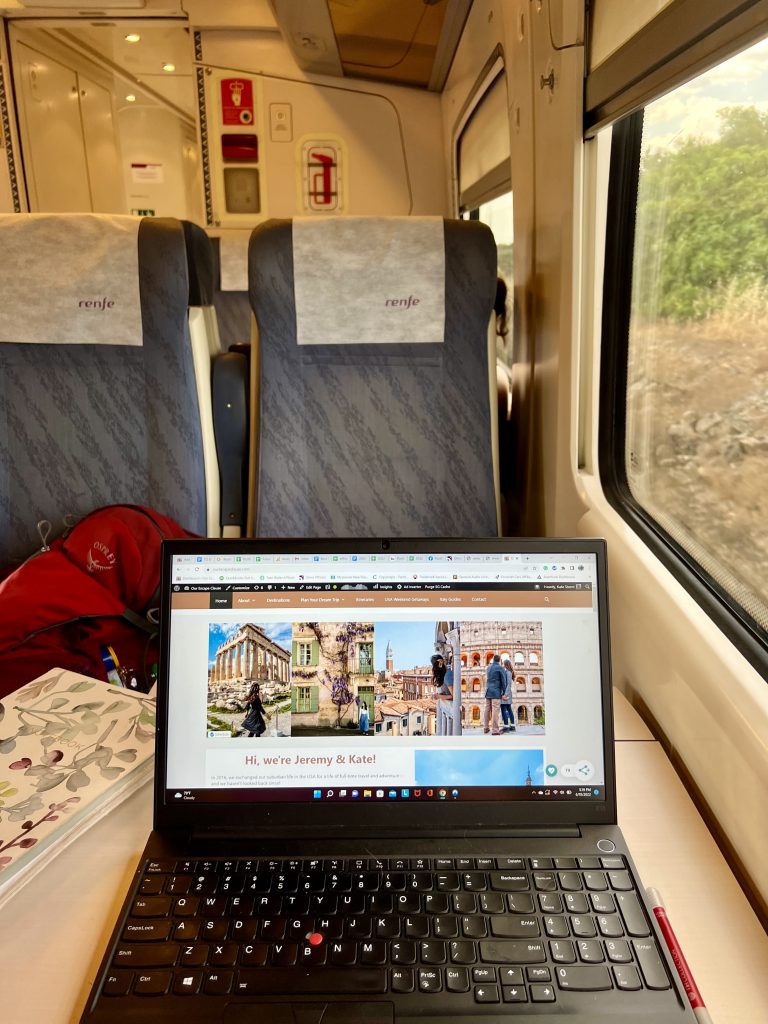
If the train advertises wifi, don’t count on that either–some of them require a local tax ID number or phone number to access.
We’ve found that our best bet for internet access during train travel in Europe is whenever the train briefly stops at a station.
If you have a SIM card that works for that destination, you can usually expect at least a few minutes of connectivity there.

Make sure you go to the correct train station.
We mentioned this above, but it bears repeating: be very certain that you go to the correct train station when traveling by train through Europe… and that goes for when you get on and when you get off!
… And show up early.
Some train stations in major cities are enormous, and can almost resemble airports, with 30+ platforms, various levels, and in some cases a mall inside them (like Roma Termini, for example).
If you’re not familiar with the station in question, be sure to leave yourself plenty of time to find your way to the correct platform once you arrive!
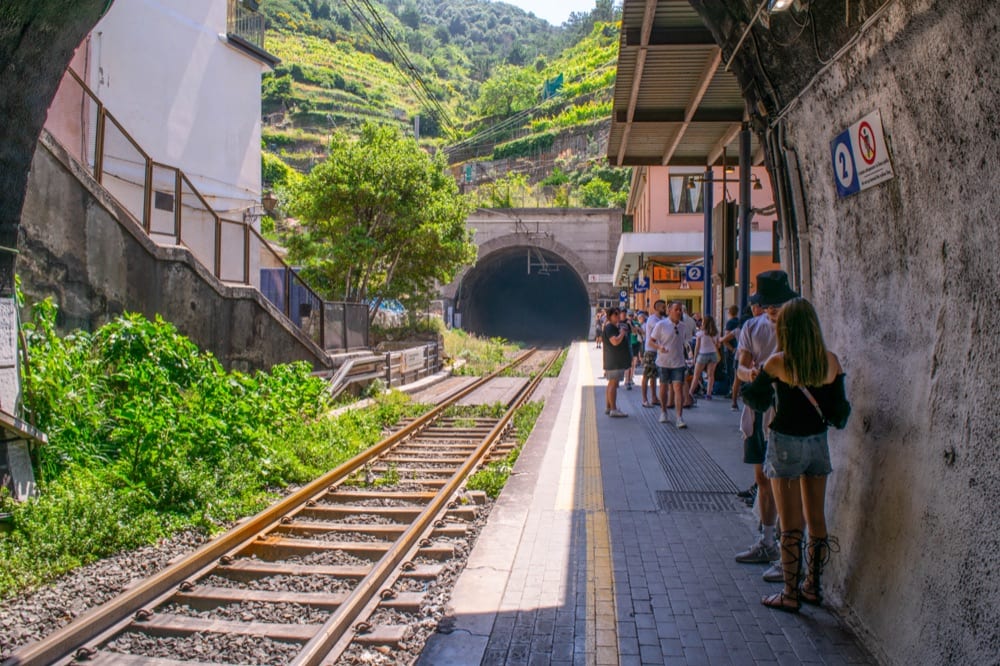
If you have an opportunity to take an overnight train, do!
Not only is it a great way to save on the cost of a hotel for the night , but spending the night in a sleeper car can be quite a travel adventure!
(Though in the interest of full disclosure, I have never once gotten what I would call a good night’s sleep on a train. No regrets, though, and we’ll do it again!).
Toilets are plentiful, but their quality is questionable.
In other words, bring some toilet paper (I usually keep a small packet of tissues handy for that purpose) and hand sanitizer.
Also, wet floors aren’t exactly unheard of, so you might want to stick with close-toed shoes.
Most high-speed trains in Europe have a toilet available in every train car, so you typically won’t need to go far to find one.
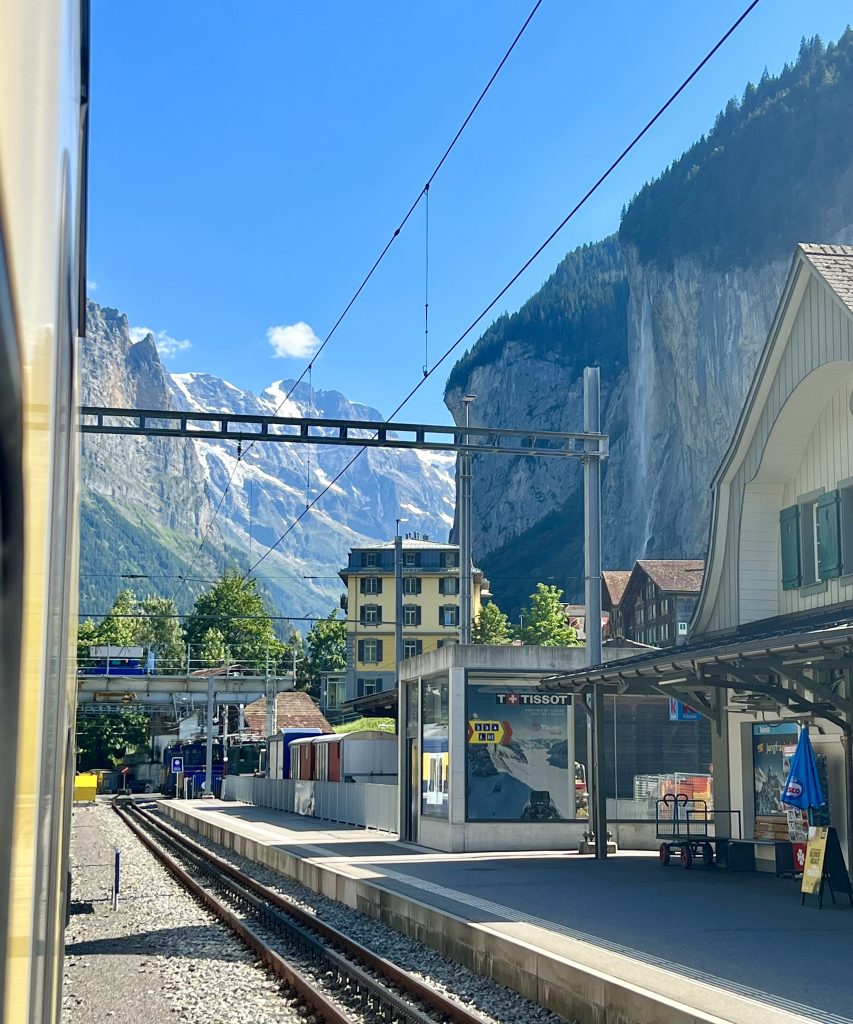
If you’re a student and/or under 26, you might qualify for discounts.
Keep that in mind when booking your train tickets for Europe, and if you do book a discounted fare, be sure to keep your ID handy (it’ll likely come in handy in many other places during your trip, too).
Keep in mind that some under-26 discounts are only available to EU residents, so be sure to verify that before counting on them if you aren’t European.
You can generally bring dogs (and cats) with you on trains in Europe!
This is a bit beyond the scope of this blog post, but given that we have several photos of Ranger in here, I’m sure at least a few readers are curious!
The vast majority of trains in Europe allow well-behaved companion animals on board, with varying requirements and costs (generally either free or the price of a child) based on the animal’s size, whether it’s confined in a carrier, etc.
It’s best to check the expectations for each route in advance, but with a little planning and flexibility, your furry friends are generally welcome.
Ranger is quite the traveler and has visited 8 countries and counting with us, many of them by train!
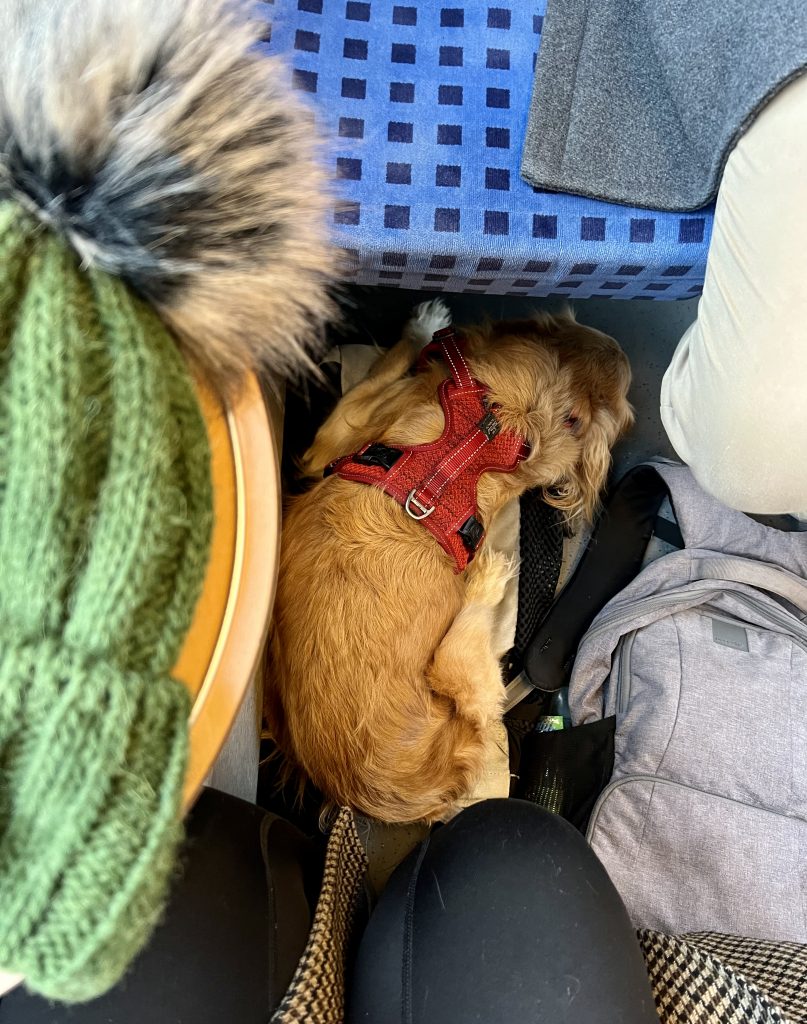
Keep an eye on social norms.
Cultural expectations around eating, talking loudly, and storing your luggage can and will vary depending on where your train travel in Europe takes you.
B e sure to keep an eye on what everyone else is doing to ensure you’re not inadvertently committing a faux pas !
For example, if you take a train, say, in Italy and then later in Austria as you travel Europe by train, you’ll likely notice a huge difference in the noise level on the train!

About Kate Storm

In May 2016, I left my suburban life in the USA and became a full-time traveler. Since then, I have visited 50+ countries on 5 continents and lived in Portugal, developing a special love of traveling in Europe (especially Italy) along the way. Today, along with my husband Jeremy and dog Ranger, I’m working toward my eventual goal of splitting my life between Europe and the USA.
64 thoughts on “How to Travel Europe By Train: The Ultimate Guide (+ Tips!)”
We are senior citizens planning a trip to Italy and surrounding areas in September 2022. Looking at some train travel, multiple cities for sight seeing. We like the smaller, picturesque, historical cities. What advice can you offer?
I definitely recommend searching “Italy” on our search bar (top right of the site on desktop, part of the menu on mobile). Italy is one of our favorites and we have (literally) about 100 posts about it!
For small, picturesque, historic cities, Siena, Venice (it is pretty small!), and Verona come to mind. Florence, too–surprisingly small in some ways!
For even smaller hilltop villages like Montepulciano, etc, in Tuscany, be aware that many of the train stations aren’t in the town center, so you’ll likely want to catch a taxi in many of them to avoid hauling luggage up a hill.
Two years ago we had a small villa in a very small town in Italy. We trained to a new place everyday. It was funned and easy. We took the local bus into the next target town, bought our tickets at the station and took off for the day. We went to Florence, Pizza, and several smaller towns. We are mature seniors and had no trouble getting around. Only a couple of people spoke english in a small town, but, we managed easily.
Your comments encourage me to locate a home base in Italy and take a train or bus to the surrounding suburbs etc. I’m no spring chicken nor my husband but we get around easily. Thank you
Thanks for the helpful information. Appreciate it!
My boyfriend and I just booked our first train tickets in Europe thanks to you!!! I’m so happy we found your blog. We’re going to France and Spain this summer!
Ahhh that is wonderful to hear! Have a fantastic time!
My wife and I, both 70 are taking a cruise from Budapest to Passau and plan on taking trains to Birmingham England from Passau. I’ m planning about 5 stops. First Venice then Tirano, St. Moritz, Sion, Strasbourg and finally Birmingham. I plan on a Eurrail pass. do you have any advice, help or suggestion. Thanks
Hi Wayne! If you’re planning on an Eurail pass, my best advice is to research your routes, dates, and times in advance–many popular routes will still require advance reservations even with a pass.
Kate, my wife and I are planning our first cruise in Europe, and are thinking about taking the train from Barcelona to Rome (cruise departure). Your blog was a great overview. My question has to do with ability to get off and on a subsequent train, for day visits on the way. Is switching covered or individually arranged ahead of time, and is it a good or bad idea for novice mostly monolingual travelers to Europe? Advice? Thanks,(Chuck)
If you book a ticket from Barcelona to Rome, your ticket will be good for that specific train/departure only, so you can’t get off and back on at various stops. If you want to stop places along the way, you’ll need to book individual tickets between each destination you plan to visit.
If you have your heart set on that, look into an Eurail pass–it does what you describe, however, it can get confusing (some routes still require advance reservations) and will usually be more expensive than booking tickets individually.
Traveling by train is absolutely doable as a novice traveler, but be sure to be careful when you’re booking your tickets (to ensure they’re the right dates/times/train stations you expect), and pay close attention to the stops to ensure you don’t miss yours.
Another option, if you’re traveling during the summer and want to get from Barcelona to Rome quickly without flying, would be to take a ferry to Rome and then train to a few places around Italy from there.
Hope you guys have a great trip!
My family is looking to travel from Lille to Amsterdam. My question is: when we depart out train that originated in Lille and transfer to a new train in Brussels, will we need to go through some form of customs before we board the train for Amsterdam? I just want to get an idea of how much time to leave for connecting trains.
Hi Matt! No customs required–all of those countries are part of the EU Schengen Zone, so moving between them via train is generally as seamless as road-tripping between US states.
And, is 33 minutes to connect from one train to another a lot of time? We have never done this type of thing before so I’m not sure if that is cutting it too close
33 minutes should be okay! Definitely move with purpose to find your next platform once you arrive, but you shouldn’t be in a huge hurry as long as everything is on time.
Kate- I am considering coming to Europe early for my Christmas river cruise heading out of Brussels. I was thinking of taking the train from the Brussels airport to Koln to see their markets and explore, and then doing a day train up to Dusseldorf to see their Christmas markets. It looks like about a 2 hour train ride on Thalys to Koln and then only about 30 minutes from Koln on to Dusseldorf. I will then take the train back to Brussels for my riverboat cruise. Does this sound feasible?
As long as the timetables work in your favor, I don’t see why not! Germany and Belgium are both great countries for exploring by train.
Hello Kate, We are looking to visit Italy for the first time in December/2022, I was looking in the train tours, visiting 4 cities (Rome, Florence,Venice & Naples). Your thoughts on train tours? Thank
Hi Sharon! I’m not sure what you mean by tour–if you mean a guided trip, they can of course be very fun with the right group, but I wouldn’t say you need one for this route.
All of those cities are very simple to visit independently by train, and we have taken trains to and from all of them many times (I’m actually typing this on a train to Venice).
Hi Kate, my husband and I are planning to fly in to Italy and travel by train to the following places: 1) Milan 2) Switzerland 3) Vienna 4) Prague 5) Paris
May I know if these places can be connected by train. If yes which train will you recommend, please. We are actually thinking about 15-20 days to cover these areas. As it’s our first Europe trip, do you think it’s sufficient and is there any place along the way that you would encourage to go. Thank you.
Yes, those are all excellent destinations to visit by train, so you’re good to go there. As far as specific trains, you’ll need to pull up the individual routes to check (we recommend Omio for this, especially with cross-border trains).
That’s definitely too many places for 15 days, though, and still pushing it at 20. I’d recommend trimming the itinerary a bit if you can (or adding on extra days, of course!).
Hi there This was so helpful. My husband and I are going to Amsterdamin September and then 3 nights in Bruges. All us booked but I’m overwhelmed but the trains websites. Omio is the easiest but I’m still leary. Is it legit and a decent safe way to book trains? We are only going to Belgium. Then two days to the countryside in The Netherlands which we will just grab a regional train. Everyone is telling us to book the train to Bruges. Any helpful advice would be great. We would go to Antwerp and take an IC train to Bruges an hour later,as my husband does have hip and knee problems. Thanks in advance.
I understand, it’s a lot to take on the first few times!
We use Omio regularly, as do many people we know, it’s perfectly legitimate.
The Antwerp train station will be a beautiful place to rest for an hour. It’s absolutely stunning, especially the front foyer, and often pops up on lists of the best things to see in the city!
Hi Kate, My husband and I will be traveling from Prague to cities in Austria and Germany by train next month. We have used trains a few times in Europe before, but it was pre Covid. It looks like most Covid restrictions have been dropped, but I wondered if you have to show Covid vaccination cards on the trains?
Thank You, Jaymie
I’m always hesitant to answer questions like this because I feel like I’ll be summoning disaster with how quickly things can change, LOL.
But at the moment, no, you won’t need your vaccination proof in either place as far as I know.
Life is pretty 2019 these days when it comes to the logistics of traveling around Europe as a visitor, though a handful of places still require masks on public transport (I think Vienna is one of them, but again–things change!).
This is so helpful, but I’m striking out with trains from Naples to Rome? It says that there aren’t any? Why would they list it as an option if they don’t travel to there? Also, is there a way to preview how long the train rides are to decide if we want to travel to certain cities? Cannot find any train tables. I find the Omio and Eurail sites to be difficult to navigate and I can’t get enough information to plan! 🙁 Does it make sense to buy a eurail pass first and then research times and etas? Any help is appreciated!
Trains from Naples to Rome definitely exist! It’s possible you’re looking too far in advance to book the tickets–on Omio right now, it looks like I can purchase Naples to Rome tickets up to about 6 months out.
When you search for a specific route on Omio, Trenitalia, etc, it’ll show you how long the train is and how many changes there are, if any, much like searching for a flight.
We don’t recommend using the Google tool for this, as it tends to default to how to get somewhere if you leave at that second, which can be confusing and normally involves a more complicated route than you need.
Personally, we don’t generally find Eurail passes to be worth it in terms of cost-savings for most travelers, but in terms of research, you’ll be working with the same information either way. 🙂
Hope that helps! It can be a bit confusing at first, but if you try practicing by looking at dates sooner than when you actually plan to travel, I think you’ll find the information you’re looking for.
Thank you for taking the time to write all that useful information. It is so much appreciated by many of us! 🙂
Like many of your readers, we are (two young adults) planning to visit Europe for the first time this upcoming May. We are currently looking at: Landing in the morning in Prague, spend 1 or 2 nights, then Vienna, one night, leave following morning for Bratislava (this one is a maybe, it’s so close!) OR Vienna to Venice. Spend 1-2 nights, then Zurich, and finally Munich, before we make it back to Prague to catch our returning flight. We are looking at 9 days from the morning we land. 🥴 We figured it would be more efficient to travel in a circle, as some destinations -like Paris- will be out this time around. 🙁
Thoughts on that? I will look into Omni regarding trains, but our plan is to travel only by train, if possible.
I know that’s a lot of questions, but THANK YOU so much for your help! 😊
Thanks so much, Al! So glad to be helpful. 🙂
You definitely have the right idea with traveling in a circle, though I definitely recommend trimming some destinations!
With 9 days, I’d suggest no more than 3 base cities (and that’s pushing it), and you can add a day trip or two from there if you like.
I know it’s SO tempting to add more places (I have this problem constantly myself lol) but you’ll have much more fun with a bit of time to explore each place!
I’m not sure what your priorities are or what your budget is, but based on the cities you listed, I’d cut Zurich (Switzerland is amazing, but you don’t have time) and Bratislava. Ideally, I’d suggest cutting one more city as well.
If it were my trip, personally, I’d do a Prague – Venice – Munich triangle, and potentially day trip to Neuschwanstein Castle or somewhere else in the Bavarian Alps with one of the days in Munich. That’s just personal preference, though!
You can definitely do all the destinations you listed by train, no issue there at all. 🙂
That recommendation sounds amazing. The two big ones are Prague (#1!) and Venice, but really hoping to do Munich as well.
I will look into the Bavarian Alps, as I am not familiar with them 🙂
Thanks again. Really enjoy reading through your content! 😊
If you love mountains and/or castles, you’ll definitely love them!
Enjoy some Czech beer for us 🙂
Hi, we are doing Europe by train in June. Is there a way to determine: a. which direction the train(s) are going, so we can face forward? b. Which side is considered the right side (vs left side) for best views when recommended? Thanks for your perspective.
Unfortunately, there’s no clear-cut way to determine which way trains are facing, especially because they often turn around during the route, depending on how they pull into/out of various stations. On long journeys, it’s not uncommon to find yourself facing forward part of the time and backward part of the time.
If you’re starting from the beginning of the line, you can sometimes tell which way you’ll be facing at the beginning based on the route, but not always.
The same goes for the views–for very specific routes, you can sometimes get personalized recommendations from others who have traveled the route (especially for particularly scenic ones), but there’s no simple solution to figuring it out beyond just recommendations.
It’d certainly be easier if that were the case!
Hi Kate, Really enjoying your posts, photos, and appreciate the helpful advice. I am planning a trip in Sept/Oct to visit Scotland for a week before traveling in southern Germany and Austria. What would you recommend about getting from Scotland/London to Koln, Munich or Frankfurt? Is there a good train route to take? Or is this a case where flights make more (economic or time) sense? Thanks for any pointers!
That’s definitely a route that is better served by flight, both from an economic and time perspective! 🙂
Is there something I am missing about Omio, the booking site that you recommend?
My wife and I are moving to Lyon in April and plan to go to Amsterdam in May. I went on the Omio site just to get a sense of what was available from Lyon (Gare Part Dieu) to Amsterdam (Centraal) on a random date (I picked May 9) and the site told me it could not find any trains between these places. But on the Rail Europe site, it showed a slew of trains available throughout the day.
I am confused.
I am too, I’m not sure why it’s not coming up! I just did the search myself and played around with dates, destinations, etc. Paris – Amsterdam, for example, seems to be pulling up just fine.
Could be as simple as a bug, but I just shot Omio an email asking for clarification.
Hi Kate I am Josh from KL Malaysia looking forward for europe trip in september 2023. I would like to start trip from berlin to budapest for 15 to 17 days.how to go about it by using eurorail?
Eurail has a website with a planning tool that can help you sketch out your journey.
Generally, you’ll buy either a set number of travel days within a given time period (like 7 days to be used in a month) or an unlimited pass.
Many routes do still require advance reservations (with additional fees), so be sure to check each route individually so you don’t miss anything!
Hi! I would love to travel as comfortably with my dog as you have, seeing from the pictures. I have a couple of questions: 1) what’s the name brand of that pet carrier. Looks perfect for mine. 2) Could you post tips on hoe to travel with your pet successfully.
Thank you for your content!
Yes, absolutely–with a catch (if you’re in the US). We bought the bag on Amazon Spain when living in Portugal and don’t know of an equivalent here. But this is the link: https://www.amazon.es/-/pt/gp/product/B00XR2D94W/ref=ppx_yo_dt_b_asin_title_o07_s00?ie=UTF8&fbclid=IwAR3p0Ihrxf6e1yL4nJv5pJBK0GXmOIVIqXL97ov77VRuxSIvm61M2-NbfQE&th=1
Here’s Ranger’s backpack that he gets carried in as well (size large): https://www.amazon.com/gp/product/B07C9XLXVH?ie=UTF8&th=1&linkCode=ll1&tag=ourescapeclau-20&linkId=813c9a64c05de1faef0162cbed102f22&language=en_US&ref_=as_li_ss_tl
He absolutely loves both–gets so excited when we get his bags out, and climbs right in when we get onboard!
Traveling by train in Europe with a dog is usually pretty simple, but you’ll always want to look up requirements for the specific country/train company (some require dogs not in a carrier to pay a half-fare or child’s ticket, etc).
If your dog is very small (like a yorkie or similar) they’re usually free, though again, be sure to check in advance.
I have it on my list to write a whole blog post on this topic eventually, but I hope that helps get you started! 🙂
Just wanted to say thank for you for such amazing content. We are starting to plan a 5 week trip to Europe for Summer 2024 with our 4 kids and your site and recommendations are beyond helpful.
Thank you so much, Megan! That’s wonderful to hear. 🙂 Hope you guys have an incredible trip!
Hi, planning a trip to Europe with the family. Have been to Italy, Spain, Portugal, France and UK so we are looking for something different. Like Berlin, Prague and Vienna or Amsterdam, Berlin and Brussels. Love to get your thoughts on these routes and would you recommend taking the train between these cities? Or any other 3 cities you recommend we do over 10 days.
Sounds like a very fun trip! All of the cities you mentioned are definitely doable by train, but Berlin-Prague-Vienna is more cohesive than Amsterdam-Berlin-Brussels (I also personally would put a couple of dozen other cities in the region ahead of Brussels, though it definitely has things to offer!).
Since it seems like Berlin is a priority for you, I’d recommend using that as your anchor and spanning out from there.
A few other places that could make sense, if you want to add more options to your list, could be Krakow, Budapest, or Bratislava.
If you want to start in Berlin and include Amsterdam, you might look into Hamburg, Cologne, or Bruges.
You could also head south from Berlin, and do a Berlin-Munich-Switzerland (Zurich or Lucerne if you’re looking for cities) route.
Really, the possibilities are endless, so it just comes down to the cities that call to you the most!
We are seniors, experienced travellers but novice on trains. We have 3 weeks to visit Paris, Prague, Vienna, Bern, Marseilles, Barcelona, and Lisbon. What suggestions can you offer us Thanks
My first recommendation would be to trim a city or two–3 days per city is a very fast pace to keep up for 3 weeks!
Lisbon and Barcelona are of course the biggest geographic outliers. Lisbon is a non-starter as far as train travel to the rest of these cities is concerned–realistically, it’ll make more sense to fly to and from there.
Barcelona is a bit tricky, since Spanish and Portuguese trains are on a different rail gauge than the rest of the countries on your list. You can take a high-speed train from Barcelona to Paris, but getting from Barcelona to Marseilles via train is much more challenging than you’d think it would be based on a map.
The rest of the cities you mentioned are very well-connected by train, so you shouldn’t have any issues there. 🙂
Really informative site you have here!
I’m from Asia and planning to visit Europe for the first time in Oct 2023. I’ll likely start the tour from London and have about 10 days, then will fly home from Heathrow Airport London. I’m really into trains and would love your advice on what some destinations would be possible. I’ve never been to Europe so anything is fine with me. 🙂 Thank you
Honestly, the number of options is so overwhelming that you’re going to want to narrow it down–a lot!
Assuming you plan to hop over to mainland Europe (as opposed to heading north to Scotland, for example), Paris and Amsterdam are both great jumping-off points connected to London by train.
From either city, you can then reach dozens of cities within several countries in a day’s worth of train travel (or less).
Consider taking a look at places that interest you in France, Germany, Italy, Switzerland, The Netherlands, and Belgium–just to name a few!
If you want to peruse some sample itineraries, we have several in this post: https://www.ourescapeclause.com/2-week-europe-itinerary-trip/
Hope you have a fantastic trip!
Thanks for all the info contained within this blog. We are planning for summer 2024,a 2-week tour of Europe starting and finishing in the UK. How many stops would you recommend? Where would you suggest?, need to combine, beach, sightseeing and something in the Alpes? Ive got in mind Uk – South of France – Italy- Budapest-Krakow – Germany(or similar)-UK Now for the tricky bit, we are planning to do this with around 20 Explorer scouts! Any tips for travelling in groups? Can you also recommend a great website for hostels Thanks in advance
Sounds like quite the trip! 20 scouts–you guys have your work cut out for you, but I’m sure they’ll love it. 🙂 Can’t offer much personal insight in that direction myself, but I commend you guys for taking it on.
With only 2 weeks, I’d recommend 3 stops, with an additional day trip or two to add on more destinations. Sticking with the UK – South of France – Italy might work best in your case. Germany and Switzerland would also work as potential substitutes as they’re geographically close (depending on where you go).
We go into a lot more detail on putting together a 2-week itinerary in this guide: https://www.ourescapeclause.com/2-week-europe-itinerary-trip/
As far as booking lodging goes, we tend to book all of ours through Booking dot com these days. For hostels in particular, Hostelworld is also popular, though we have rarely used it ourselves. Depending on how old your scouts are you might want to double-check any age requirements for dorm stays.
We are a couple in our 60’s who have travelled by train in Italy and Japan .We are travelling to Greece for 2 weeks then flying to Hamburg.From here we are going to travel straight to Berlin(3 nights),Amsterdam(3 nights),Paris (5 nights),Interlarken,Switzerland (3 nights) then to Munich(4 nights). I have just started researching the best way to purchase rail tickets either a Eurail pass or point to point on Omio.Considering our itinerary what do you recommend?I have read that a Eurail pass is easier than point to point bookings but may be more costly.
Thanks for your blog,very informative.
Hi Francine,
In our experience, Eurail passes tend to be a bit more expensive for most travelers. Part of the reason for this is that many popular routes still require advance reservations that require you to commit to a date and often pay an additional reservation fee.
We have used an Eurail pass in the past, but these days, we always choose to book point-to-point journeys.
However, the only way to know for sure about your route in particular is to plan your trip out via Eurail (be sure to double-check what routes require reservations) and as a point-to-point trip and compare prices. Every trip is different, and since the prices for high-speed trains change depending on when you book them, there’s no way to know for certain.
If you’ve been comfortable traveling by train in other countries in the past, I wouldn’t say the ease of using an Eurail pass is worth the probable extra cost, especially with how simple it is to book train tickets online these days. It does depend on the traveler, though!
Thanks for the information Travelling to krakow then Prague Budapest and Croatia. Have 2 month. Would like to travel by train How far in advance do you need to book train tickets as I want to do it leisurely and not book to far in advance. Also what other country’s/cities do you recommend Thank you so much Betty
For most routes in that area, booking as you go (a few days to a week or so in advance) is just fine, as long as you’re a bit flexible. Exceptions can include night trains and traveling over holidays, so keep that in mind!
Keep in mind that train travel in Croatia is much less expansive than you might think–Dubrovnik doesn’t even have a train station! You can use some train routes, like Zagreb to Split, but plan on adding in buses and/or rental cars (plus ferries, of course) depending on where you want to go in Croatia.
With 2 months to travel from Krakow to Croatia, you might also consider stops in Austria (Vienna is right along your route), Slovakia (Bratislava is very easy to reach) and Slovenia. Depending on how direct you want to travel, Bosnia and Herzegovina could fit in as well.
That barely scratches the surface of the possibilities, but hopefully it gives you some ideas!
Hi! My wife and I love to travel (Between the two of us we have done Italy, Fiji, Australia and many others). We are planning on the F1 races in Spielberg, Austria next June. Thinking about the train from Vienna to Barcelona after and wondering if the ride (about a day) is worth the time? The flight is about 5 hours. We had fun on the train in Italy (Rome to Venice) We will likely leave Vienna the Mon or Tues after and have another 10 days. What do you think about Barcelona and Madrid? Do both? Or one over the other? Thanks in advance!
The distance between Vienna and Barcelona is far enough that unless the idea of a night train and a few train changes sounds like a fun adventure, I’d recommend flying! Basically as a travel experience it can work, but as a basic form of transportation, they’re a bit too far apart for the logistics to make sense.
As far as Barcelona and Madrid, both are wonderful, but they’re very different. Barcelona wins on whimsical architecture and access to the sea. Madrid wins on stately art museums and for having a more laid-back vibe. We enjoy both cities, but Madrid is our personal favorite of the two (though we are in the minority with that opinion!).
If you have time to spend a few days in each, they’re definitely both worth experiencing.
Hi! Thanks for the reply….sounds like flying is the way to go….we will have 4 days each in Madrid/Barcelona so should be able to get the flavors of both. Love your blog!
Thanks, Greg! Enjoy Austria and Spain! 🙂
Hi Kate! I just found your blog while planning my first Europe trip… I’m so excited I have actual tears! I promised myself traveling around/to Europe would be something I accomplish by the time I turn 25. This train travel blog has given me so much needed information as when I originally started planning this trip a few years ago my original plan was by train. I will be combing through your blog site to read as much as I can and support you how I can.
My plan is to start in southern Portugal, through southern Spain, southern France, into Italy. I need to do more research to see if this much in a 2 week time span is even feasible. And, it looks like I may be better off taking a bus in Western Europe. This has been my one hurdle in actually going. If I’m going to go, I’m going to visit multiple countries… but the navigation between countries is the most fearful part for me. I will be using your blog to help me plan and prepare.
All this to say… I’m so glad I found your blog!! Thank you for all of your wonderful information.
Your comment brings a huge smile to my face! I remember planning our first trip so clearly at about the same age (I was 23 on our first-ever trip to Europe and 24 on our first multi-country European backpacking trip) and I can definitely say it was nothing short of life changing. 🙂
All of the places you mentioned are among our favorites in the world! And reading between the lines, it sounds like you may have a preference for coastal areas, which all of those areas have in spades.
One small snag is that you have chosen some of the hardest places to travel between countries by train in western Europe, namely Portugal and Spain. Getting between major cities by train is no issue within each country, but the two aren’t very well-connected by train to each other, and the only train route to France from Spain leaves from Barcelona. There’s a long history as to why, but basically the train rail gauges in the Iberian peninsula are different than elsewhere.
However, don’t worry! There are plenty of solutions. 🙂 Buses are definitely a great option, especially for getting between places like the Algarve and Seville, etc. There are local buses, but also check out Flixbus, which is very popular with travelers and easy to use (we’ve used it many times ourselves). Also, flying is a surprisingly affordable option–Ryanair, Easyjet, etc. have tons of routes in these areas and are frequently way cheaper than traveling by train. Blablacar–basically Uber for traveling long distances–is also an option, though not one we have lots of personal experience with.
Finally, don’t forget about ferries! They can be surprisingly affordable, especially in Spain and southern Italy. We took a ferry from Barcelona to Rome and found it very memorable with amazing views: https://www.ourescapeclause.com/barcelona-to-rome-ferry/
As I always like to tell people, getting on that first plane and starting your trip is the hardest part. After that, everything falls into place. 🙂
Hi Kate, Your blog has been super informative and helpful! We are planning a family trip to Europe this May with our 3 teenagers. Our goal is to do Rome (4 nights), Venice (2 nights), Salzburg (3 nights) and Munich (4-5 nights) in 15 days. Planning to fly into Rome and fly out of Munich or Frankfurt (Dallas is home), and travel by train from city to city. Are we taking on too much? Do you recommend using the fast train from Rome to Venice? Really want to take the train thru the Alps from Venice to Salzburg, but is it going to be much more expensive than flying? I’m assuming I need to book that leg of the train trip asap. Again, great job on the blog! It has made me very excited for our trip!
That’s great to hear, thank you!
That sounds like a good pace for a trip–if anything, 5 nights seems slightly long in Munich, though very doable with a day trip or two built in (and there are plenty of amazing ones in Bavaria!).
Taking the fast train from Rome to Venice would absolutely be our preference–it’s the fastest way to travel between the two cities by far.
Same for Venice to Salzburg (it’s a lovely train ride!). but yes, it can be more expensive than flying depending on when you book and how good of a flight deal you get. It’s much more comfortable regardless, though (not traveling to and from the airports is a big benefit in its own right). Depending on what train company you travel with, expect tickets to be available for purchase anywhere from 3-6 months in advance. I’d start watching earlier, though, just looking at more recent dates, to get a feel for what prices to expect.
Thank you for taking the time to put all of these great information together. Really appreciate it. So our plan for next year is as follow (12 days):
Spain: 1 day Madrid 1day Sevilla 1 day Barcelona
from Barcelona, take fast train to Italy 1 day Rome 1 day Naples 1 day Milan
from Milan take fast train to Switzerland:
What places (areas) would you recommend visiting in Switzerland? We would like countryside, small towns. I heard Switzerland is one of the most expensive countries to visit, so anything where we can enjoy nice scenery but not the most expensive areas. Also, is it feasible getting around in trains between these cities/countries? Thank you in advance!
Leave a Comment Cancel reply
Main navigation
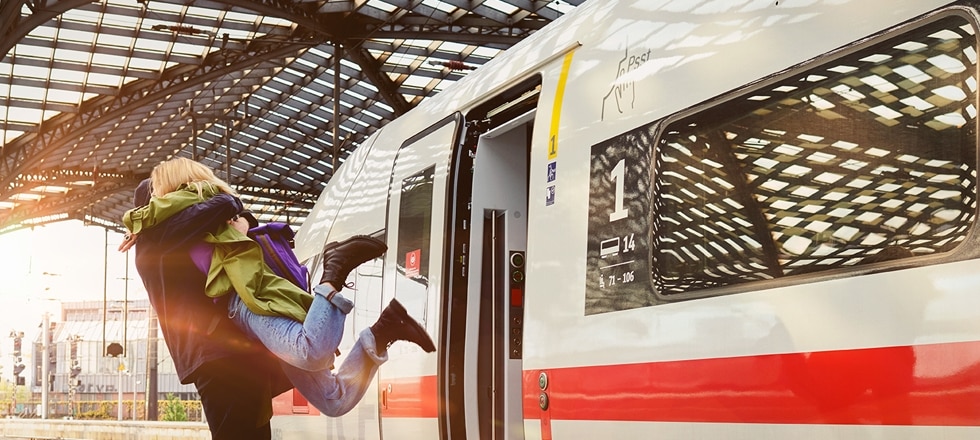
Affordable rail travel
Enjoy low-cost train travel from EUR 17.90 with the super saver fare.
Sie haben in Ihrem Browser JavaScript deaktiviert, dies wird jedoch von unserer Anwendung benötigt. Bitte aktivieren Sie JavaScript in Ihrem Browser.
Cheap Train Tickets | Timetables for Germany & Europe - Deutsche Bahn
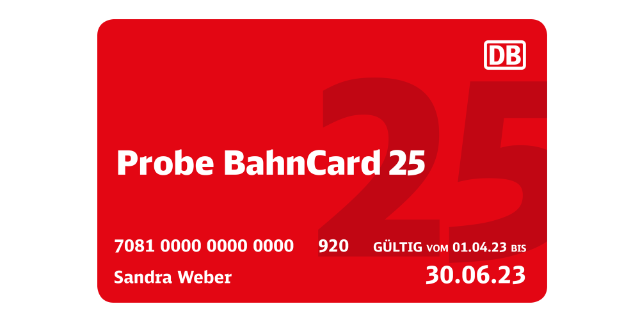
Save 25% for three months
Get the trial BahnCard 25 for three months in a subscription for EUR 17.90 and save 25% on your rail travel.

Travel flexibly with the flexible fare ticket
Relax and enjoy the journey, with no train-specific travel and the ability to make a stopover or travel at a different time.

Interrail: A flat rate for travelling Europe
Discover Europe by train: 33 countries , 1 ticket , 40,000 European destinations to choose from.
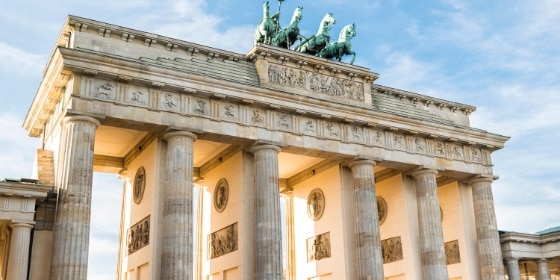
Brandenburg-Berlin-Ticket
Experience the culture and nightlife of the capital city Berlin ! Discover at the same time the nature and charming towns in the surrounding Brandenburg region .

Eurail Pass
- Discover all of Europe
- Valid in over 33 countries
- Valid for those who are NOT residents of Europe/Turkey/Russia

Seat reservation
Reserve your seat online for a relaxed and convenient trip. Enjoy the journey.
Tickets & offers
- Saver and flexible fares
- Regional offers
- Travel pass offers
- Night trains
Booking information
- Exchanges and cancellation
- Passenger rights
- DB Navigator app
- Payment options
Our train fleet
- Long-distance trains such as ICE, IC and EC
- Regional and S-Bahn trains
- Wifi on trains
- Travelling in first class

UEFA EURO 2024™
51 games in 10 cities: Environmentally friendly travel to the games by train.
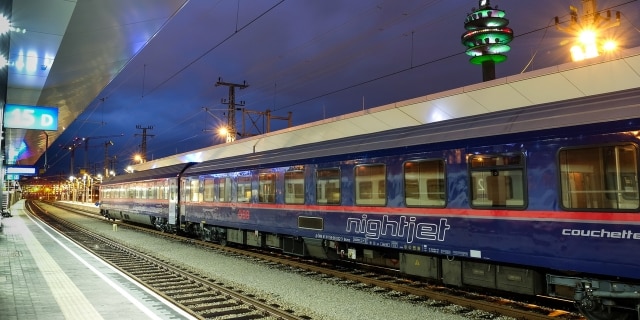
Overnight travel
Enjoy stress-free boarding in the evening and arrive at your destination after a good night’s sleep. Travel to over 25 major European cities like Vienna or Paris.

How to Travel Through Europe by Train Like a Pro
Last Updated on June 8, 2023
Traveling through Europe by train is a wonderful experience that offers a unique and authentic way to explore the continent. It is a cost-effective and sustainable way to travel that gives you a chance to see the breathtaking scenery of Europe.
However, train travel can also be overwhelming for first-timers. That’s why we’ve put together this guide on traveling through Europe by train like a pro.
Make an Itinerary
The first step to traveling through Europe by train like a pro is to plan ahead. Research your destinations and create a rough itinerary of the places you want to visit, as well as the duration of your stay. You can use websites such as Rail Europe or Eurail to plan your train journeys and book tickets in advance. This can save you money, time, and heartache on your adventure!
Buy a Rail Pass
If you plan to take multiple train journeys during your trip, buying a rail pass is worth considering. A rail pass allows you to travel on most trains in Europe without purchasing individual tickets for each journey. Different types of rail passes are available, depending on the length of your trip and the countries you want to visit.
Utilize Nearby Luggage Storage
When traveling through Europe by train, you may find yourself in a situation where you need to store your luggage temporarily. This can happen if you arrive at your destination before your hotel check-in time or want to explore a city without carrying heavy bags.
Fortunately, many train stations in Europe offer luggage storage facilities. For example, if you’re spending the day in St. Pancras, simply look for luggage storage in St. Pancras . Now, you can explore the city with peace of mind — and no heavy bags weighing you down.
Choose Your Train
When traveling through Europe by train , you can take high-speed trains, regional trains, or overnight trains. High-speed trains, such as the Eurostar or TGV, are faster and more expensive than regional trains. However, they are a smart option for longer journeys or days you want to travel between two distant cities in a short amount of time.
Regional trains, on the other hand, are slower but cheaper. They are an option if you want to explore smaller towns and villages along your route. Overnight trains, such as the Nightjet, allow you to save time and money by combining transportation and accommodation.
One of the advantages of traveling through Europe by train is the ability to easily move from one place to another. However, this can be difficult if you are carrying a heavy suitcase. Therefore, it is important to pack light and only bring the essentials. A backpack or a small suitcase is ideal for train travel.
Arrive Early
You should arrive at the train station at least 30 minutes before your train departure time. This allows you to find your platform, check the train timetable, and board the train stress-free. After all, when a train says it leaves at 10:00, you best believe it’ll be on the move promptly at 10:00.
Additionally, arriving early can give you time to grab a coffee or a snack from one of the many cafes at the train station.
Validate Your Ticket
If you have purchased individual train tickets, don’t forget to validate them before boarding the train. You can do this at the yellow validation machines located at the train station. Failure to validate your ticket can result in a fine if you are caught by a ticket inspector on the train.
Keep Your Ticket Handy
Once you have boarded the train, it is important to keep your ticket handy. Ticket inspectors may ask to see your ticket any time during the journey, so it is best to have it easily accessible. Additionally, some trains have a designated area for luggage storage, so be sure to keep your bags in the appropriate area.
Bring Your Own Food
While some trains have dining cars or food carts, it is always a good idea to bring your own food and snacks for the journey. This can save you money and ensure that you have something to eat if the train has no food options or limited options.
Enjoy the Scenery
Last but not least, one of the most important things to remember when traveling through Europe by train is to take the time to enjoy the scenery. Europe is home to some of the world’s most beautiful landscapes and architecture, and traveling by train allows you to see it all from a unique perspective.
Happy Travels!
Traveling through Europe by train is a fantastic experience that offers a unique and authentic way to explore the continent. With these tips, you can travel like a pro and make the most of your journey. Remember to plan ahead, pack light, and most importantly, enjoy the beautiful scenery along the way.
Related posts:
- Why you should travel by train in Europe (and how to book tickets)
- Exploring France by train: Our top five train rides in France
- How to Travel around Europe on the Cheap
- Things to Know Before You Board a Train from Vienna to Prague


COMMENTS
Inter-city train tickets from €12.90. Deutsche Bahn (German Railways) high-speed IC and ICE trains are easily the best way to travel between major town & cities all over Germany, in comfort at ground level. DB's ICE trains travel at up to 186 mph from city centre to city centre, and if you pre-book direct with the operator you can find some ...
Long-Distance Trains. Yes. For high-speed/long-distance trains in Germany, you should book early to get the best price—fares rise as the departure date approaches. For example, a ticket purchased on the day of travel can cost 3x-4x the price as one bought a month or two in advance. These high-speed trains include InterCity Express (ICE), ICE ...
View approximate train travel times between Germany's key cities with high-speed ICE trains. Route. ICE. Berlin to Cologne. arrow-bottom. 4h 30m. Berlin to Frankfurt. arrow-bottom. 4h.
Cologne (Köln), Germany. The magnificent Cologne Cathedral (Kölner Dom) welcomes you when you arrive in Cologne - it lies on the doorstep of the main train station. Reach the top of the South Tower's spiral staircase and be rewarded with a sweeping view over the river Rhine. The nearby Hohenzollern Bridge is covered with love padlocks.
Saver Fare (Sparpreis) - prices for one-way tickets in Germany start from €19 for short distances (up to 250 km). For longer distances prices start at €29 (Second Class) and €49 (First Class) Travel on the ICE is possible. Prices for two people traveling together start at €49 in Second Class.
Local S-Bahn trains link the hauptbahnhofs to city centre locations in Berlin, Frankfurt (Main), Hamburg, Leipzig, Munchen and Stuttgart. The ICE trains travel up to 300 km/h on these high-speed routes: Berlin ↔ Wolfsburg. Seigburg/Bonn ↔ Frankfurt Flughafen. Mannheim ↔ Stuttgart.
Follow your curiosity around up to 33 countries, traveling at your own pace by train. Find your pass. Tour Europe by train. with 1 Pass. Create the itinerary. for your perfect trip. Travel flexibly on trains. that don't need reservations. Stay conscious.
One of the best ways to discover Germany is by train. The German railway system is very well developed and reliable, and you can reach almost every city in Germany by train; not to mention that watching the German landscape stream by your window is a very relaxing and comfortable way of traveling. The German National Railway is called Deutsche ...
Beginner's Guide to Train Travel in Germany. Germany beats like the heart of Europe, at the center of a flowing, intricate web of connections. But this web is built of iron and steel, traversed by a fleet of high-tech trains offering quick, comfortable, and sustainable travel — without breaking the bank. (And without the security lines and ...
Really - it's the dream. And Germany, with its natural beauty and unparalleled efficiency, is the perfect place to plan a journey. Here's what you need to know to get your training plans started. 1. Where can I buy tickets? You can purchase tickets for trains traveling to and around Germany online or in person at the train station.
Two slow-train deals can be a steal: The "day ticket for Germany" gives groups of up to five people unlimited second-class travel on non-express trains for a calendar day (€42 for one traveler, €7 for each cotraveler, can't be used before 9:00 a.m. on weekdays, called the "Quer-durchs-Land Ticket" in German materials).
Night trains in Germany offer a unique and convenient way to travel long distances while combining rest and transportation. Deutsche Bahn used to offer night train services called City Night Line (CNL). But it has been discontinued since 2016. However, you can find other night train providers in Germany.
Rail Passes Almost everyone has heard of the Eurailpass, but Deutsche Bahn also offers a similar rail pass for travel only within Germany called the German Rail Pass. (The German pass also includes some destinations in nearby countries, such as Salzburg, Austria.) One big advantage of having a Eurailpass, Flexipass, Europass, or German Rail Pass, besides any cost savings, is you can avoid ...
Train travel in Germany - train tickets, top routes and destinations. Whether you're just after a quick bit of info about trains in Germany, or you want to know absolutely everything there is to know about travelling by rail in the land of frankfurters, bier gartens and wanderlust, we've got you covered.. Our guide to travelling in Germany by train has been put together for anyone and ...
Day 10: Hamburg. Travel to Hamburg by train (approx. 4 hours) and check into your hotel. Visit the famous Elbphilharmonie, a stunning concert hall with breathtaking views of the city. Explore the historic warehouse district of Speicherstadt and take a boat tour of the canals.
Train travel in Germany is a truly funny and misunderstood thing, shrouded in a romantic cloud of efficiency, speed and scenic bliss. But while German trains are leaps and bounds better than train travel in many countries, it is far from the flawless and simple utopia many of us imagine in our heads.
6. Addressing Challenges. Germany is a vast and beautiful country, criss-crossed by some of the most scenic rail routes in Europe. With mountains, forests, beaches, cities, and towns all accessible by railway, planning an itinerary to explore Germany by train is a great way to get a real sense of the country and travel around at your own pace.
Vacations may also combine train tours with scenic cruising along the Rhine River, past vineyards and the legendary Lorelei Rock, or on the mighty Danube. Select escorted tours even connect multiple countries, such as Germany and Austria, or Germany with Italy, Switzerland or the Czech Republic, while traveling on some of Europe's most iconic ...
This unique train journey never ceases to amaze: soon after leaving the station in Hamburg, the route leads through the quintessential North German marshland landscapes and, shortly after, crosses the North-Ostsee Canal on the Hochdonn High Bridge, at a height of 42 metres! On a clear day, you can gaze all the way to the port facilities of ...
A good way to save on train travel is by purchasing a BahnCard, a railcard that grants discounts on Deutsche Bahn services. There are three types of BahnCard. The BahnCard 25 entitles you to a 25% discount on tickets, whereas the BahnCard 50 gives you a 50% discount and the BahnCard 100 allows for ticket-free travel across Germany.
Itinerary highlights. Beer, castles, and Bavarian culture in Munich; castles and the Rhine Valley Scenic Line; the famous Cologne cathedral; fascinating culture and maritime history in Hamburg; somber history, trendy food, and vibrant nightlife in Berlin. Day 1: Munich Day 2: Heidelberg Day 3: Cologne Days 4 - 5: Hamburg Days 6 - 7: Berlin.
The Ultimate Packing List for Europe: Summer Edition. Train travel in Europe is generally far more comfortable than flying. At the end of the day, traveling Europe by train is immensely more comfortable than flying. There's less hassle, more comfortable seats, more ease of moving around, often better views, and more control over your environment.
Enjoy low-cost train travel from EUR 17.90 with the super saver fare. Super saver fare Super saver fare Cheap Train Tickets | Timetables for Germany & Europe - Deutsche Bahn ... Discover Europe by train: 33 countries, 1 ticket, 40,000 European destinations to choose from.
Buy a Rail Pass. If you plan to take multiple train journeys during your trip, buying a rail pass is worth considering. A rail pass allows you to travel on most trains in Europe without purchasing ...
The fastest trains from Chambéry to Vienne take around 1 hour and 54 minutes, covering a distance of approximately 82 kilometres. On weekdays, the first train leaving Chambéry is scheduled to depart at around 05:44. The last departure is usually at around 20:44 . On Saturdays and Sundays, trains leave Chambéry at around 07:30, with the last ...